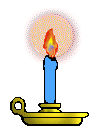

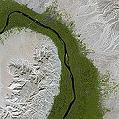


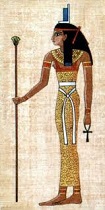


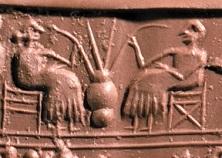
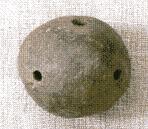

-4000 World pop.: 7M; it now begins doubling every thousand years; pop. of India: 1M. This is the date of Creation according to Sir Isaac Newton. The Neolithic Period ends, and the Chalcolithic Period begins (ends -3500). The sea level, which has been rising since the end of the Ice Age reaches modern-day levels; Mesopotamia develops a rich, fertile delta, and the Near East becomes a wet warm Eden; the Saharan grasslands turn to desert (-3200?); ice cover in the Arctic Ocean is nearly ice-free?; the Alps are ice-free. City-states begin to rise along the banks of the leisurely Euphrates River (Persian "ufratu" = good to cross over, Sumerian for fruitful) and swift Tigris River (Persian "tigra" = pointed, Sumerian "idigna" = swift river), and along the Nile River in Egypt; the Egyptians (Remetch, meaning "people") enjoy a lack of natural enemies, giving them the longest period of political stability in human history; the Nile is neat because it not ony floods once a year and leaves a couple of miles of fertile silt on each bank, but it flows from S to N while the wind always blows from N to S because of the Mediterranean Sea, so that you can sail S and then turn around and float back N with the current. The Amratian Culture (Naqada I) in Upper Egypt around El-Amra begins (until -3.5K), known for mud-brick bldgs., white cross-line pottery, and cosmetic palettes. Migration begins from the Aegean Sea and Anatolia ("sunrise") to the Broken Balkans (Turkish for mountains) and the E Mediterranean. The Michelsberg Culture from the Rhineland settles in Belgium and the Netherlands. The Funnel Breaker Culture, ranging from S Norway to the Czech-Austrian border and from the Ukraine to the Netherlands reaches NW France and England. The Middle Archaic Period in North Am. Archeology ends, and the Late Archaic Period in North Am. Archeology begins (ends -3000). Migrants from Asia settle in islands close to New Guinea. About this time the Salisbury Plain (Gael. "Sulis" = Sun") in SC England becomes the center of a funky Stone Age religious cult with huge burial mounds and graves. The oasis of Ghadames in modern-day NW Libya is first settled. By this time the horse and camel, AKA dromedary ("running") are domesticated in the Middle East, while the llama and alpaca are domesticated in Peru. Farming begins in Ulster. domesticated millet is raised in N China. Domesticated animals incl. pigs, chicken, and dogs are domesticated in China. Barley beer is brewed in Sumeria; it is drunk through straws. Copper is worked in the Balkans and the Fertile Crescent. A temple is built near modern-day Nebelivka, Ukraine. Glazed ceramic Faience is invented in Mesopotamia to imitate lapis lazuli from Afghanistan; the Egyptians later copy the process. In this millennium the jackass is domesticated in Africa (Somalia?). Tombs at Loughcrew in County Meath, Ireland align with the rising Sun at the spring and autumn equinoxes. About this time the Sumerian storm goddess-demon Lilith (Akkadian "Lilitu" = night") is worshiped, becoming known for appearing to men in erotic dreams and having sex with them, although she is sterile and has no milk; she is later claimed to be the mythological real first wife of the Bible's Adam. About this time Ancient Egyptian religion begins, with a vast pantheon of gods who control the forces of Nature, requiring priests to propitiate them, and the pharaoh acting as intermediary between them and the people, causing enormous resources to be dedicated to rituals and temple construction; the Egyptian god Min is first worshipped as the god of reproduction, usually represented as a man holding his erect penis in one hand and a fail in the other - the original cracker? They also worshipped the mutter, er, mother goddess Mut (Maut) (Mout) AKA World Mother, Lady of Heaven, Mother of the Gods, Queen of the Goddesses, Eye of Ra, and She Who Gives Birth But Was Herself Not Born of Any; another early god worshipped by early Egyptians is the lunar deity Yah (Jah) (Iah) (Aah) ("Moon"), which is gradually assimilated into Osiris, god of the dead and Thoth, god of knowledge; origin of the Hebrew god Yahweh?; too bad for modern Christians, Jews, and Muslims, the ancient Egyptians happily lived and died and never worried about being saved by Christ, Moses, or Muhammad. About this time the human race reaches its emotional-intellectual peak, with civilization going on to make it less and less intelligent? About -4000 to -3000 if the Bible's Adam and Eve story is true, giant Nephilim (Heb. "those causing others to fall or fail") inhabit the Earth until Noah's Flood (Gen. Ch. 6); "Now it came about, when men began to multiply on the face of the land, and daughters were born to them, that the sons of God saw that the daughters of men were beautiful; and they took wives for themselves, whomever they chose. Then the LORD said, 'My Spirit shall not strive with man forever, for he is indeed flesh; nevertheless his days shall be one hundred and twenty years.' The Nephilim were on the Earth in those days, and also afterward, when the sons of God came in to the daughters of men, and they bore children to them. Those were the mighty men who were of old, men of renown" - the origin of the Greek gods? Inventions: The Egyptians develop sailing vessels (feluccas) for use near the mouth of the Nile River, along with the Sundial, and Leavened Bread. The Chinese make Cheese and Yogurt using mold. Chiles, originally from Bolivia are used from the Bahamas to Peru, according to Linda Perry of the Smithsonian Nat. Museum of Natural History and Deborah M. Pearsall (1950-) of the U. of Mo. A hard-to-play ocarina-type globular ceramic flute is used for religious purposes near the N Macedonian city of Veles; discovered in 1989.
-3992 The date of Creation according to Johannes Kepler.
-3952 The date of Creation according to the Venerable Bede.
-3949 The date of Creation according to Joseph Justus Scaliger.
-3942 The North Star is Thuban (Alpha Draconis) until -1900; in modern times the two inner stars of the Big Dipper end up pointing to it, while the two outer stars point to the new pole star Polaris.
-3900 The 5.9 Kiloyear Eventbegins (ends -3400), bringing five cents. of colder climate in northernly latitudes, launching the modern dessication of the Sahara and triggering human migration to the Nile River Valley.
-3880 The Rujm el-Hiri("stone heap of the wild cat") mound monument (AKA Gilgal Refaim = "wheel of spirits) on the Golan Heights is built; the central mound is added about -1550.
-3874 Adam ("son of the red earth") (b. -4004) is 130 years old; Cain (Heb. "spear") slays Abel (Gen. 4:8), and utters the immortal soundbyte: "Hashomer akhi anoki" (Am I my brother's keeper?); Adam and Eve's 3rd son Seth (Heb. "substitute") is born, continuing the line leading to Jesus Christ (Luke 3:23-38); sometime later Jubal, son of Lamech and Adah, and brother of Jabal (a descendent of Cain) becomes a musician and/or musical instrument inventor (Gen. 4:19-21).
-3800 The Ubaid Period in Mesopotamia (begun -6500) ends. Iapetus' daughter Anchiale's son Cydnus' son Parthenius (Adam and Eve's 3rd son Seth?) founds the city of Tarsus in S Asia Minor. The 1.8km wooden Sweet Track Walkway modern-day Somerset Levels, England is built about this time.
-3769 Adam (b. -4004) is 235 years old; Enos ("mortal man, sick"), son of Seth (son of Adam) is born.
-3679 Adam (b. -4004) is 325 years old; 90-y.-o. Enos' son Kenan (d. -3591) (Heb. "possession"), son of Enos (grandson of Seth) and his wife-sister Noam is born (Gen. 5:9-14).
-3761 Oct. 7 (Mon.) is the date of creation in the Jewish (Hebrew) Calendar, based on the work of Rabbi Hillel II in the 4th cent. C.E., and called 1 Tishri Anno Mundi 1; according to the Seder Olam of Rabbi Jose (Yose) Ben Halafta of the 2nd cent. C.E., Creation was on 25 Elul Anno Mundo 1 (about 1 year before 1 Tishri), and others place it at 25 Adar Anno Mundi 1 (6 mo. after 1 Tishri); either way, to get the Jewish year for any Gregorian year after 1 C.E., add 3760 unless it's autumn, in which case add 3761.
-3700 Puppis A suddenly appears in the Earth night sky, then slowly dims out of sight. Evidence of domesticated cats in Hierakonpolis, Egypt.
-3650 About this time the Bronze Age Minoan Kingdom (ends -1450) in Crete (Creta) (Candia) (which has a great natural harbor in Suda Bay on the N side but is inaccessible to shipping on the S side) is founded by (legendary?) king Minos (son of Zeus and Europa, who ends up as a judge of the dead in Hades?), known for (90?) well-planned towns with skilled craftsmen, and producing ships that go on trade journeys to the coasts of Europe; in 2013 the Minoans are traced to Crete; their bull-worshiping religion uses bull's head rhytons for pouring yummy libations to their gods; a favorite sport is bull-hopping (flipping onto a charging bull's back via the horns).
-3641 Feb. 10 is the date of creation in the Mayan Calendar.
-3609 Adam (b. -4004) is 395 years old; Kenan's son Mahalalel (Mahalaleel) (d. -2714) is born (Gen. 5:12-17).


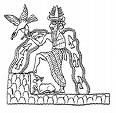
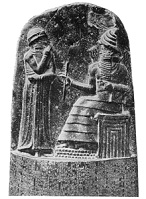
-3600 From this year to the year 1990 C.E. (5,555 years) there are a total of 14,531 known wars that kill 3.64B people, and only 292 years of peace? :) About this time (-5000 to -4000?) the Ubaidian people found the civilization of Sumer (Ki-engir) (Shumerum) in Mesopotamia along the Lower Euphrates River in modern-day S Iraq (ends -1900), becoming the first civilization in the region, complete with writing ca. -3200; the chief cities are Eridu (Eridug) ("Sum. "mighty place) (home of Enki) (oldest city on Earth?), Adab (modern-day Bismya), Isin, Kish Island (in the Persian Gulf), Kullab, Lagash, Larsa, Nippur (on the Euphrates River), and Ur (at the mouth of the Euphrates River), which becomes a city-state ca. -2600; they worship the triad of Baal (Bel) (Sum. "lord") (AKA Beelzebub), Anu (An) (Sum. "sky", "heaven") (king of the gods, spirits, demons, and constellations), and Enki (Ea) (Sum. "lord of the Earth") (lord of water and intellect, associated with the Square of Pegasus S band of constellations), depicted with the head of a man on the body of a fish, dwelling in the nether sea of Apsu; also the Moon good Sin (Nanna) (son of Enlil and Ninlil), his son Shamash (Utu), god of the Sun and justice, and Anu's descendants the Anunnaki (Anunaki) (Ananaki) (Anunna) (they are really aliens from outer space who created humans and domestic animals via genetic engineering?); the four elements of heaven, earth, air, and water were created by the utterance of the divine word, and man was fashioned of clay, and created to serve the gods with food, drink, and shelter so that they can live in leisure; they leave hundreds of thousands of cuneiform script clay tablets incl. "The Epic of Gilgamesh", some with cylinder seals (signatures). The Gerzeh (Girza) (Jirzah) (Naqada II) predynastic Egyptian culture along the W bank of the Nile River E of Al Fayyum begins (until -3.2K), known for pottery featuring stylized animals incl. ostriches, and large tombs. A Bronze Age culture begins in Ban Chiang near Udon in NE Thailand, becoming the first Bronze Age culture, known for handsome red-painted pottery; discovered in 1966. A relict pop. of Woolly mammoths on St. Paul Island in the Bering Sea becomes extinct. The tall, long-necked Tutsi set up a monarchy in Rwanda, intermixing with Bantu peoples. The first aborigines move into California. Megaliths are constructed in Malta, becoming the oldest known free-structures on Earth until the discovery of Gobekli Tepe. The first use of iron by Egptians is in making jewelry from meteorites at Gerzeh 40 mi. S of Cairo.
-3544 Adam (b. -4004) is 460 years old; Mahalalel is 65 years old; his son (by Dinah?) Jared (Jered) (d. -2582) (Heb. "descend") (Gen. 5:15) is born.

-3500 European climate reaches a temperature max, and begins a downward turn for the next 5K years; the Sahara region begins to expand beyond its original boundaries; the sea level around Britain reaches its maximum since the last Ice Age. The Chalcolithic Period (begun -4.5K) ends, and the Early Bronze Period of archaeology begins (-3300?) (ends -2100), featuring the Jemdet Nasr Culture in Sumeria (-3100 to -2900), which incl. clay tablets with economic texts, the use of bronze, and extensive overseas trade; the ziggurat ("built on a raised area") stepped pyramidal mud brick tower with rectangular shrine on top, and cylinder seal (which can be rolled over a clay tablet to reveal a scene) are developed; Predynastic Egypt is stimulated by the Mesopotamian culture, and the cultures of Nubia and Egypt begin to diverge. The Phoenician city of Gath is settled, becoming the home of Goliath in the Bible. The earliest Chinese cities are founded. About this time (-2750?) (-2500?) the Saqqaqs migrate from Siberia to Greenland (until -500), but aren't ancestors of modern-day Inuits or Native Ams. About this time the village of Maadi ("the ferries") on the E bank of the Nile River 9 mi. S of modern-day Cairo is founded as a trade center at the end of the overland trade route to Palestine; in modern times it because a leafy upscale neighborhood popular with diplomats, and home of Cairo Am. College and the Egyptian supreme court, with no bridge across the Nile. Armageddon town Megiddo on the plain of Esdraelon is founded. The city of Troy in NW Asia Minor is founded? Cotton is cultivated in the Nanchoc Valley of N Peru. The Duzdagi Salt Deposits in the Araxes Valley in Azerbaijan are intensively mined for salt. About this time the Mesopotamians discover bronze. The oldest known wheel is used on vehicles in Sumeria and Syria. The potter's wheel is developed in the Middle East. Gold mining is pioneered in Mesopotamia and Africa. The harp is first used in Sumer (Ur), along with the lyre, spreading to Egypt by -3000. The first tall 4-sided narrow tapering Egyptian obelisks (tekhenu) (Gr. "obelos" = pointed pillar) are constructed, with a pyramidion on top; they represent Osiris' erect phallus? Megalithic tombs are constructed in NW Europe. The oldest known leather shoe comes from Armenia, complete with leather eyelets and laces.
-3400 About this time the Gebelein predynastic mummies near Gebelein (modern-day Naga el-Gherira), Egypt are buried, and excavated in the 1890s C.E. by Wallis Budge of the British Museum; natural mummication caused by the hot Sun gave the Egyptians ideas, but it takes until -2600 for the Egyptians to practice true mummification. The opium poppy is cultivated in lower Mesopotamia - set the Time Machine lower limit here please?
-3382 Adam (b. -4004) is a hefty 622 years old; Big-Eyed Goldberg, er, Righteous Enoch (d. -3017) (Heb. "dedicated") (d. -3039?) ("seventh in line from Adam"), son of Jared and father of Methuselah is born, and his example of "walking with the true God" condemns sinner Adam (Gen. chs. 4-5, Jude 14).
-3317 Adam (b. -4004) is 687 years old; Enoch (b. -3382) is 65 years old; birth of longevity champ (969 years) Methuselah (Metuschelach) (Heb. "man of the dart", "when he dies it will be sent", "man of Babylonian god Shelah") (d. -2392), son of Enoch, and father of Lamech, father of Noah (Gen. 5:21-7).
-3300 By this time Egypt is organized into the two kingdoms of Upper and Lower Egypt. A Chalcolithic culture settlement in Harappa in Punjab, E Pakistan (Land of Five Rivers) (named after the Ravi River) in the Indus Valley contains evidence of connection between Indian and Sumerian cultures; a main city is Dholavira, which is abandoned then reoccupied until ca. -1450, when the river dries up and the Meghalayan Drought (begun -2200) forces them to move. Otzi (Ötzi) is dug up on the Tisenjoch Pass of the Otzal Alps in N Italy in Sept. 1991, complete with yew longbow, chamois quiver with 14 arrows, a copper axe, and a flint-bladed dagger in a woven sheath. Evidence of domesticated cats in N China. The earliest known example of writing is in Mesopotamia? The first Hieroglyphs appear on labels and pottery in Egypt, along with the first scrolls of Papyrus.
-3250 The Great Shock of 3250 B.C.E. begins 1K years of wet stormy weather (ends -1500). Isolated Egypt begins trading with Mesopotamia, which influences them in architectural techniques, materials, and writing.
-3228 The advent of Radha and Krishna, the pinnacle of service and pleasure, and the supreme enchanter.


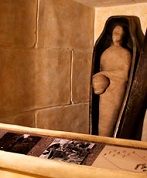

-3200 A major world warming event turns the habitable Sahara region into a desert and causes peoples in Edenic settings such as the Fertile Crescent to resort to irrigation; Quelccaya Ice Cap in the Andes Mts. of Peru is formed; Alpine man Oetzi (Ötzi) is trapped in a glacier in Ötztal Alps on the Austrian–Italian border, and found by hikers in 1991 C.E.; he has leather shoes with bearskin soles, deerskin panels, tree bark netting, and grass socks, becoming the oldest known natural human mummy, and oldest known person with a tattoo. About this time the Scorpion King I rules in Thinis in Upper Egypt, during which the Naqada III culture begins (until -3,150); meanwhile Scorpion King II (Selk or Weha?) rules in Nekhen in Upper Egypt - he's bragging? A system of city-states develops in Mesopotamia; several hundred Sumerian cuneiform clay tablets are inscribed with writing (economic documents) in Uruk; the first known tablet is a limestone tablet from Kish. Egyptians and Mesopotamians develop sail-powered boats. About this time pottery is left on the Ophel (hill) in the oldest part of future Jerusalem. About this time a bronze tablet with a carved face of a women is made, found at El-Ahwat near Katzir in C Israel, part of a wheel linchpin for a battle chariot; is this Harosheth Haggoyim, home town of Sisera, as in Judges chs. 4-5? A child's grave in Egypt contains objects used for a crude form of bowling, as discovered in 1930 by Sir William Matthew Flanders Petrie (1853-1942). About this time the 200K-ton Newgrange Tomb in County Meath, Ireland is built; each winter solstice the Sun shines through an opening above the entrance for about 15 min., illuminating a 60-ft.-long passage; discovered in 1699 C.E. Wheeled vehicles are used in Uruk. Stone circles (henges) are built in NW Europe. Pottery is made in Ecuador.
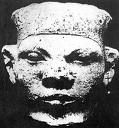
-3150 About this year King Narmer (Catfish) (AKA Menes) of the Thinite Confederacy becomes the first king to unite Upper and Lower Egypt, becoming the first to use the title of pharaoh ("great house"), founding the Egyptian First Dynasty (ends -2909), and the Early Dynastic Period (ends -2686), with capital at Thinis (This) (Tjenu) (near Abydos?); he goes on to build the city of Memphis at the apex of the Nile Delta in Lower Egypt, and improves and enlarges the site by constructing a dam to divert the Nile River, beginning the basin system of agriculture in the Nile Valley; Memphis becomes the center of worship of Ptah, the god of creation; the city of Sais on the upper W side of the Nile Delta is an important cult center; all the pharaohs of this dynasty have retainers sacrified and buried near their tombs, along with animals in Abydos (Abdju); in succeeding dynasties the humans are replaced by ushabtis (figurines); the earliest depiction of a sailboat (made of bundled papyrus reeds) dates to this dynasty - catfish beats scorpion? The first temples are built in Tarxien, Malta.
-3130 Adam (b. -4004) is 874 years old; Enoch (b. -3382) is 252 years old; Methuselah (b. 3317) is 187 years old; birth of Methuselah's son Lamech (Gen. 5:25).
-3125 The first wine discovered in Egypt in modern times is produced in Jordan and buried in the Scorpion King's tomb.
-3114 Aug. 13 is the moment of the fourth creation in the Mayan Calendar.
-3113 This year marks year zero in the Mayan Calendar.
-3125 The first wine in Egypt, buried in the Scorpion King's tomb dates to about this time.
-3114 On Aug. 12 the current Mesoamerican Calendar Cycle (5th Sun) begins.
-3100 About this time Narmer's son Aha (Hor-Aha) (Horus-Aha) becomes king #2 of the Egyptian First Dynasty, enjoying a long reign. About this time Skara Brae stone village in the Orkneys is built. By this year there are about 40 stable agricultural communities on the Nile, which always floods in Sept. and recedes by the end of Nov., and doesn't need ploughing or hoeing to produce crops. Antigua (Sp. "Ancient") in the Leeward Islands is first settled. Hieratic script, a cursive form of hieroglypics written with a blunt reed pen on papyrus is invented in Egypt about this time, but doesn't become common for six cents. (-2500). About this time Kali Yoga is founded. The earliest known chemical evidence of barley beer (along with wine) is in Level V of Godin Tepe in the Zagros Mts. of W Iran. Board game pieces are manufactured in Basur Hoyuk in SE Turkey.
-3074 Enoch (b. -3382) is 308 years old; death of Adam (b. -4004) at age 930 (Gen. 5:5).
-3050 About this time the climate of North Am., along with vegetation cover and sea levels achieve modern levels.
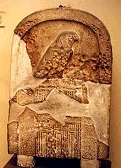
-3049 Djer becomes king #3 of the Egyptian First Dynasty, and rules 41 years; 338 people are buried with him.
-3017 365-y.-o. Enoch (b. -3382) is transferred by Jehovah to ? (Gen. 5:24, Jude 14).

-3008 Djet (Zet) (Wadj) (Euadji) ("Serpent of Horus") (Uenephes?) (Atothis?) becomes king #4 of the Egyptian First Dynasty (until -2998), carrying on intense trade with Syria and Palestine, incl. pottery.

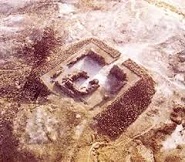


-3000 World pop.: 14M; Syria-Palestine: 250K - wild and crazy guys? The pop. of North Am. peaks, and stays constant until the arrival of Europeans in 1492 C.E., when it halves, then rebounds. The African Human Period (begun -9K) ends. The hunter-gatherer lifestyle dies out in C Europe after coexisting with farming for 2K years. About this time Ireland is inhabited by Neolithic farmers originally from Anatolia, who leave stone circles, dolmens, and great monuments in the Boyne Valley. The Delaware and Chesapeake Bays are formed. About this time post-Deluge king Etana of Kish, "the shepherd who ascended to heaven and consolidated all the foreign countries", "the man who stabilized all the lands" founds the Early Dynastic I Period (ends -2800) (-2900 to -2700?) in Sumeria (Ki-engir) in the S Fertile Crescent, becoming the first high civilization, with temple communities controlled by Sumerian priest-bureaucrats pandering kinder-gentler Sumerian gods, led by Enlil ("lord of the wind"); chariots first appear in Sumer; the Sumerian King List names eight antediluvian kings reigning for tens of thousands of years; the Royal Tombs of Ur contain the graves of Meskalamdug and Akalamdug. About this time the non-Semitic Elamites, with capital at Susa in SW Iran begin a long conflict with Sumer in the S Fertile Crescent and Akkad in the N Fertile Crescent - the original Sunni-Shiite civil war? About this time the city of Konya is first settled, going on to be controlled by the Hittites around 1,500 B.CE.., followed by the Sea Peoples around 1,200 B.C.E., and the Phrygians around 800 B.C.E., who call it Iconium, "the last city of Phrygia" (Xenophon); in 690 B.C.E. it is taken by the Cimmerians, and is absorbed into the Persian Empire until Macedonian king Alexander the Great captures it in 333 B.C.E., after which Seleucus I Nicator and the kings of Pergamon rule it until its last king Attalus III gives it to the Romans, who incorporate it into the Roman Empire under Emperor Claudius, who renames it Claudiconium; in 1084 C.E. the Seljuks conquer it, making it the capital of the Seljuk sultanate of Rum in 1097-1243. About this time the licentious Baal, Ashtoreth, and Car (Moon godess) worshiping Semitic Phoenicians (Phenicians) (Kena'ani or Canaanites = "merchants") (Gr. "phoinix" = red-purple) settle the E Mediterranean coast, a long narrow (5 to 15. mi.) strip of land from the Orontes River or Eleutherus River in the N to Mt. Carmel in the S, bounded on the E by the Lebanon Mts.; they worship the Moon because it rules the tides, and they want to rule the seas?; the city-states of Arvad (Arwad) (Rouade), Gubal (Djebeil) (Byblos), Marathus, Ecdippa, Acco (Akko) (Acre), Simyra (Sumra) (Tell Kazel), Dor (Dora) (southernmost), Zarephath (Sarafind) (Sarepta), Tripolis (Tripoli), Berytus (Beirut) and Sidon (Saida) (25 mi. S of Beirut) (first mentioned in the 15th cent. B.C.E. Tell el Amarna Letters), and Tyre (Sur) (Zor) ("rock") (from a double rock off the coast) ("daughter of Sidon") (50 mi. S of Beirut) are founded - white sidewall tire below the root? In this millennium the Bell-Beaker (Strijdhamer) (Standvoetbeker) Culture (who make pot-shaped upside down bells) arises in Iberia, bringing bronzemaking to backward white Europe incl. the Netherlands, Denmark, and S Scandinavia. About this time the Neolithic Age begins in S India (ends -1400). People in Xincun, China practice agriculture before the arrival of domesticated rice. About this time irrigation is developed in Nubia (modern-day Sudan), using the flood waters of the Nile River with a waterwheel-like device called the sakia. About this time the Bouar Megaliths, about 70 groups of megaliths are built in W Central African Repub. (CAR). About this time the Ness of Brodgar, 100+ Stone Age bldgs. are built in Orkney, becoming the center of British Neolithic culture, more important than Stonehenge? About this time the earliest known fountain is located in Mesopotamia, consisting of a series of basins fed by a natural spring, which is later copied by the Greeks and Romans. About this time the great stone circle Callanish Stones on the Isle of Lewis in the Outer Hebrides of Scotland are built, along with the Stenness Stones, aligned to the movements of the Sun and Moon. The Map Stones of Bornholm Island in Denmark are maps of local fields, fences, and plants?; found in June 2016. About this time Lothagan North Pillar Monumental Cemetery is built Lake Turkana in modern-day Kenya, becoming the earliest and largest in E Africa. The earliest known milk protein is found on human teeth in Mongolia. By this time turmeric, cardamom, black pepper and mustard are being harvested in India. About this time the Caucasian Hattians settle C Asia Minor (Anatolia), with capital at Hatti (modern-day Bogazkoy or Hattushash in Cappadocia) 150 mi. S of Sinop, worshiping the Sun goddess Wurusemu and the storm god Taru. About this time the Egyptians build two temples to ibis-headed Thoth ("he who is like the ibis") (god of wisdom and inventor of writing, the heart and tongue of Ra, whose curved beak represents the crescent Moon) on Thoth Hill in W Thebes; he is sometimes portrayed with a baboon head instead. The Celts begin fighting for their free-ee-ee-dom? About this time the Celts (from the Greek word Keltoi, meaning hidden people), a fusion of Mediterranean, Alpine, and Nordic strains, incl. a dark Iberian and a blonde stock, and known, like Slavs, for big beards (compared to Chinese who have stubble beards, Ethiopians who have curly beards, and Am. aborigines, who are bare-faced) appear in N Europe; their Indo-European Gaelic Language drops the p sound in the initial or medial position (Lat. porcus becomes Gael. orc); they eventually form more than 150 distinct tribes, incl. the Britons in Britain, the Gauls in France, and the Goidels (Gaels) (Gael. "gwyddel" = savages) in Ireland, Scotland, and the Isle of Man; Goidelic Gaelic splits from Brythonic Galic by preserving the hard c sound, which turns into p in Brythonic (Irish mac becomes Welsh map); they practice the Druid Religion (Gr. "drus" = oak tree), which worships trees (rowans), practices magical ceremonies, and believes in the Sun god Belenus (Beli Mawr) ("the shining one"), the goddess of victory Andraste (Andrasta) (Andred), tree genies, Earth gods, and elfin demons; they fail to develop a written lit., relying on oral transmission by bards, filid (poets), scelaige (narrators), and entertainers; although they have no alphabet, symbols they use incl. the cross, swastika (fylfot), and trefoil (trivet), plus the colors and weaves later used in Scottish tartans; the Britons are cannibals; the social org. is tribal and clannish, preventing consolidation into a central govt., which proves their weakness and undoing? The San Huang (Three Emperors) (Three Sovereigns and Five Emperors) Dynasty is founded, ruling China for the next three cents.; the earliest known silk comes from Henan about this time? Hunter-gatherers inhabit the Japanese islands, and make pottery. About this time the earliest known industrial scale brewery is built in Abydos, Egypt. Beer is paid to workers in Uruk, Sumer as wages, about 4-5l/day. The Kushites (Cushites) enter the interior of E Africa in this millennium, raising cattle and grain. About this time the Malays from S Indochina settle in Indonesia, and Austronesians migrate to the Philippines. The city of Rhagae (Rhages) (Rages) (Rai) (called Europus by the Greeks) is founded by the Medes 5 mi. SE of modern-day Tehran in N Iran, becoming the capital of the Median Empire and going on to become one of the great cities of antiquity along with Nineveh and Ecbatana. Cairns and portal tombs are built in N Ireland. The Late Archaic Period in North Am. ends. Olives, grapes, and grains are cultivated in the Aegean islands. Sheep, cattle, and water buffalo are domesticated in China. Glassmaking originates in Mesopotamia about this time. Ma Huang, containing Ephedrine, closely resembling amphetamine is used by Chinese doctors. The people of Tehuacan, Mexico cultivate maize. The Iceman lives in the Austria-Italy border region (discovered in Sept. 1991). The earliest writing in China is in the E province of Zhejiang. The Hanshan Jade is carved with a design akin to modern Feng Shui compasses. Nearly 75% of human gene mutations occur from this time forward. A 20-y.-o. woman in a farming community in Gokhem, Sweden supplies the oldest known sample of plague bacteria. Inventions: Draft oxen and the Potter's Wheel are used in Mesopotamia. Beeswax Candles begin to be used in ?. Nail Polish is invented in China. The first permanent copper shaving razors appear in Egypt and India. The Dust Abacus is invented, probably in Babylonia. The board game of Senet (ancestor of backgammon) is invented in Egypt.

-2998 Djet dies, and his sister-wife Merneith (Meritneith) (Meryt-Neith) ("Beloved by Neith") becomes king #5 of the Egyptian First Dynasty as regent for their son Den, becoming the first pharaoh of ancient Egypt.
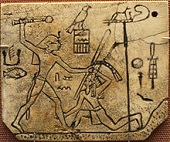
-2970 Merneith's son Den (Hor-Den) (Denen) (Udimu) reaches the age of majority and becomes king #6 of the Egyptian First Dynasty, ruling 42 years (until -2928), becoming the first to use the title "King of Lower and Upper Egypt" and the first depicted wearing the red-white double crown, establishing many patterns of court ritual and royalty and being held in high esteem by his immediate successors; his tomb in Umm el-Qa'ab (near Abydos) has a red-black granite floor, becoming the first hard stone used as building material in Egypt. About this time unsealed wine jars are buried in Queen Merneith's tomb.
-2968 The Chinese discover ink.
-2953 Fu Xi Shi (d. -2852) becomes the first San Huang emperor of China.
-2948 Adam would have been 1,056 years old if he hadn't done that no no in Eden; Methuselah (b. -3317) is 369 years old; birth of Noah (d. -1998) (Heb. "comfort", "rest") (Gen. 5:28-29), 10 generations from Adam; the Flood is 600 years ahead, and Abraham is 952 years (another 10 generations) ahead (-1996); the meaning of the names of Adam and his descendants all the way to Jesus make a coherent prophecy, starting with "The God-man is appointed, a mortal man of sorrow is born, the glory of God shall come down from heaven and teach men that by means of his death he shall bring rest and comfort to those who mourn." (Adam to Noah)
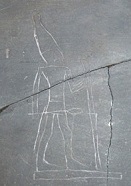
-2928 Den dies, and his son Anedjib (Hor-Anedjib) (Adjib) (Hor-Adjib) (Enezib) becomes king #7 of the Egyptian First Dynsty, ruling 10 years (until -2918).

-2918 Anedjib dies, and his son Smerkhet ("companion of the divine community") becomes king #8 of the Egyptian First Dynasty, ruling only 8.5 years (until -2909) after a great pestilence strikes his kingdom.

-2909 Semerkhet dies, and his son Qa'a (Ka'a) becomes king #9 (last) of the Egyptian First Dynasty, ruling for 33 years (until -2876); too bad, a dynastic war begins after his death, with Horus Bird and Sneferka fighting for power until Hot and Sexy wins.
-2900 About this time the Early Helladic Period of Greece begins (ends 2000 B.C.E.), with prosperity caused by the use of metals along with growth in technology, economy, and social org. The SW (Elamite) Persians begin using a hieroglyphic Proto-Elamite Script. About this time the Chinese domesticate the wild boar, A gay caveman is buried near modern-day Prague, Czech. in a way normally reserved for women. Science: Sus cristatus - and Jews say nooo-thanks, alright? Egyptian doctors a drill hole in the lower jaw to drain an abcessed tooth - the first dentists?
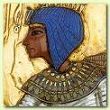
-2890 Hotepsekhemwy ("the two powers are reconciled") becomes king #1 of the Egyptian Second Dynasty (ends -2672), with capital at Thinis (This) (Tjenu) (near Abydos) (modern-day Girga), going on to rule 29 years (until -2861).
-2879 The legendary founding of the feudal Van Lang Kingdom in the Red River Delta of Vietnam by the first Hung Vuong (Hung King) (ends -258); the pop. consists of the Chams, a Caucasoid people from India who end up as Muslims.
-2861 Nebra (Raneb) ("lord of the Sun of Horus") (Weneg?) becomes king #2 of the Egyptian Second Dynasty, reigning 14 years (until -2847).

-2852 Fu Xi decrees the use of surnames (family names), causing each Chinese person to have three names, the surname listed first and coming from one of the 438 words in the sacred poem Po-Chia-Hsing, then the generation name taken from a poem of 30 characters adopted by each family, followed by the given name; Fu Xi dies, and Shen Nong (Nung) Shi (Yan Di) (d. -2737) becomes San Huang emperor #2, the alleged father of Chinese agriculture and first herbal doctor, writing Shen Nong's Herbal Classic, the first Chinese herbal, declaring the five sacred plants to be rice, wheat, barley, millet, and soybeans.
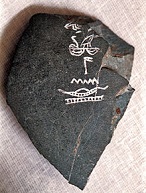
-2847 Nynetjer (Ninetjer) (Banetjer) becomes king #3 of the Egyptian Second Dynasty, reigning 45 years (until -2802).
-2807 On May 10 a total scolar eclipse mentioned by several ancient flood myths indicates a meteor impact in the Indian Ocean, according to Am. archeologist Bruce Masse.

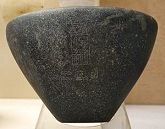
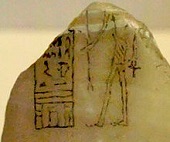

-2802 Senedj (Sened) (Sethenes) becomes king #4 of the Egyptian Second Dynsty, ruling unknown years, after which king #5 Seth-Peribsen (Perabsen) (Ash-Peribsen) and king #6 Sekhemib-Perenmaat (Sekhemib) rule for unknown years while the War between Seth and Horus (worshippers) rocks the nation, and Seth wins, after which in -2690 Khasekhemy (Kasekhemui) ("the two powerful ones appear") becomes king #7 (last) of the Egyptian Second Dynasty, ruling for 18 years (until -2672), leaving the 14 brick-enclosed plank-and-rope Abydos Boats (discovered in 2000 C.E.) along with the mud brick Shunet ez-Zebib funeral structure, marking the start of the Egyptian belief in the afterlife being a place to take their stuff and live forever?


-2800 About this time the Early Dynastic II Period begins in Sumeria (ends -2550), which according to the Sumerian King Lists begins after the Great Flood of Utnapishtim in Shuruppak (described in the Gilgamesh Epic), starting with the First Dynasty of Kish (ends -2700?); the Sumerian word for king is lu-gal ("big man"); Sumerian king Ziusudra ("long-lived") of Shuruppak saves livestock stuck on a barge on a hill in the great flood of the Euphrates River, and makes a sacrifice to his god; about this time the Instructions of Shuruppak is written, becoming the oldest known work of literature to survive to modern times; "In those days, in those far remote times, in those nights, in this faraway nights, in those years, in those far remote years"; "You should not play around with a married young woman: the slander could be serious"; "You should not make a well in your field: people will cause damage on it for you." About this time the Uruk (Erech) Dynasty way S of Kish based in the city of Ur ("Aur" = light) is founded by Meskiaggasher after Etana dies, ruling from the Mediterranean to the Zagros Mts., and becoming the rival of Kish; Meskiaggasher's son Enmerkar attacks neighboring Aratta (NE of Mesopotamia) to capture its art treasures, taking along his eight sons; youngest son Lugalbanda is left behind in the remote mountains and falls ill, and receives help from the Anzu bird, who helps him reuinite with his father, going on to become king; the army of Aratta keeps them at bay for more than a year because their god is punishing them; the whole Epic Cycle of Enmerkar and Lugalbanda is described in cuneiform tablets. About this time the Qa'a Stele is erected at the burial site of Egyptian king Qa'a in Abydos, the cult center for Osiris, the original resurrected Christ with a paradise called the Field of Reeds, but also a hell with 42 demons? About this time (-3000 to -2200?) construction (by Celts or just Stone Age Sun-Moon worshipers?) of Stonehenge begins (ends -1800) on the Salisbury Plain in Wiltshire, S England near the Avon River 2 mi. W of modern-day Amesbury, starting with a circular earth bank and ditch (ca. -3100), followed by a wooden henge (ring of posts), which is replaced 50 years later by a network of stone posts forming a roofed circular temple, becoming the largest cemetery in Britain (cremations); the pillars support a raised platform used to get closer to the heavens?; the first bluestones are erected in -2400 to -2200 (-3000?); it was first built 500 years earlier in Wales?; two of the largest stones were already there for millions of years?; in 2020 20 shafts are discovered in Durrington 2 mi. away. About this time Fah Shen-Chih pub. a text on farming, listing the Five Sacred Chinese Grains, soybeans, rice, wheat, proso millet, and foxtail millet.
-2772 The 365-day calendar is introduced in Egypt.

-2737 Tea is allegedly discovered when some leaves accidentally blow into Chinese emperor Shen Nong's pot of boiling water; hen Nong dies, and Sui Ren Shi (d. -2697) becomes San Huang emperor #3, the alleged inventor of Chinese cooking along with Shen Nong.
-2714 Mahalalel (b. -3609) dies at age 895.

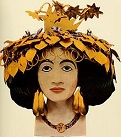

-2700 In this cent. the non-Semitic matrilinear succession ("son of a sister") kingdom of Elam at the head of the Persian Gulf E of Babylonia is founded, with the capital at Susa, and prominent cities Awan, Anshan, and Simash. The First Dynasty of Kish ends with king Enmebaragesi, who rules after the end of Lugalbanda's reign and becomes the leading ruler of Sumer, and "carried off the arms of the land of Elam as booty"; he builds the Temple of Enlil in Nippur, making it the spiritual center of Sumer; his son Agga (last ruler of the Etana dynasty) is defeated by Mesannepadda, founder of the First Dynasty of Uruk (Ur), based in the city of Ur, whose successor Gilgamesh becomes a legendary hero; Queen Puabi (Nin-Puabi) (Akkadian "word of my father") (AKA Shubad), a Semitic Akkadian becomes an important figure among the Sumerians. About this time the First Dynasty of Mari and the First Dynasty of Awan (Elam) (ends -2550?) flourish in Mesopotamia. Grakliani Hill in Georgia has written inscriptions on a fertility goddess altar. Inventions: About this time the Sumerians invent the Abacus, followed by the Persians in -600, the Greeks in -500, and the Chinese in -200; the earliest known abacus dates to -300, the Salamis Tablet, discovered on the Greek island of Salamis in 1846.
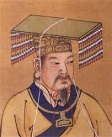
-2697 Sui Ren Shi dies; beginning of the reign of Huang Di (Ti) (Gongsun) (Xuan Yuan Shi) (d. -2597), AKA the Yellow Emperor, who allegedly founds the nation of China; he makes his capital at You Xiong; he orders his officer Can Ji to create Chinese Characters (kanji).
-2691 Radiocarbon dating of 211 plants released in 2010 C.E. by the U. of Oxford and U. of Cranfield gives this year as the beginning of Pharaoh Djoser's reign.

-2686 Khasekhemwy (Khasekhemui) ("the two powerful ones appear") becomes king #5 of Egypt's Second Dynasty, uniting Upper and Lower Egypt.
-2680 The Partholon (Partholón) (Parthalán) settle in Ireland 300 years after Noah's Food, multiply from 1K to 4K, then all die of plague in a single week.

-2670 The Egyptian Third Dynasty is founded after a civil war by Zanakht (Sanakhte) (Nebka) (d. -2630); the Old Kingdom (Age of the Pyramids) (3rd through 6th Dynasties) begins (ends -2200), worshiping the Ogdoad (Gr. "8-fold") of eight deities in Hermopolis, made of of four male-female pairs, with the males associated with frogs and the females with snakes, incl. Nu and Naunet, Amun and Amaunet, Kuk and Kauket, Huh and Hauhet.
-2665 The earliest known yew longbow is made in Somerset, England.
-2640 Chinese Empress Hsi-ling Chi (Shi) discovers Sericulture after a cocoon falls from a mulberry tree into her tea cup, and it unravels as she tries to remove it; divulging the secret of sericulture becomes a treasonable death penalty offense, and the Chinese monopoly eventually makes it worth its weight in gold; the best silk comes from Bombyx mori moths, which each lay up to 500 pinhead-sized eggs, which hatch in 20 days, and begin munching mulberry leaves, growing 70X in 18 days after shedding their skin 4X and increasing their weight by 10KX; they then begin spinning, secreting double strands of fibroin coated with gumlike sericin before coming out of the spinneret at the rate of 10-15 in. per min., or up to 1 mi. in 48 hours; it takes 100 cocoons to make a silk scarf, 140 to make a tie, and 9K to make a kimono - ooh, bite your tongue? Chinese royal astronomers Hsi and Ho are executed for dereliction of duty when they get drunk and fail to predict a solar eclipse; luckily, the dragon eating the Sun gets his fill and departs, even though the required noisemakers with gongs are not assembled to drive it away. A rival to Stonhenge 2 mi. to the NE is suddenly discontinued.
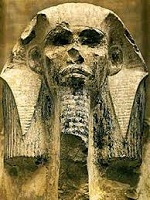

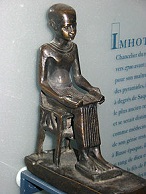
-2630 Zanakht dies, and his younger brother Djoser (Zoser) (Netjerykhet = "divine of body") (d. -2610) becomes king #2 of Egypt's Third Dynasty, ruling for 29 years, building the Step Pyramid in Saqqara 12 mi. S of modern-day Cairo, becoming the first pyramid in Egypt, launching the Age of the Pyramids (3rd thru 6th Dynasties, AKA the Old Kingdom) (ends -2200); Djoser's painted limestone statue in Saqqara becomes the oldest life-sized Egyptian statue to survive to modern times; chancellor Imhotep ("one who comes in peace"), architect of the Step Pyramid and high priest of Ra in Heliopolis thrives during the Third Dynasty at the court of King Djoser, later becoming the center of a cult in Memphis in the 30th Dynasty (380-343 B.C.E.), worshiped as the "god of medicine" and "prince of peace", becoming the only Egyptian commoner to be deified after his death other than Amenhotep, son of Hapu.

-2610 Djoser dies, and his son Sekhemkhet (Djoser Teti) becomes king #3 of Egypt's Third Dynasty, rulng for seven years.

-2603 Sekhemkht dies, and Khaba (d. -2599) becomes king #4 of Egypt's Third Dynasty, going on to build the Layer Pyramid 5 mi. SW of Giza.
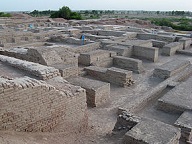

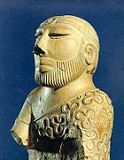


-2600 The pop. in the Indus Valley and Sarasvati River regions begins to mushroom due to farming (ends -2000), building two large cities by -2500 at Harappa on the Indus River S of Lahore in W Punjab, Pakistan, and Mohenjo-Daro near Larkana in S Sindh, Pakistan, with public bldgs. and sanitation, leaving the sculptures Dancing Girl and Priest-King; discovered in the 1920s; India's original jackpot lotto game, Hinduism, oldest religion in the world was developed, based on Shruti (Sruti) (Sansk. "that which is heard"), with the theme that gods are a dime a dozen and they must all ultimately be one, and the goal of life is to transcend them all; too bad, starting about 2500 B.C.E. a climate change begins, causing summer monsoon rains to gradually dry up, causing the Harappa culture to abandon their cities and move to smaller villages in the Himalayan foothills by -1800. About this time the Canaanite city of Jericho ("reah" = fragrant) ("Yareah" = Moon) is founded on the W bank of the Jordan River (modern-day pop. 20K), becoming known for its extensive walls with rectangular towers, and extensive cemetery with vertical shaft-tombs and underground burial chambers, with the nickname "City of Palms". About this time the Taino people from E Venezuela arrive on the island of Hispaniola in large dugout canoes. About this time the Mayan Culture begins in Mesoamerica (Yucatan), beginning the Early Pre-Classical Period of farming villages in the Soconusco region of the Pacific coast (ends 250 C.E.). About this time Caral in the modern-day Lima desert region of Peru is founded, becoming the oldest known urban center in the Americas, containing a temple complex, amphitheatre, and houses; discovered in 1948 by Am. explorer Paul August Kosok (1891-1959); in 2001 Peruvian archeologist Ruth Martha Shady Solis (1946-) pub. radiocarbon dates of 2627 B.C.E. to 1977 B.C.E. About this time 5-ton Preseli Bluestones (not really blue, but kind of blue-gray when wet?) from Preseli in SW Wales are floated on rafts by sea and the Avon River, hauled overland and added to Stonehenge. Houses dated to this time are excavated at 500m-diam. Durrington Walls, 2 mi. ENE of Stonehenge, where a wooden henge is located, oriented to face the midwinter sunrise and midsummer sunset. Vanilla is found in a royal tomb in Megiddo, Canaan.

-2599 Khaba dies, and Huni (d. -2575) becomes king #5 of Egypt's Third Dynasty; his wife is Meresankh I.
-2597 Huang Di dies, and Shao Hao (Jin Tian Shi) (d. -2513) becomes Wu Di king of China; his capital is at Qiu Fu.
-2582 Jared (b. -3544) dies at age 962.
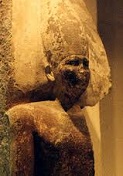

-2575 Huni dies, and his son Sneferu (Snefru) (Snofru) (d. -2551) becomes king #6 (last) of the Egyptian Third Dynasty, building the Pyramids of Dhashur in the royal necropolis of Dahshur (40 km S of Cairo) incl. the Red Pyramid and the Bent Pyramid, establishing commerce with Phoenicia.
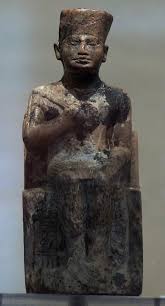

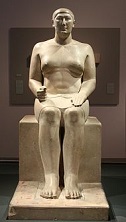
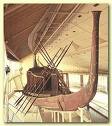


-2551 Sneferu dies (-2589?), and his son Khufu (Cheops) (d. -2528) becomes king #2 of the Egyptian Fourth Dynasty; his mother is Hetepheres (Hetapheres) I; Khufu builds the 450-ft.-high Great Pyramid of Khufu (Cheops) (Giza) at Al Jizah (Giza Plateau), 0.25 mi. W of the Nile River, becoming the tallest bldg. in the world until the 19th cent. C.E.; Pliny the Elder mentions it in his Natural History, saying that it is worshipped as a "divinity", and that "King Harmais was buried in it"; it incl. a tablet explaining how Thoth, god of the night gambled with the Moon and won five days to add to the 360-day calendar outside the jurisdiction of Sun god Ra; the architect is man-breasted Hemon (Hemiunu), son of Snefru and cousin of Khufu; the work takes 100K workers 20 years, and uses 3M 2.5-15-ton stone blocks from Giza, the E bank of the Nile, and Aswan (600 mi. downstream) (only source of granite in Egypt), impoverishing the country and using up the entire male pop.; in 1954 C.E. the 125-ft. Solar Funeral Barque (Ship) of Khufu is discovered near the Great Pyramid; it was really built between -5K and -7K, as proved by the water weathering on the limestone? - John Anthony West (1932-); it was really built on an island, and originally had a gigantic statue of Anubis the watchdog?; the water weathering came from Noah's Flood? :); in 2007 C.E. Jean-Pierre Houdin (1951-) claims to have discovered how they built it, using an outer ramp for the first 140 ft. and a corkscrew-shaped inner ramp for the next 310 ft.; in 2010 the existence of dried mud brick tombs nearby are claimed to prove that the workers were not slaves - gaining the whole world and losing his soul?
-2550 Nin-Kisalsi becomes king of Adab and vassal of Ur. The Early Dynastic II Period in Sumeria (begun -2550) ends. The Second Dynasty of Awan (ends -2230) is founded by Peli, who rules from Susa through a viceroy (his brother?), with an elective monarchy and provincial governors with considerable independence.
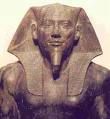

-2528 Khufu dies, and his son Djedefre (Djedefra) (Radjedef) (Ratoises) (d. -2520) becomes king #2 of Egypt's Fourth Dynasty, becoming the first to style himself Son of Ra; his wife is his sister Hetepheres II, mother of Meresankh II, who marries King Khafre.

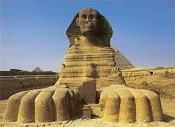
-2520 Djedefre dies, and his brother Khephren (Khafre) (Khafre) (Chephren) (d. -2494) becomes king #3 of Egypt's Fourth Dynasty, going on to build the Great Sphinx of Giza and the Pyramid of Khafre (Second Pyramid of Giza).
-2513 Shao Hao dies, and Zhuan Xu (Gao Yang Shi) (d. -2435) becomes Wu Di king of China; his capital is at Diqiu.


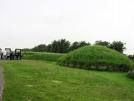


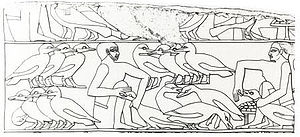
-2500 About this time the Aryan Hurrians (Khurrites) (Hivites or Horites in the Bible) from the Armenian and Cacucasus mountains invade and occupy N Mesopotamia, and areas to the E and W incl. Syria, causing the Egyptians to start calling Canaan Huru (Hurrian Land). About this time the Semitic-speaking Assyrians from Iran-Iraq settle upper Mesopotamia under king (-2450 to -2400) Tudia (Tudiya) (Du-udia), founding the city of Assur (Ashur) (Qal'at Sherqat) on the W bank of the Tiger River N of the its confluence with the Little Zab in modern-day Iraq; they speak the Akkadian Language, which becomes the lingua franca of Mesopotamia (Assyria, Akkad, Babylonia, Isin, Larsa) until Akkadian-influenced Old Aramaic replaces it by the 8th cent. B.C.E.; in the mid-14th cent. C.E. Tamerlane's forces massacre Assur's pop. About this time the Ebla ("white rock") civilization (built over limestone bedrock to take advantage of natural springs) flourishes in N Syria, with a pop. of 200K, incl. 20K in the town of Ebla, with a library of 1.8K+ clay cuneiform Ebla Tablets, discovered in 1974-5 C.E. by Italian archeologist Paolo Matthiae (1940-); the tablets refer to the town of Ha-lam, identified with Aleppo (Halab) (modern-day pop. 1.8M), known for it white marble. About this time the genetic composition of the first pan-European culture suddenly changes as the Yamna (Pit Grave) nomadic herders sweep into Europe from the steppes of Ukraine and Russia, bringing horses, wheeled carts, kurgan burial mounds, and the Proto-Indo-European language, along with marijuana, ending up dominating the gene pool. About this time the Celts of Britain have contact with the Iberian Peninsula, trading flint, bronze, and obsidian. About this time Bronze Age Bell Beaker people arrive in Ireland from E Europe, who were descended from horse herders on the Pontic Steppe; they go on to wipe out the Neolithic pop. with infection diseases? About this time the first Bedouins (Arab. "desert dweller") venture into desert C Arabia, becoming known for their loyalty hierarchy based on proximity of kinship, with the slogan: "I am against my brother, my brother and I are against my cousin, my cousin and I are against the stranger." The Corded Ware Culture and Beaker Culture begin spreading in N Europe (until -2000). The Longshan (Chin. "Dragon Mountain") Period begins in the Yellow River Valley in China (until -1900), where farmers are better organized and raise cattle, sheep, goats, chickens, and water buffalo, building rammed earth walls and producing highly polished black egg-shell pottery. The Bush Barrow royal grave is discovered near the site of Stonehenge, England in 2003, containing the most richly furnished prehistoric grave found in Europe, complete with a skeleton of a Central European and cool golden bling, which must have been worn in the hair over the ears to give the wearer a commanding look among the skin-wearing pop., and thus elevate him to great status and power; is this the king who organized the construction of Stonehenge? Passage Graves are built in Ulster, Ireland. Maes How (Maeshowe), a huge burial mound (tumulus) is built in Orkney. Loughcrew Cairns burial mound in Ireland contains carvings which could be attempts to evoke trances. Neolithic ashmounds are built in Karnataka in S India, and are later expanded to Tamil Nadu. The Okefenokee (Okefinokee) Swamp ("trembling earth") in North Am. (modern-day SE Ga. and N Fla.) is inhabited by aborigines. Cotton is grown in China and India. The Arabian horse originates in the Arabian Peninsula. Animal skins are first used for scrolls in W Asia. Bronze-working is developed in Mesopotamia. About this time the ox-drawn plow (ard) is invented in Egypt. The first illustration of a cat with a collar in a tomb in Saqqara, Egypt. Kites are used in China. Stone arches are invented in the Indus Valley. Lipstick About this time Lipstick is first is used by Sumerians in Mesopotamia, made of crushed gemstones; by -2000 women in the Indus Valley use dyes, and Egyptian women use crushed carmine beetles, with fish scales for a pearlescent effect; Cleopatra VII becomes a big fan. About this time the Egyptians begin the practice of producing foie gras by force-feeding geese and other birds.

-2494 Khephren dies, and Bakare (Bikheris) (Baka) (d. -2490) becomes king #4 of Egypt's Fourth Dynasty; the Egyptians begin sending ships to the Land of Punt (Pwene) (Pwenet) on the African coast of modern-day Eritrea and Somalia (which gets as close as 15 mi. to the coast of Arabia), collecting myrrh to go with the frankincense (olibanum) from the Dhofar (modern-day Oman) region of S Arabia (obtained from the resin of trees of the genus Boswellia) - oh man, that incense is frank? Ur-Nanshe (Ur-Nina) (d. -2465) founds the First Dynasty of Lagash at the confluence of the Tigris and Euphrates Rivers, and throws off domination by Ur.

-2490 Bakare dies, and Menkaura (Menkaure) (Menhaure) (Mycerinus) (d. -2472) becomes king #5 of Egypt's Fourth Dynasty, building the 3rd pyramid at Al Jizah (Giza); his main wife is Khamerernebty II; his other wife is Rekhetre.

-2472 Menkaura dies, and Shepseskaf (d. -2467) becomes king #6 (last?) of Egypt's Fourth Dynasty.
-2469 Methuselah (b. -3317) is 870 years old; Noah (b. -2948) is 501 years old; birth of Noah's youngest (eldest?) son Japheth (Heb. "enlargement") (Gen. 5:32).
-2467 Shepseskaf dies, and (imaginary?) Thamphthis (Djedefptah) (d. -2465) becomes king #7 (last?) of the Egyptian Fourth Dynasty.
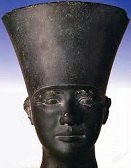
-2465 Thamphthis dies, and Userkaf ("His ka or soul is powerful") (d. -2458) (r. -2494 to -2487?) becomes king #1 of the Egyptian Fifth Dynasty, starting the tradition of building Sun temples in Abusir ("House of Osiris"); his wife is Khentkaues; he builds the Pyramid of Userkaf in Saqqara S of modern-day Cairo; in 2006 after arrested tomb robbers lead archaeologists to the graves, royal dentists Iy Mry, Kem Msw, and Sekhem Ka are discovered near the Step Pyramid of Djoser, complete with a warning that anyone violating the grave will be eaten by a crocodle and a snake; the first mention of the god Osiros (Asiri) (Ausar) (Ausir), "Foremost of the Westerners" (Khenti-Amentiu), "King of the Living", "Lord of the Dead" "Lord of Love", "Ever-Benign and Youthful", "Lord of Silence" (son of Ra and Nut, brother-husband of Isis, brother of Set, Nephthys, and Horus the Elder, and posth. father of Horus the the Younger) (known for rising from the dead) is made in the middle of this dynasty, becoming associated with the heliacal rising of Orion and Sirius during the new year, with pharaohs and later all Egyptians seeking eternal life through him; his main symbol is the 4-banded Djed ("pillar"), representing his spine. Ur-Nanshe dies, and his son Akurgal (d. -2455) becomes king of Lagash.
-2459 The traditional date of Noah's Great Flood; 489-y.-o. Noah (b. -2948) saves all air-breathing life on his Ark, incl. his four sons and their wives; after landing on Mt. Ararat in Turkey (highest mountain in the Middle East), the ramps come down and the Earth is repopulated; Ireland is populated by Magog, son of Japheth? - there must have been land bridges to all continents, right? Mt. Ararat is in the Caucasus Mts., so that's where White (Caucasian) is Right came from?

-2458 Userkaf dies, and his son (by Neferhetepes) Sahure (Sahureh) ("He who is close to Ra") (d. -2446) becomes king #2 of Egypt's Fifth Dynasty, going on to establish trade relations with the Levantine coast, sending several naval expeditions to Lebanon to procure cedars, slaves, etc., to the land of Punt to procure myrrh, malachite, and electrum, and to Sinai to procure copper and turquoise, and building the Pyramid of Sahure in Abusir, which introduces the palm leaf capital, adorned by 110K sq. ft. of fine reliefs; he becomes the only pharoah to be shown in a relief doing gardening work (tending a myrrh tree).
-2455 Akurgal dies, and Eannatum (d. -2425) (grandson of Ur-Nanshe) becomes king of Lagash, raiding Elam and extending his rule throughout Sumer and neighboring territories.
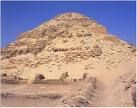
-2446 Sahure dies, and his son Neferirkare (Neferirkara) Kakai ("Beautiful is the soul of Ra") (d. -2426) becomes king #3 of the Egyptian Fifth Dynasty, becoming known for his kind and gentle rule, incl. pardoning elderly royal hairdresser Rawer for accidentally touching his mace during a religious ceremony; his wife is Khentkaus II. Methuselah (b. -3317) is 871 years old; Noah (b. -2948) is 502 years old; birth of Noah's eldest son Shem (d. -1847) (Heb. "name") (Gen. 7:11).
-2440 The Early Dynastic III Period in Sumeria begins (ends -2334).
-2435 Zhuan Xu dies, and Di Ku (Gao Xin Shi) (d. -2365) becomes Wu Di king of China; he makes Haojing his capital in the Yanshi country of Henan.
-2432 En-Shakush-Anna (En-Shag-Kush-Ana) (d. -2403) becomes king of Uruk, founding Second Dynasty of Uruk (Ur).
-2430 Enbi-Ishtar becomes king of Kish.
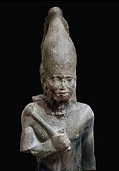
-2426 Neferirkare Kakai dies, and his son Neferefre (Raneferef) ("Beautiful is Ra") (d. -2424) becomes king #4 of the Egyptian Fifth Dynasty, ruling only 2-3 years, leaving an unfinished pyramid in Abusir; his wife is Khentkaus (Khentakawess) III.
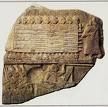
-2425 Eannatum dies after leaving the Stele of the Vultures (oldest historical document known, and oldest evidence of a standing professional army), and his brother Enannatum II (d. -2405) becomes king of Lagash.

-2424 Neferefre dies, and Sahure's son Shakespeare, er, Shepseskare (Shepseskara) Isi (Sisiris) ("Noble of the throne of Ra") (d. -2424) becomes king #5 of the Egyptian Fifth Dynasty, reigning only a few mo. and leaving an unfinished pyramid in Abusir.
-2420 Noah begins to build the gopher wood (whatever that is) Ark (Gen. 6:14).
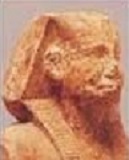
-2416 Shepseskare dies, and Neferirkare Kakai's youngest son (by Khentkaus II) (brother of Neferefre) Nyuserra (Nyuserre) (Neuserre) ("Possessed of Ra's power") Ini (d. -2392) becomes king #6 of the Egyptian Fifth Dynasty.
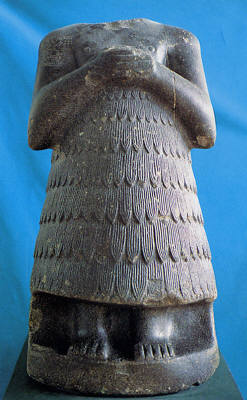
-2405 Enannatum II dies, and his son Entemena (d. -2375) becomes king of Lagash.
-2403 En-Shakush-Anna dies.
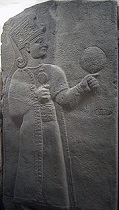



-2400 Lugal-Anne-Mundu (Lugalannemundu) of Adab becomes king of Sumeria, extending his empire to "the four quarters of the universe" (entire fertile crescent from the Persian Gulf to the Mediterranean, and from the Zagros Mts. to the Taurus Mts.); he rules for 90 years. King Enmetana of Lagash in modern-day S Iraq erects the Sumerian cuneiform marble stele to settle a border dispute with King Gishakidu of Umma, becoming the first known record of a border dispute and the term "no man's land". Tavern keeper Kubaba (Ku-Bau) (Kug-Bau) becomes queen of Kish, becoming the only woman to rule in Sumer and Akkad, reigning for 100 years. About this time the city of Carchemish (Karkemish) in N Syria is first mentioned, going on to be ruled by the Mitanni, Hittite, and Neo-Assyrian Empires, and become the location of an important battle in 605 B.C.E. between the Babylonians and Egyptians (Jer. 46:2). About this time the city of Kirkuk in modern-day Iraq near the Khasa River 150 mi. N of Baghdad (modern-day pop. 850K) is mentioned in cuneiform records, becoming part of the Akkadian Empire of Sargon of Akkad in 2335 B.C.E.; about 2150 B.C.E. it becomes Arraphka, capital of the kingdom of Gutium, which is destroyed by the Neo-Sumerian Empire about 2090 B.C.E., going on to become part of the Old Assyrian Empire in 2025 B.C.E. to 1750 B.C.E., and Assyria in 1725 B.C.E. About this time a pottery workshop in Aswan, Upper Egypt near Kom Ombo Temple is operated, becoming the oldest Egyptian workshop known. About this time an erotic dancer's bead-net dress from this era (Old Kingdom period) is made, and later restrung by students of Sir W.M.F. Petrie from a box of beads and shells found in the tomb of a 10-y.-o. girl. About this time the 5th Dynasty relief painting Ti Watching a Hippopotamus Hunt is painted in Egypt. About this time the 17 in. x 9.5 in. x 2 in. black diorite Palermo Stone, inscribed with annals of the Egyptian kings from predynastic times to the first half of the Fifth Dynasty is created.
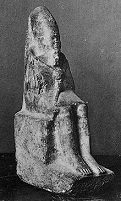
-2392 Nyuserra dies, and Khentkaus III's son Menkauhor (Ikauhor) Kaiu (Mencheres) (d. -2388) becomes king #7 of the Egyptian Fifth Dynasty, sending an expedition to Sinai and building the Akhet-Ra ("Horizon of Ra") Temple in Abusir (the last Sun temple to be built) before being buried in the Headless Pyramid in Saqqara.

-2388 Menkauhor Kaiu dies, and Djedkare (Djedkara) Isesi (Tancheres) (d. -2356) becomes king #8 of the Egyptian Fifth Dynasty.
-2380 Lugal-Kinishe-Dudu (Lugalure) becomes king of Uruk.
-2375 Entemena dies, and his son Enannatum III (d. -2365) becomes king of Lagash.

-2371 Semitic warrior Sargon (Sharru-Kin) ("true king") I (the Great) (d. -2316) (who was floated in a reed basket on the Euphrates as a baby?) stages a coup and becomes king of Kish (until -2316) (56 years); he attacks Hishap-Resher of Awan and sacks Susa.
-2365 Di Ku dies, and Zhi Di (d. -2357) becomes Wu Di king of China. Enannatum III dies, and the usurper priest Enetarzi (d. -2359) becomes king of Lagash.
-2361 In his 11th year Sargon I the Great of Akkad conquers Sumer with infantry archers, and becomes king of Assyria in N Mesopotamia (Sumer and Akkad), the region's first Semitic dynasty (ends -2193), with capital at Agade (Akkad) in N Sumer, making it the richest and most powerful city on Earth, and spreading the Akkadian Language and culture; too bad, his empire lasts for less than a cent.
-2360 Ku-Bau dies, and her son Puzur-Sin (d. -2340) becomes king of Kish, going on to drive out Asinum the Amorite vassal king of Babylon from Assyria, allowing native usurper Ashur-dugul to seize the throne.
-2359 Enetarzi dies, and Lugalanda (d. -2352) becomes king of Lagash.
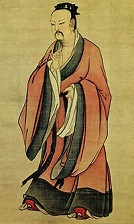
-2357 Zhi Di dies, and Yao Di (Tang Yao) (d. -2255) becomes Wu Di king of China, making his capital at Qi, and allegedly inventing the game of Weiqi (Go) for his son Dan Zhu.

-2356 Kjedkara Isesi dies, and Wenis (Unis) (Unas) (Usas) (Oenas) (Onnos) (d. -2323) becomes king #9 (last) of the Egyptian Fifth Dynasty; his wives are Queen Nebet and Queen Khenut - my wenis needs some nebet and khenut?
-2354 A severe global environmental downturn is caused by comets?
-2352 Lugalanda dies, and the usurper Urukagina (Uruinimgina) (d. -2342) becomes king of Lagash, then becomes the first reformer in history when he tries to throw off the oppression of the priests?
-2350
Another traditional date of Noah's Flood - Moo oink cluck gobble? Go ahead, let it snow?
When you guys go to the mall you'll have the network?
The Nemedians ("holy", "privileged")
arrive in Ireland in one of 44 ships that set out from the Caspian Sea a year and a half earlier, and defeat the semi-divine
Fomorians; later they are defeated by the
Fir Bolg ("bag men", "bright ones"),
who are defeated by the Tuatha De Danann
(People of the Goddess Dana or Danu), who are defeated by the Sons of Mil Espaine (Milesians)
from the NW Iberian Peninsula, after which they are led underground into the Sidhe (Shee) Mounds
by the god Dagda ("good god"), assuming invisibility, with the power to reappear in human form, becoming the Fairy Folk, with their goddess
Eriu giving Ireland its name; thus, modern-day Ireland contains two races, one visible, the other invisible? - depending on how much whiskey
you've drunk?
The largest known obelisk in Egypt's Old Kingdom.
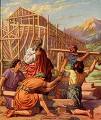
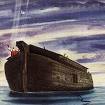
-2348 Methuselah (b. -3317) dies at age 969 (Gen. 5:27); 600-y.-o. Noah (b. -2948) finishes Noah's Ark, 300 cubits long x 50 cubits wide by 30 cubits high (438 ft. x 73 ft. x 44 ft.) (Gen. 6:15-16), which has 1.4M cubic ft. of cargo space and 96K sq. ft. of floor space on 3 floors (same as the Titanic) and holds at least the bare minimum of 43 kinds of mammals, 74 kinds of birds, and 10 kinds of reptiles necessary to restock the Earth; the waters of the Great Flood of Noah (Noah's Flood) (Genesis Flood) (Deluge) begin to fall in Nov. (Gen. 7:11); allegedly a protective water canopy hovering over Earth falls, at first drowning everything that breathes air, then part of it freezes, leaving a permanently raised ocean level with a new continental configuration (avg. ocean depth 2.5 mi., avg. land elev. 0.5 mi.) (incl. the 277-mi.-long 18-mi.-wide 6,093-ft.-deep Grand Canyon, the world's largest gorge?); since then we get too much direct radiation, causing the life span to plummet (and also conveniently causing all the hereditary skin colors?); whether the Great Flood happened or not, glaciers end up occupying 5.8M sq. mi. of the world's land surface, about 10%, an area the size of South Am.; if the Earth were to be flattened out, water would cover it to a depth of 2 mi.; if the Antarctic ice were melted, the ocean level would rise 240 ft., submerging one-quarter of the world's land mass; computer simulations by Nat. Center for Atmospheric Research in Boulder, Colo. in 2010 show how a land bridge could be created by a strong E wind at the junction of an ancient river and a submerged coastal lagoon along the Mediterranean Sea. The human Y-chromosome genetic clock backs-up the Bible's dating of Noah's Ark?
-2347 Noah's Flood wipes out all but eight humans (Noah, his three sons and their very fecund wives) and a homemade wooden ark full of zoological specimens; there being no water canopy anymore, the rainbow first appears, big J's promise of no more global floods - absolute truth, or a fairy tale? Coincidence or not, the Chinese character for ship consists of the characters for eight + persons + vessel.
-2346 Noah (b. -2948) is 602 years old; Shem (b. -2446) is 100 years old; Arpachshad (d. -1909), son of Shem is born, and lives 438 years (Gen. 10:22-24; 11:10-13; 1 Chron. 1:17-27); meanwhile Noah and his three sons and their wives get to work reproducing like rabbits, founding 70 main families, which spread out from Mount Ararat between the Black and Caspian Seas; "From these the nations were spread about in the Earth" (Gen. 10:32); Noah's son Japheth (Heb. "he expands") founds the 14 Indo-European families (Aryan speech): Ham (Heb. "heat") founds the 30 Afro-Asiatic families (Hamitic speech) through his four sons Cush (Ethiopians), Canaan (Canaanites), Mizraim (Egyptians), and Uncle Nasty, er, Phut (Put) (Libyans); Egypt is called the "land of Ham", and their deity Ammon is really Ham-on (Rye?); Shem (Heb. "fame") founds the 26 Asiatic families (Semitic speech); Japheth Branch: Gomer (Cimmerians N of Black Sea), Ashkenaz (SE of Black Sea), Riphath (Paphlagonians), Togarmah (Armenians), Magog, Madai (Medes S of Caspian Sea), Javan (Ionians), Elishah (near Greece), Tarshish (SW Europe and Spain), Kittim (Cyprus), Dodanim (Rodanim) (Rhodes and adjacent islands), Tubal (Tibareni in Asia Minor), Meshech (Phyrians in Asia Minor), Tiras (Tyrrhenians in the Aegean); Ham Branch: Cush (Ethiopians in E Africa and Arabia), Seba (E Africa), Havilah (SW Arabia), Sabtah (S Arabia), Raamah (SW Arabia), Sheba (SW Arabia), Dedan (Arabia), Sabteca (S Arabia/Ethiopia), Mizraim (Egyptians), Ludim (N Africa), Anamim (Egypt), Lehabim (Libyans), Naphtuhim (N Egypt), Pathrusim (Upper Egypt), Casluhim, Philistines (Palestine) (Heb. "Plishtim" = invaders), Caphtorim (Cretans), Put (N Africa), Canaan (W of Jordan River), Sidon (Canaan's son) (Sidonians or Phoenicians), Heth (Canaan's son) (Hittites), Jebusite (Jerusalem), Amorite (Palestine), Girgashite (W of Jordan River), Hivite (Central Palestine), Arkite (W of Lebanon Mts.), Sinite, Arvadite (Syrian coast islands), Zemarite (N of Phoenician Coast), Hamathite (N of Palestine); Shem Branch: Elam (SE of Mesopotamia), Asshur (Assyrians), Arpachshad, Shelah, Eber (Arabia, Mesopotamia), Peleg, Joktan (Arabians), Almodad, Sheleph, Hazarmaveth, Jerah, Hadoram, Uzal, Diklah, Obal, Abimael, Sheba, Ophir, Havilah, Jobab, Lud (Lydians of Asia Minor), Aram (Aramaeans and Syrians), Uz, Hul (near Armenia), Gether, Mash (Syro-Arabian Desert or N Mesopotamia).
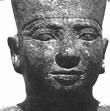
-2345 Teti (Othoes) (d. -2333) becomes king #1 of the Egyptian Sixth Dynasty (ends -2181); his mother Queen Sesheshet helps reconcile the two warring factions of the family and get him raised to the throne; in Nov. 2008 her pyramid is discovered in Saqqara (brand new sneakers and clothing, all dressed up for first grade?); in 2000 C.E. the mummy of a physician from the Egyptian Sixth Dynasty (24th cent. B.C.E.) is discovered in Saqqara (12 mi. S of Cairo); there are 82 types of specialists in Egypt, plus one who removes the evil eye; lion's fat is used as a remedy for baldness (and since it's so expensive, who can afford it?). About this time the Kingdom of Yam flourishes in Upper Nubia?
-2342 Lugal-Zage-Si (Lugalkisalsi) (Argandea) (d. -2316), king of Umma defeats Urukagina of neighboring Lagash, and becomes king of Uruk and #1 ruler in the Middle East, founding the Third Dynasty of Uruk; too bad, the Sumerian empire has exhausted itself with internecine strife, so it is ripe for outside conquest.
-2340 Puzur-Sin dies, and his son Ur-Zababa becomes king of Kish.
-2334 About this time the Akkadian Empire in S Iraq in the Tigris-Euphrates River region is founded by Sargon of Akkad via union of independent city-states, with capital in the city of Akkad, becoming the first empire in Mesopotamia, uniting Akkadian and Sumerian speakers under one rule, and exercizing influence across Mesopotamia, the Levant, and Anatolia, sending military expeditions as far S as Dilmun (modern-day Bahrain) and Magan (modern-day Oman) in the Arabian Peninsula.
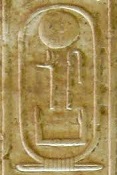
-2333 Teti is murdered by his usurper son Userkare (Woserkare) ("Powerful is the soul of Ra") (d. -2332) becomes king #2 of the Egyptian Sixth Dynasty, ruling only 1 (5?) year.

-2332 Userkare is killed by Teti's other son Pepi (Pepy) I (Meryre) ("Beloved of Ra") (Neferdjahor) (d. -2255), who becomes king #3 of the Egyptian Sixth Dynasty, going on to aggressively expand into Nubia and expand trade to Lebanon and the Somalian coast; his wives are sisters Ankhesenpepi (Ankhenesmeryre) I and II; too bad, the regional nobility begins to gain power, causing the Old Kingdom to decline.
-2311 Noah (b. -2948) is 637 years old; Judah's 3rd son Shelah is born (Gen. 38:2-14).
-2316 Sargon I of Akkad defeats and captures bad little nipper Lugal-Zage-Si of Uruk, parading him around "in a dog collar to the gate of Enlil" in Nippur, and dismantling the walls of Uruk; he then heads E to Lagash and Umma, conquering all the way to the Persian Gulf, symbolically washing his weapons in it to celebrate conquering all of Sumer; Sargon I dies, and his son Rimush (Rimus) (d. -2270) becomes king #2 of Sumer and Akkad, going on to suppress widespread revolts.

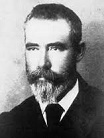
-2300 About this time the city of Babylon on the Euphrates River in Mesopotamia is founded, becoming a major city under Amorite king Hammurabi in the 18th cent. B.C.E., becoming the largest city on Earth from -1770 to -1670 and from -612 to -320, becoming the first city to reach 200K pop.; it is abandoned about 1000 C.E. About this time (-2800?) the Millennium Fever mother city of Jerusalem (Salem) ("peace") (Arabic "al-Quds" = the holy) (Yiddish "Yerushalayem" = teaching of peace) (modern-day pop. 883K/1.25M) 35 mi. from the E shore of the Mediterranean Sea is founded by the Canaanite (Hittite?) (Hurrian?) (Amorite?) Jebusites (Shem and Eber, ancestors of Abraham?) on the ridge of the Judean Mts. between the N edge of the Dead Sea and the Mediterranean Sea, on the hard limestone Ophel (Heb. "fortified hill") above the Gihon (Heb. "to gush forth") Spring, which emerges from the Kidron (Heb. "dark, mourn") Valley to the E; the city was originally surrounded by thick green forests of almond, olive, and pine trees. About this time there is a gen. Indo-European migration into Anatolia (Asia Minor), incl. the Hittite (Nesite)-speaking Hittites, who cross the Bosporus and settle on the Euphrates around the city of Kussar, worshiping the sky-storm god Teshub (Teshup) (Hadad), and the Luwians, who settle in S Anatolia E of the Halys River, worshiping the storm god Tarkhunt - everybody worships that god? About this time the Shiva Linga (phallic pillars) representing the Hindu deity Shiva in Shaivism are first created, often mounted inside a lipped disc-shaped platform called a yoni that symbolizes the goddess Shakti. The genes for lactose tolerance become widespread in Europe. The temple records of Lagash mention an Elamite raid on Sumer. About this time King Ur-Nanshe of Lagash mentions the kingdom of Dilmun, later mentioned in the Epic of Gilgamesh as an Eden-like island of everlasting life (Bahrain?), which leaves many burial mounds that survive to modern times; discovered by British archaeologist Thomas Geoffrey Bibby (1917-2001). Permanent farming villages are established in Mexico about this time. Woodhenge AKA the German Stonehenge is built of 1.2K locust tree logs near Pommelte on the Elbe River, becoming known for human sacrifice. The 5-ton bluestones at Stonehenge are moved and replaced by 25-to-45-ton Sarsen ("Saracen Stone") sandstones from the nearby (20 mi.) Marlborough Downs, then turned upright to become menhirs ("long stones") and trilithons (two vertical stones and a horizontal stone on top, forming the Greek letter pi); the pale green sandstone Altar Stone (discovered in 1620 C.E.) is erected; the total effort spend on Stonehenge amounts to 30M man-hours?; the Amesbury Archer, an archer from the Alps is buried in Amesbury near Stonehenge, becoming the oldest known burial site in England; discovered in May 2002.
-2297 The Chinese record the Yellow River flooding its banks.
-2296 The Chinese record a comet sighting.
-2283 Yao Di orders his officer Yu to combat a flood of the Yellow River.
-2281 Noah (b. -2948) is 667 years old; 30-y.-o. Shelah's son Eber (Heber) (d. -1839) (Heb. "opposite side", "passage") is born, refusing to help build the Tower of Babel, keeping his language from being confused, and retaining the pure lingua humana of Hebrew, named after him (Gen. 10:21, Luke 3:35).
-2270 Rimush is assassinated by a clay tablet to the head, and is succeeded by his brother Manishtushu (d. -2255) as king #3 of Sumer and Akkad.
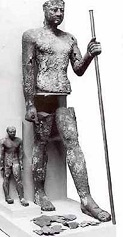


-2255 Pepi I dies; his pyramid mortuary complex Mennefer Pepy (Men-nefer) ("Enduring and beautiful") in Lower Egypt is so impressive it gives its name to the area, which the Greeks later call Memphis; he is succeeded by his eldest surviving son Merenre Nemtyemsaf I (d. -2246) as king #4 of the Egyptian Sixth Dynasty. Manishtushu dies, and his son Naram-Sin of Akkad (d. -2218) becomes king #4 of Sumer and Akkad, expanding to the Zagros Mts. and destroying the city of Ebla in NW Syria (later rebuilt); his soldiers first use the composite bow, which is able to penetrate leather armor and has 2x the range of simple bows; he makes the first known treaty in history with the king of Elam, who becomes his vassal; an inscription mentions Aram (Damascus) as a place along the Upper Euphrates River. Yao Di dies, and Shun Di (Yu Shun) (d. -2205) becomes Wu Di king of China, making his capital at Qi.
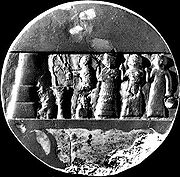

-2250 The earliest recorded solar eclipse (China). Ptolemy records the heliacal rising of Sirius (brightest star in the sky, 8.8 l.y. from Earth) on the 4th day after the summer solstice this year; the 2nd brightest star is Canopus in the S, which is only half a magnitude fainter, but is 300 l.y. from Earth and is invisible at latitudes N of Norfolk, Va. About this time Enheduanna (-2285 to -2250) ("lady ornament of heaven"), daughter of Sargon I (a feminist?) leaves some songs (hymns) in cuneiform to the Sumerian harvest goddess Inanna (Iananna), the Venus star. Portal tombs incl. the Kempe Stones in Newtownards are built in Ulster, Ireland.
-2247 Noah (b. -2948) is 701 years old; Shelah is 64 years old; 34-y.-o. Eber has son Peleg, during whose time "the Earth was divided" (Gen. 10:25).

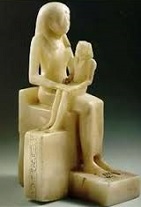
-2246 Merenre I dies, and his 4-y.-o. son (by Ankhesenpepi II) Pepi (Pepy) II (Neferkare) ("Beautiful is the Ka of Re") (d. -2184) becomes king #5 of the Egyptian Sixth Dynasty, ruling over a crumbling kingdom, and becoming known for being kind to dwarves; Merenre I is really his elder brother, and he rules 96 years?
-2240 Kutik-in-Shushinak (d. -2230) becomes the last king of the Second Dynasty of Awan, and throws off the yoke of Akkad, taking the title "King of the Four Quarters", then doing a lot of building in the sacred acropolis in Susa.
-2230 Kutik-in-Shushinak dies during an attack by the semi-barbaric Gutians (Guteans) (Guti) (Quti) from the Zagros Mts., ending the Second Dynasty of Awan (begun -2250). The Old Elamite Kingdom begins (ends -1400). The Simashki Dynasty in Elam N of Susa begins (ends -1925); royal succession is through the reverend mother (amma hashtuk), the king's sister-wife. The Elamite (SW) Persians adopt a cuneiform script; still undeciphered?

-2218 The Gutians sack and destroy Agade, and subjugate and waste the entire empire of Sumer; Naram-Sin dies, and his son Shar-Kali-Sharri (d. -2193) ("king of all kings) becomes king #5 of Sumer and Akkad.
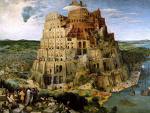

-2217 Noah (b. -2948) is 731 years old; Shelah is 94 years old; Eber is 64 years old; Peleg is 30 years old; Peleg's son Reu (Ragau) is born. Construction begins on the Tower of Babel (Gen. 11:4), an attempt to disobey Jehovah's order to populate the entire Earth and instead build New York, New York, it's my kind of town, which Big J foils by confounding the workers' languages, rewiring their language circuits so that what they have here is a failure to communicate, and they do a Cool Hand Luke and ditch their own U.N. Bldg. (no translators), and go their own ways, forever at war while spreading all over the Earth? Was Babylon the original source of magic, divination, and astrology, and was the Tower of Babel built on the Dark Isle (al-Djezair) between the Tigris and Euphrates, containing eight tiers in an attempt to attain to immortality, becoming the source of the Eightfold Path of Buddha, the figure-8 twined serpents on the Caduceus (Staff of Hermes, AKA Mercury, AKA Thoth, AKA Prince of Tricksters, Joker, Jester, Fool), the I-Ching, Tarot Cards, the Game of Kings (Chess) and the Knights' Tour, the marriage of the Red King and White Queen, the secret of the peacock's tail, the sideways-8 figure for infinity, and the alchemical quest for the Philosopher's Stone, a cake made from a reddish-black powder, which is mixed with Aqua Philosophia, "heavy water" gathered from dew when the Sun is between the Bull and the Ram (when the water falling from the Moon is heaviest), creating the Elixir of Life (al-Iksir), which gives immortality if made correctly, but death if made incorrectly?
-2185 Noah (b. -2948) is 763 years old: Shelah is 126 years old; Eber is 96 years old; Peleg is 62 years old: 32-y.-o. Reu's son Serug (great-grandfather of Abraham) is born.

-2205 Shun Di dies, and Xia Yu Di (Yu the Great) (d. -2197) founds the Xia (Hsia) Dynasty in China (ends -1783) (-2070 to -1600?) after he becomes a hero by controlling a catastrophic flooding of the Yellow River by dredging.
-2200 About this time shifts in ocean and atmospheric circulation cause the 4.2 Kiloyear Aridification Event to begin (ends -2100), causing the 200-year Meghalayan mega global drought that devastates civilizations from Egypt to China, causing the collapse of the Old Kingdom in Egypt, the Akkadian Empire in Mesopotamia, and the Liangzhu Culture in the Lower Yangtze River Basin, also probably causing the collapse of the Indus River Valley civilization, s purring migration of Indo-European speaking people into India, plus mass migrations from Egypt, Greece, Syria, Palestine, Mesopotamia, the Indus River Valley, and the Yangtze River Valley; a drought begins in the Akkadian Empire, causing migration away from urban centers followed by a collapse of the govt. known as the Third Millennium Mesopotamian Urban Crisis; the Meghalayan Age in modern-day Meghalaya, India begins. Queen Semiramis of Babylon builds a tunnel under a river. A rich man is buried near the modern-day village of Dabene, 75 mi. E of Sofia, Bulgaria along with 15K tiny gold rings of fine craftsmanship; discovered in 2004-2005 C.E. An inscription in the Dendera Temple Complex in Egypt 37 mi. N of Luxor reads: "The mouth of a perfectly contented man is filled with beer." Inventions: iron anchor chains on ships are first used by the Chinese under Emperor Yu, two fore and two aft.
-2197 Xia Yu Di dies, and his son Xia Qi (d. -2188) becomes Xia king #2 of China.
-2193 The city of Agade falls to Elam, the Akkadian empire under Shar-Kali-Sharri collapses, and the Gutian period of anarchy begins (ends -2123); Elulu (Elul-Dan) becomes king of the Akkadians; did an abrupt shift to drought in Mesopotamia about -2200 doom the Akkadian culture?
-2189 Dudu (d. -2168) becomes king of Akkad.
-2188 Xia Qi dies, and Xia Tai Kang (d. -2159) becomes Xia king #3 of China, ruling from Zhen Xun (Gong Xian, Henen); the throne becomes hereditary.

-2184 Pepi II dies an old man, and his old son Merenre Nemtyemsaf II becomes king #6 (last) of the Egyptian Sixth Dynasty, ruling 13 mo.; the Old Kingdom of Egypt (founded -2650) collapses, and an intermediate period begins.

-2183 The First Intermediate Period (Egyptian Dynasties 7-11) (ends -2050), a troubled time for Egypt begins, with scrambling for power and overlapping reigns of rival kings; Netjerkare (Netiqerty) Siptah (Nitocris) becomes king #1 of the combined Egyptian Seventh and Eighth Dynasties (ends -2160), in which 70+ fools-for-ya-baby claim the Egyptian throne - look at me, no hair, no eyelashes, no boobs?
-2168 Dudu dies, and Shudurul (Shu-turul) (d. -2154) becomes the last king of Akkad before it is conquered by Uruk.
-2160 Achthoes of Heracleopolis (Herakleopolis) seizes control of Middle Egypt; the Eighth Dynasty ends, and the Egyptian Ninth Dynasty begins (ends -2025), based in Herakleopolis Magna, with up to 18 kings; meanwhile about this year the Egyptian Tenth (10th) Dynasty begins, based in Herakleopolis (ends -2025), with several kings incl. Wahkare Khety and Merikare (Merykare) (Merykara).
-2159 Xia Tai Kang dies, and Xia Zhong Kang (d. -2146) becomes Xia king #4 of China.
-2155 Ur-Bau (Ur-Baba) (d. -2142) founds the pro-Gutian Dynasty in Lagash. Noah (b. -2948) is 793 years old; Shelah is 156 years old; Eber is 126 years old; Peleg is 92 years old; Reu is 62 years old: Serug is 30 years old; Serug's son Nahor (grandfather of Abraham) is born.
-2154 Agade (Akkad) is sacked and destroyed, allowing the Gutians (Guteans) (Guti) people of the Zagros Mts. in Iraq to overrun S Mesopotamia, ending the Akkadian Empire (founded -2334); its fall was caused by climate change?
-2153 Urnigin (Ur-Nigina) (d. -2147) becomes king of Uruk, founding the Fourth Dynasty - does ur-vigina smell like fish?
-2152 Death of Pepi II?



-2150 The Age of Taurus ends, and the Age of Aries begins (ends 1 C.E.). About this time the Ziggurat of Nana (Nanna) (Ur) is built near Nasiriya in Ur (modern-day Dhi Qar Province, Iraq), dedicated to the Sumerian Moon god Nana (Nanna) (Sin); discovered in 1850 by William Kennett Loftus; excavated by Sir Leonard Woolley in the 1920s.
-2147 40-y.-o. Virgin, er, Urnigin dies, and Urgigir (Ur-Gigira) (d. -2141) becomes king of Uruk.
-2146 Xia Zhong Kang dies, and Xia Xiang (d. -2079) becomes Xia king #5 of China, moving his kingdom to Shang.

-2142 Ur-Bau dies, and his son-in-law (by Ninalla) Gudea (d. -2122) becomes king of Lagash, making the city-state #1 in Sumeria, and becoming known for his piousness and ability, getting numerous statues of him erected, many of which survive to modern times, making him the best known Sumerian king - gud idea?
-2141 Urgigir dies, and Kudda (Kuda) becomes king of Uruk.
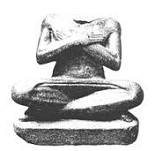
-2140 About this time Intef the Elder (the Great), son of Iku becomes king #1 of the Egyptian Eleventh (11th) Dynasty (ends -1991), which eventually refunifies Egypt; its capital is in the city of Thebes on the bend of the Nile in Upper Egypt; it consists of the cities of Karnak in the N half (right or E bank), and Luxor in the S half (right or E bank); the last pyramid tombs are built in this period; the Valley of the Kings is later situated on the left or W bank.
-2134 Mentuhotep (Tepyaa) I (the Great) (d. -2120) becomes king #2 of the Egyptian 11th Dynasty in Thebes.
-2126 Noah (b. -2948) is 822 years old; Shelah is 185 years old; Eber is 155 years old; Peleg is 121 years old; Reu is 91 years old: Serug is 59 years old; Nahor is 29 years old; Nahor's son Terah (Terach) (father of Abraham) is born (Gen. ch. 11); his daughter (Abraham's half-sister) is Sarah; other sons incl. Haran and Nahor.
-2123 Utuhegal (Utuhengal) (d. -2113) rebels and defeats the Gutians and kicks their butts out of Sumeria after putting his foot on the neck of defeated Gutian king Tiragan, then becomes king of Uruk and founder of the Fifth (5th) Uruk Dynasty.

-2122 Gudea dies, and his son Ur-Ningirsu (d. -2118) becomes king of Lagash and the last vassal of the Gutians.
-2120 Mentuhotep I dies, and his son (by Neferu I) Sehertawy ("Pacifier of the two lands") Intef I (d. -2118) becomes king #3 of the Egyptian 11th Dynasty, becoming the first member of the dynasty to claim a Horus name, going go war with Coptite nomarch Tjauti and expanding the kingdom's border 150 mi. northward to Abydos.
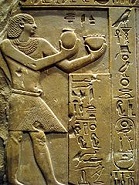
-2118 Intef I dies, and his brother Wahankh Intef (Inyotef) (Antef) II (d. -2069) becomes king #4 of the Egyptian 11th Dynasty, reigning for almost 50 years. Ur-Ningirsu dies, and his brother Ugme (Pirig-Me) (d. -2115) becomes king of Lagash.
-2114 Ugme dies, and Ur-Bau's son-in-law Namhani (d. -2111) becomes king of Lagash and Umma.

-2113 The Neo-Sumerian Empire (Third Dynasty of Ur) in Sumeria is founded by Utuhegal's gen. Ur-Nammu (d. -2095), who unites Sumer and Akkad (ends -2004), and creates the Law Code of Ur-Nammu, the oldest known human law code, which precedes Hammurabi's Code by three cents.

-2100 The Early Bronze Period ends, and the Middle Bronze Period begins (ends -1500). About this time the Kingdom of Kush of dark-skinned negroids is established in S Egypt, centered around Kerma above the Third Cataract (of seven) on the Nile, flourishing during Egypt's Second Intermediate Period (-1750 to -1570), giving the Egyptians up north somebody to invade and kick around? (ends -1524); a brick palace and large burial mounds (tumuli) are constructed in Kerma. Alleged date of the birth of Abraham (Abram) in Ur of the Chaldees(modern-day Tell el-Muqayyar near Nasiriyah) in S Iraq, or Sanliurfa (Urfa) (Edessa) in SE Turkey to Terah (Heb. "wild goat"); the age of the Biblical Patriarchs begins (ends -1400). About this time Sumerian cylinder seals begin to focus on the presentation scene, where a worshiper is presented to a god by his good angel. The Hymn to the Nile is composed.

-2095 Ur-Nammur dies, and his son Shulgi (d. -2047) becomes king #2 of the Third Dynasty of Ur, conquering Susa and doing considerable building, incl. the the Temple of Inshushinak, going on to become a patron of lit. and found schools and academies.
-2090 Ur-Ninsuna (d. -2080) becomes king of Lagash and vassal of BMOC Ur.
-2080 Ur-Ninsuna dies, and Ur-Nikimara (d. -2070) becomes king of Lagash and vassal of Ur.
-2079 Xiao Xiang is assassinated by Han Zu, who is executed by Xia Shao Kang (d. -2057), who becomes Xia king #6 of China, awarding the Kingdom of Zeng to his youngest son Qu Lia.
-2070 Ur-Nikimara dies, and Lu-Kirilaza (d. -2050) becomes king of Lagash and vassal of Ur.

-2069 Intef II dies, and his son Intef (Inyotef) III (d. -2061) becomes king #5 of the Egyptian 11th Dynasty, extending his kingdom's border N against the Egyptian 10th Dynasty, and doing some building in Elephantine; his wife is Iah (Yah) (Jah) (Aah) ("Moon"), who becomes the mother of Mentuhotep II and Queen Neferu.

-2061 Intef III dies, and his son (by Iah) Mentuhotep (Mentuhope) II (Nebheptre) (d. -2010) becomes king #6 of the 11th Egyptian Dynasty, becoming the first to build his tomb in Deir al-Bahri (al-Bahari) ("the Northern Monastery") in the Theban necropolis on the W bank of the Nile River opposite Luxor.
-2057 Xia Shao Kang dies, and Xia Zhu (d. -2040) becomes Xia king #7 of China.
-2050 Lu-Kirilaza dies, and Ir-Nanna becomes king of Lagash and vassal of Ur. The Alulu Beer Receipt from Ur acknowledges the receipt of 5 Silas (4.5 l) of the best beer from brewer Alulu.
-2047 Shulgi dies, and Amar-Sin (d. -2038) becomes king of Ur.
-2040 Xia Zhu dies, and Xia Huai (d. -2014) becomes Xia king #8 of China.
-2038 Amar-Sin dies, and his brother Shu-Sin (d. -2029) becomes king of Ur.
-2029 Shu-Sin dies, and his son Ibbi-Sin (d. -2004) becomes the last king of Ur, who has the problem of the pesky Amorites to the W, who begin invading and rocking the boat.
-2028 Eshhunna breaks away from Ur.
-2027 Elam begins breaking away from Ur.
-2023 Lashan declares independence from Ur.
-2021 Enpi-luhhan, 5th king of Simashki attacks Elam and takes Susa, then Ibbi-Sin of Ur counterattacks and captures him.
-2017 Ibbi-Sun of Ur invades Susa, but is unable to maintain control of Elam. Ishbi-Erra (d. -1985) becomes king of Simashki.
-2014 Xia Huai dies, and Xia Man (d. -1996) becomes Xia king #9 of China.

-2010 Mentuhotep II dies after reigning 51 years and reuiniting Egypt in his 39th year on the throne, founding the Middle (Reunified) Kingdom of Egypt (ends -1650), known for boasting about campaigning against the Nubian region of Kush, becoming the earliest Egyptian reference to them; his son Nebhepetre Mentuhotep III (d. -1998) becomes king #7 of the Egyptian 11th Dynasty.
-2007 Taking advantage of the confusion caused by the on-the-make Amorites, the Elamites under Hutran-tempti, allied with tribes from the Zagros Mts. capture and sack Ur, and capture Ibbi-Sin.
-2004 Ibbi-Sin dies in captivity in Elam.
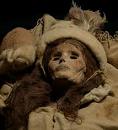



-2000 World pop.: 27M; Sudan region: 500K (1M by -1500). Super-freak? About this time the long-headed (dolichocephalic) super-tall fair-skinned blonde-blue Amorites (from Europe or possibly the Arabian Peninsula, having a unique agglutinative language) migrate to S Mesopotamia and intermarry with the pop. of the old city-states there, founding the Uruk Culture in Sumer (pop. 300K-500K), containing Semitic elements from Akkad N of Sumer on the W bank of the Euphrates in modern-day Iraq (which derives its name from Uruk) about 30 mi. SW of Baghdad, taking over the cities of Isin and Larsa and beginning the Semitic-dominated Isin/Larsa Period in Sumeria and Akkad (ends -1763), with Isin and Larsa fighting for control; the Amorites also invade Phoenicia, whose port city of Ptolemais (Acre) (Acco) commands the only natural harbor on the Mediterranean coast; some end up in Canaan in the time of Israelite Gen. Joshua, according to the Bible; the Lament of Ur mentions an "evil wind" which destroys Ur about this time - Semite becomes right? Shut up old ladies, I'm coming for you at 3 o'clock? About this time the Hittites are pushed (hurried by the Hurrians?) W through Cappadocia ("beautiful horses") in the Anti-Taurus Mts. in SE Anatolia (Asia Minor), where they build underground cities (later enlarged by Christians), becoming integrated into the Land of Hatti and absorbing the Hattians into their kingdom, based in Hattusa(s) (Pteria?) near modern-day Boghazkoy (Boghaz Keui) 200 km. W of Ankara, and worshiping the Sun goddess Arinna along with every other god they can get their hands on?; ethnicity doesn't matter as long as you learn to speak Hittite and dump the berries in?; women warriors are welcome; they join the new Old Assyrian Trade Network (ends -1750); the Bible mentions the Hittim, descended from Canaan's son Heth (Gen. 10:15), which are really the Khatti in Syria, kin to the Phoenicians and Amorites? About this time the Early Helladic Period of Greece ends, and the Middle Helladic Period of Greece begins (ends -1650), characterized by a slower pace of development along with the evolution of megaron-type cist graves. About this time the city of Hazor (Hatzor) (Asour) in the Upper Galilee on the trade route between Egypt and Babylon has a pop. of 20K, making it the largest city in the region and head of the Canaanite settlements (Joshua 11:10); it is ruled by Egypt as the holy city for Hathor until Joshua destroys it ca. 1200 B.C.E. (Joshua 11:13, 21); in 2019 seven large basalt staircases are excavated at Tel Hazor. About this time Bantu farms spread throughout Africa, causing the Khoisan and other groups to go into a pop. decline. About this time settlers from New Guinea settle in Polynesia. About this time the Chaluka Site in the Aleutian Islands is inhabited, lasting 3.5K years before being abandoned, and leaving a large midden that is excavated in 1909, 1938, and 1962. About this time there is human gene flow from India to Australia. A relict pop. of Woolly mammoths on Wrangel Island off the coast of Siberia goes extinct, becoming the last pop. to go extinct. About this time the earliest known mention of Jerusalem in written records is by the Egyptians in the Egyptian Execration Texts (Proscription Lists), where it is called Urusalimum or Rusalimum, referring to the Canaanite god of dusk Shalim (Shalem) (Salim) (Salem) (Salam), the root of the Semitic word Shalom or Salam, with is identified with Venus AKA the Evening Star, which constrasts with his brother deity Shahar AKA the Morning Star, both offspring of El; around 1700 B.C.E. the Jebusites fortify it. About this time the first Palace of Knossos (Cnossus) is built by the Minoans in Knossos, Crete, becoming the oldest city in Europe, beginning the First Palace Period (ends -1700), which also produces the palaces of Malia (on the N coast) and Phaistos (Phaestus) in SC Crete; the Labyrinth of Knossos is allegedly built by Daedalus for King Minos of Crete; discovered in 1878 by Minos Kalokairinos, and excavated in 1900-35 by Sir Arthur John Evans (1851-1941). About this time the city of Troy in Asia Minor where the Aegean Sea meets the Hellespont is founded by Greeks, who go on to create nine levels of habitation (Early Bronze Age to Roman times) for later archeologists to dig through; excavated in 1871-2 by German archeologist Heinrich Schliemann (1822-90). About this time the city of Sodom in S Jordan comes to an abrupt end? About this time the Fremont People settle on the Colorado Plateau in North Am. (130 mi. SE of modern-day Salt Lake City) (until 1000 C.E.). In this cent. the first Italic Tribes settle in Italy (Vitalia) ("calf") young cow, not part of the leg, even though Italy is shaped like a boot?), which is washed by five seas, the Adriatic, Ionian, Ligurian, Tyrrhenian, and Mediterranean; the earliest known olive oil is found in Castelluccio. In this cent. the fierce warlike nomadic pastoral Kurganes (Kurgan) Culture from the Black Sea area spreads to C Europe, the Balkans, Carpathians, and Danube, leaving elaborate burial mounds. About this time Genoa ("knee") on the Ligurian Sea is founded by Sea People from Tyre, settling with the Celtic Ambrones and becoming pirates, which the Greeks call Tyrrenoi. About this time mysterious Stonhenge-like earthworks ae built in the Amazonian rainforest of modern-day Acre, Brazil. About this time rock art paintings in the Limari Valley in Chile in the Coquimbo Region S of the Atacama Desert begin to be made to mark territory (until 500 C.E.). About this time Dingos arrive in N Australia; the earliest known dingo fossil dates to -1,450 - and start eating buy-bees? About this time the last woolly mammoths die on Wrangel Island in the Arctic Ocean. About this time the well-watered highlands of S Arabia (Yemen), AKA Arabia Felix ("Happy Arabia") between the Red Sea and the Rub'al Khali Desert make use of terraced agriculture to support permanent settlement. People in the Andean coast of Peru and Chile begin growing maize and cotton, making pottery, and working metal. Date of Phoenician prince Cadmus (Kadmos) (Gr. "from the east"), son of King Agenor of Tyre, brother of Europa, Phoenix, and Cilix, founder of the Greek city of Thebes and inventor of the Phoenician alphabet - according to Herodotus. About this time Leprosy first arises in India. By this time Play is already an important part of people's lives in Pakistan. Cuneiform texts from Drehem in S Mesopotamia name Aram as a city in the upper Euphrates River region. The Unetice (Aunjetitz) Culture of bronzemakers spreads from Bohemia to Hungary and the Rhine, then as far as Britain and Scandinavia. The first people settle in the Arctic. Horses and wheeled vehicles are in use in E Europe. About this time the dry climate of the North Am. Southwest is formed; Bristlecone pines (the world's oldest trees, which can live 4K years) date to this era; the Giant Bald Cypress of Mexico dates to this era. About this time the Egyptians domesticate the rat-eating cat, eventually deifying it. About this time a sacred burial ground is built in Shrewsbury, England, becoming the oldest known continuously used sacred ground in the British Isles. About this time Egyptian astronomers can predict the annual flooding of the Nile - astronomer = moon starer? About this time horses arrive in N Africa from the Iberian Peninsula. Greenland Saqqaq male Inuk has brown eyes and thick dark receding hair, and his ancestors migrated from Siberia, as proved by his genome by Eske Willerslev et al. of the U. of Copenhagen in 2010. The Beauty of Xiaohe, a mummy with Caucasian features lives in Tarim Basin in Xinjiang, W China. Inventions: About this time the Chinese begin cultivating the apricot, which is native to NE China, although later it is given the scientific name Prunus Armeniaca. Nonfiction: About this time the Epic of Gilgamesh, the earliest known work of fiction is written on 12 clay tablets, and deposited in the royal library of Assyria in Nineveh; the Babylonian (Gilgamesh) Story of the Deluge is in tablet #11. About this time citrus fruits begin to be cultivated.

-1998 Mentuhotep III dies, and Queen Imi's son Nebatwyre Mentuhotep IV becomes king #8 (last) of the Egyptian 11th Dynasty. Death of Noah (b. -2948) at age 950 (Gen. 9:28-29).
-1996 Xia Man dies, and Xia Xie (d. -1980) becomes Xia king #10 of China. Birth of Abraham (Abram) (d. -1822) (Heb. "Father of a Multitude") (Gen. 11:26) in the Moon god Sin-worshiping Chaldean city of Ur in the land of Shinar in N Mesopotamia near the modern-day junction of the Tigris and Euphrates Rivers, 150 mi. SE of Babel (Babylon); the son (not the firstborn) of 130-y.-o. Terah (b. -2126), who is also the father of his wife Sarah (Sarai) by a 2nd wife; born 952 years after Noah in the 10th generation through Shem (352 years after the Flood); son (not the firstborn) of 130-y.-o. Terah (b. -2126); "The father of all those having faith while in uncircumcision" (Romans 4:11); may have learned about Jehovah from Shem; David is 14 generations ahead (-1085), and the Babylonian Captivity (-587/-585) is 28 generations ahead.
-1993 Ishbi-Erra of Simashki drives the Elamites from Ur, ruling it and Elam.

-1991 Mentuhope IV dies, and Amenemhet (Amenemhat) (Ammenemes) I (Sehetepibre) (d. -1962) becomes king #1 of the Egyptian Twelfth (12th) Dynasty (ends -1802), moving the capital from Thebes to Ijtawy in the Faiyum region; a golden age begins, producing the Ipuwer Papyrus, becoming the oldest known treatise on political ethics, claiming that a good king controls unjust officials, claimed by some to bolster the Biblical story of Exodus; Amenemhet I is of Nubian origin, from the Aswan region.
-1986 Sarah (Heb. "princess") (Sarai) is born to Terah, father of Abraham (Abram), becoming his half-sister, wife, and mother of Isaac.
-1985 Kikkia dies, and Akkia (d. -1970) becomes king of Ashur. Ishbi-Erra of Simashki dies.
-1980 Xia Xie dies, and Xia Bu Jiang (d. -1921) becomes Xia king #11 of China.
-1971 Senusret I becomes co-pharaoh with his father Amenemhat I (until -1962).
-1970 Akkia dies, and Puzur-Ashur I (d. -1960) becomes king of Ashur.
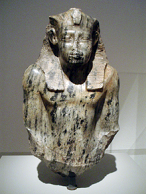
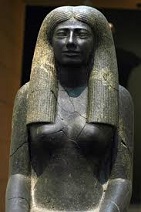
-1962 Amenemhat I is assassinated, and his son (by Nefertitanen) Senusret (Seostris) (Senwosret) I Kheperkare ("the Ka of Ra is created") (d. -1926) becomes king #4 of the Egyptian 12th Dynasty after rushing back from a military campaign in Libya, later sending two expeditions into Nubia in -1953 and -1943 which fix Egypt's S border at the 2nd Cataract, where he stations a garrison and erects a victory stele; high priest Djefaihapi (Djefaihap) (Hapdjefai) (Hapidjefa) (Hepzef) of Asyut (Lycopolis) in Upper Egypt leaves a statue of his wife Lady Sennuwy, which is discovered in 1912 C.E. by a Museum of Fine Arts-Harvard U.-sponsored expedition.
-1960 Puzur-Ashur I dies, and Shallum-Ahhe (d. -1945) becomes king of Ashur.
-1956 About this time Abraham moves from Ur of the Chaldees 600 mi. NW to the city of Harran in Paddan Aram in Upper Mesopotamia because Jehovah promises to make him a great nation (Gen. 15:7), and he travels with his half sister-wife Sarah (b. -1986) and his dad Terah (b. -2126) (Gen. 11:31), along with his childless adopted nephew Lot and his wife Pilah of Salt.
-1950 The Akhmim Tablets are inscribed with a list of servants' names and a series of grain computations.
-1945 Shallum-Ahhe dies, and Ilushuma (Ilu-shuma) (d. -1906) becomes king of Ashur, going on to free the "Akkadians and their children" of taxes.
-1934 According to legend, the Fir Bolg (Gael. "men of bags") (Belgae of N Gaul?) invade Ireland with 5K men at Wexford Harbor at the mouth of the Slaney River, with the (legendary) five sons of Dela dividing Ireland, Slaine (Sláine) (Sláinge) (Slánga) mac Dela becoming the first High King of Ireland, taking Leinster, and his older brothers Rudraige (Ruadhraighe) mac Dela taking Ulster, Gann mac Dela taking N Munster, Genann (Geanann) mac Dala taking Connacht, and Sengann (Seangann) mac Dela taking S Munster; Slaine only rules one year before dying at Dind Rig in County Carlow and being buried in Slane, County Meath, and is succeeded as high king by Rudraige (-1933 to -1931), Gann and Genann (-1931 to -1927), and Sengann (-1927 to -1921); Irish high kings are crowned on the sacred Hill of Tara (Teamhair) near the Boyne River, just S of where the Five Ancient Slighe (Roads) from the four provinces of Ireland meet at Lismullen.

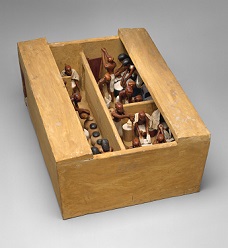

-1926 Senusret I dies, and his son co-pharaoh (since -1929) Amenemhet II (d. -1895) becomes king #3 of the Egyptian 12th Dynasty; during his reign the tomb of his PM Meketre contains a model bakery-brewery discovered on Mar. 17, 1920 by Am. Egyptologist Herbert Eustis Winlock (1884-1950).
-1925 Indattu II dies, and the Dynasty of Simashki in Elam (begun -2230) ends; the Dynasty of Eparti begins (ends -1400), with kings calling themselves "Great REgent" and "King of Anshan and Susa".
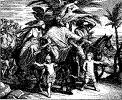
-1921 Xia Bu Jiang dies, and Xia Pian (d. -1900) becomes Xia king #12 of China. 205-y.-o. Terah (b. -2126), father of 75-y.-o. Abraham (b. -1996) dies, and Jehovah issues the epic Call of Abraham (who is still called Abram) (Gen. 12:1-3), so he moves his household to Canaan, crossing the Euphrates River on the 14th of Nisan (Gen. 11:32) near Carchemish, arriving in Shechem in the valley between Mount Gerizim and Mount Ebal (between Bethel and Dan W of the Jordan River near the Salt or Dead Sea), and makes a covenant with Jehovah concerning his seed (Gen. ch. 12), "To your seed I am going to give this land" (Gen. 12:6-7), and "All the families of the ground will certainly bless themselves by means of you", beginning the 430-year period of temporary residence until the making of the law covenant with Israel (Ex. 12:40-42, Gal. 3:17).
-1911 Lot is rescued; Abraham visits the mysterious priest-king Melchizedek (Heb. "king of righteousness"), king of Salem (Gen. 14:18-20, Psalms 110:4); first known priest of Jehovah (Yahweh) the Most High (El Elyon), one of the Seven Names of the Jewish God.
-1910 Birth of Ishmael (d. -1774) (Heb. "God hears") to 86-y.-o. Abraham (b. -1996) and his Egyptian maidservant-concubine Hagar (Gen. 16:3-16); father of the Ishmaelites (Arabs); "He will be a wild ass of a man, his hand against every man and every man's hand against him; and he shall dwell over against all his kinsmen" (Gen. 16:12); Ishmael's son Kedar (Gen. 25:13) is the ancestor of the Bedouins, known for their black tents ("I am black but comely... as the tents of Kedar" - Song of Solomon 1:5); Hagar is the first woman to be circumcised by Sarah to make her less sexually attractive.
-1909 Death of Arpachshad (b. -2346).
-1906 Ilushuma dies, and his son Erishum I (d. -1867) becomes king of Ashur, going on to establish a 900-mi. trade route for Assyrian cloth and tin from across the Tigris River to Kanish in Anatolia in exchange for bronze.

-1900 After the seasonal monsoons migrate E, the Sarasvati River dries up, and the center of civilization relocates from Harappa in Punjab to the 1,560-mi. Ganges River; violence and disease also play a role - die in it and get a free ride to paradise? The Kassites settle in modern-day W Iran in the region of Hamdan-Kermanshah. In this cent. the second wave of Achaeans invade Greece; the Thracians later claim their original home in thickly-forested Pieria near Mt. Olympus, home of the cult of the Muses, which spreads S to Mt. Helicon in Boeotia, where they grow from three to nine in number, and are considered daughters of Zeus and Mnemosyne, goddess of memory. The wild blonde dangly Greeks set up shop in the Me-Scene? About this time the city of Mycenae on the plain of Argolis in Greece (in NE Peloponnesus S of the Isthmus of Corinth, 55 mi. SW of Athens) is founded, going on to develop the Mycenaean Civlization (ends -1125), which strongly borrows from the Minoan civilization of nearby Crete by -1600, and by -1400 becomes supreme in the Aegean area, incl. the cities of Tiryns near Mycenae, Orchomenos, and Thebes in Boeotia (birthplace of Hercules), Athens in Attica (modern-day pop. 660K/3M), home of the Acropolis (Gr. "top of the city"), and Pylos in Messenia in SW Greece; the king is called the wanax, and the army cmdr. is called the lawagetas; the basileus and a priest class bring up the rear; Mycenaean supremacy continues until the fall of Troy (-1200), after which the Dorians (Gr. "conquerors") from the N destroy it and the survivors flee; the Gla Fortress protects the region; the architecture is based on huge rough-hewn "Cyclopean" stones, thought to be made by the Cyclops; the strongly-fortified palaces contain megara (large rectangular halls), and the warlike Mycenaeans are the first to use the safety pin; Homer later preserves the age in his "Iliad" and "Odyssey", and claims that Mycenae is the home of King Agamemnon; Heinrich Schliemann (1822-90) excavates Mycenae in 1868 C.E. Xia Pian dies, and Xia Li (d. -1879) becomes Xia king #13 of China. Migrants from India settle in Australia. In this cent. civilization begins in the Andes, centered around El Paraiso (Paraíso) ("Paradise") in the Chillon River Vally 1 mi. from the Pacific Ocean, a U-shaped complex of square bldgs. surrounded by tiers of platforms, with religious beliefs that use smoke and water to communicate with the spiritual world. Semitic Ge'ez speakers migrate from Yemen to Africa across the Bab-el-Mandeb (Arab. "Gateway of Tears"). In this cent. the earliest writings in Asia Minor are written, records of the Assyrian merchant colony in Kanesh in Cappadocia in SE Anatolia. Inventions: About this time the first known use of cryptography is in Menet Khufu in Egypt. About this time the first known drinking of chocolate (Nahuatl "xocolatl" = bitter water) beverages is by the Mokaya ("corn people") people in Mexico and Guatemala. Science: The Venus Tablets of Ammizaduga are among the earliest known astronomical records.
-1897 Jehovah makes his circumcision covenant with 99-y.-o. Abram (1996 to -1822), thanking him for the offering of tasty foreskins as a substitute for sacrificing the entire boy, and changing his name to Abraham (Heb. "Father is Exalted") (Gen. ch. 17), making him the major promise that "a father of a crowd of nations I will make you" (Gen. 17:5-27, Rom. 4:11). After some kind of sexual hanky panky goes down that pisses-off Jehovah (homosexuality?), Sodom and Gomorrah (part of the five cities of the plain incl. Admah, Zeboiim, and Zoar) are destroyed, and Abraham's nephew Lot and his two daughters barely escape, losing Lot's wife to pillarosis voyeurosa - Gen. Ch. 19. A famine causes Abraham and Sarah to go to the Philistine city of Gerar, only to have the king take 89-y.-o. Sarah (b. -1986) into his harem, but Jehovah gets her sprung (Gen. 18:16-21:7).
-1896 Birth of Isaac (d. -1717) (Heb. "laughter") to 100-y.-o. Abraham (b. -1996) and his 90-y.-o. wife Sarah (b. -1986) (Gen. 21); the first infant Jew to be circumcised - I'm not crying I'm laughing?

-1895 Amenemhet II dies, and his co-regent (since -1897) son Senusret (Seostris) II (d. -1878) becomes king #4 of the Egyptian 12th Dynasty, going on to build an extensive irrigation system in the Faiyum region from Bahr Yussef to Lake Moeris, with a dike at El-Lahun, to which he moves the royal necropolis from Dahshur, making it his capital; the first known Egyptian workers quarters is built in the nearby town of Senusrethotep (Kahun).
-1894 Amorite sheikh Sumu-Abum (d. -1881) conquers Babylon, declares its independence and becomes its king, founding the Old Babylonian Empire (ends -1595).
-1891 5-y.-o. Isaac (b. -1896) is weaned, and 19-y.-o. Ishmael (b. -1910) is sent away with his mother Hagar after he pokes fun at the little weenie, beginning 400 years of affliction upon Abraham's offspring (Gen. 21:8-21, 15:13, ch. 25; Gal. 4:29); they flee S and settle in the wilderness, where Ishmael marries an Egyptian woman, fathering 12 desert nomad tribes, the Ishmaelites, who occupy C and N Arabia; whether the Bible is true or a fairy tale, by the 6th cent. C.E. the Muslims, who regard themselves as descendents of Ishmael, start the Ishmael Conspiracy, reversing the Hebrew Bible and claiming that Hagar was Abraham's #1 wife, not Sarah, and that Ishmael was his favorite son, not Isaac, and that Abraham chose Ishmael, not Isaac to be sacrified, and not on Mt. Moriah in Palestine, but on Mt. Ararat near Mecca; others, such as Hal Lindsey (1929-) claim that Jacob's twin brother Esau mixed with the Ishmaelites to create the Arabs, and that Armageddon will be caused by what amounts to a family dispute - what about the restraining order?
-1881 Sumu-Abum dies, and Amorite Sumu-El (d. -1845) becomes king of Babylon.
-1879 Xia Li dies, and Xia Kung Jia (d. -1848) becomes Xia king #14 of China.

-1878 Senusret II dies, and his son (by Khenemetneferhedjet I) Senusret (Sesostris) III (d. -1839) becomes king #5 of the Egyptian 12th Dynasty, going on to reduce the power of regional rulers, and pacify the S frontier with Nubia, building massive 2nd Cataract forts at Buhen, Semna, and Uronarti, creating an era of peace and prosperity, with a revival in trade, urban development, and crafts, becoming one of the few pharaohs deified and honored with a cult during his lifetime; he digs an E-W canal through the Wadi Tumilat to join the First Cataract of the Nile River with the Red Sea, which reaches N to the Bitter Lakes at this time, allowing direct naval trade with Punt; although of Nubian origin, he bans Nubians from crossing the S end of the 2nd Nile Cataract into Egypt; Egypt goes on to dominate Nubia to about -1000, building Egyptian-style temples and making the aristocracy adopt Egyptian religions and hieroglyphics while taking gold, ebony, and ivory; meanwhile Nubians intermarry with Egyptians, so within a millennium they are almost indistinguishable. Abraham's 40-y.-o. son Isaac marries Abrahm's grandniece Rebekah (Rebecca) (Heb. "connection", "snare") from Mesopotamia (Gen. 24:1-67, 25:20); Abraham marries Keturah, and in the next 35 years fathers six more sons, adding the Midianites, Medianites (Heb. "strife") (Arab. "perserverance"), and other tribes to the Israelites, Ishmaelites, and Edomites (Gen. 25:1-2, 1 Chron. 1:28, 32-34).
-1871 Abraham takes his 25-y.-o. son Isaac (b. -1896) from Beer-sheba N to Mount Moriah (N of Salem) and offers him as a burnt sacrifice to Jehovah, believing that "God was able to raise him up even from the dead", but luckily Big J lets him substitute a ram at the last minute, and Big J is so pleased with the total package that he reinforces his covenant with a sworn oath (Gen. 22:1-18, Heb. 6:13-18; 11:17-19).
-1867 Erishum I dies, and his son Ikunum (d. -1860) becomes king of Ashur.
-1860 Ikunum dies, and his son Sargon ("the king is legitimate") I (Sharru-Kin) (Sharru-Ken) (d. -1850) becomes king of Ashur, refortifying Assur.
-1859 Death of Abraham's wife Sarah (b. -1986) at age 127 (Gen. 17:17, 23:1).
-1850 Sargon I dies, and his son Puzur-Ashur II (d. -1830) becomes king of Ashur. Science: The Egyptian 12th Dynasty Moscow (Golenishchev) Mathematical Papyrus contains 25 math problems.
-1849 Beginning of the reign of Sin-Iddinam (d. -1843), king of Larsa, Sumer, and Akkad, who leaves some nice terracotta cuneiform barrel cylinders to blow his horn.
-1848 Xia Kung Jia dies, and Xia Bo (d. -1837) becomes Xia king #15 of China.
-1847 Death of Noah's son Shem (b. -2446) in his 600th year (age 599).
-1845 Sumu-La-El dies, and Sabium (d. -1831) becomes king of Babylon.
-1843 Death of Sin-Iddinam.
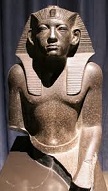
-1839 Senusret III dies, and his co-regent (since -1860) son Amenemhet (Amenemhat) III Nimaatre ("Belonging to the justice of Ra") (d. -1814) becomes king #6 of the Egyptian 12th Dynasty.
-1837 Xia Bo dies, and Xia Fa (d. -1818) becomes Xia king #16 of China.
-1836 Abraham (b. -1996) is 160 years old; birth of 60-y.-o. Isaac's (b. -1896) twin sons "wild man" Esau and "blameless" Jacob (Israel) (d. -1690) after struggling in their mother Rebekah's womb, causing Jehovah to tell her that two nat. groups would be separated from her inward parts and that the older will serve the younger (Gen. 25:22-26).
-1833 A solar eclipse is recorded in the limmu of Puzur-Ishtar.
-1831 Sabium dies, and Apil-Sin (d. -1813) becomes king of Babylon.
-1830 Naram-Sin (d. -1815), king of Eshunna conquers Assyria and becomes king of Ashur.
-1822 About this time the Babylonian clay tblet Plimpton 322 Table (-1762?) in Larsa, Iraq (modern-day Tell as-senkereh) shows an advanced knowledge of trigonometry incl. Pythagorean triples; they don't base their math on angles but on sexagesimal arithmetic, giving exact results.
-1821 Abraham (b. -1996) dies at age 175 (Gen. 25:7) after making his son Isaac his sole heir (Gen. 25:5-6); he is buried by his sons Isaac and Ishmael in the cave of Machpelah in Hebron where he had earlier buried his wife Sarah (Gen. 23:1-20, 25:7-10); his grandson (son of Isaac) Jacob is 15 years old, and somewhen from now he gets his hairy brother Esau to sell him his birthright as firstborn for a "swallow of the red" (lentil stew), because "Esau despised his birthright" (Gen. 25:29-34); Esau later gets the nickname Edom (Red) (Gen. 25:25-30); the Cave of the Patriarchs in Hebron, where Abraham and Sara are buried becomes a holy site for Jews and Muslims.
-1818 Xia Fa dies, and Xia Jie (Hsia Chieh) (the Tyrant) becomes Xia king #17 of China; the first cruel Chinese king, he amuses himself by having 3K people drowned in a lake of wine - cruel, or euthanasia?
-1815 Naram-Sin dies, and Erishum II (d. -1809) becomes king of Ashur.
-1814 Amenemhet III dies, and his co-regent (since -1815) son Amenemhet (Amenemhat) (Ammenemes) IV (d. -1806) becomes king #7 of the Egyptian 12th Dynasty, going on to send expeditions to Sinai for turquoise and Upper Egypt for amethyst, building the Temple of Renenutet in Medinet Madi, and a great labyrinth "near the place called the City of Crocodiles" near Lake Moeris, described by Herodotus as surpassing the pyramids; too bad, it is lost (until ?).
-1813 Apil-Sin dies, and Sin-Muballit (d. -1793) becomes king #5 of Babylon.
-1809 Shamshi-Adad I (d. -1781), king of Ekallatum conquers Ashur and becomes king of the first Assyrian Empire.
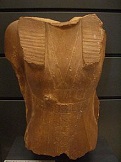
-1806 Amenemhet IV dies, and his sister Sobeknefru (Neferusobek) (Sobekkare) ("The beauty of Sobek") (Skemiophris) (d. -1802) becomes king #8 (last) of the Egyptian 12th Dynasty.
-1805 The Egyptian Fourteenth (14th) Dynasty (ends -1650) is founded, with capital in Avaris in the NE Nile Delta; the 30+ pharaohs are of Canaanite or W Semitic descent; famine, which began in the late 13th Dynasty plagues this dynasty and the 16th Dynasty.

-1803 Sekhemre Khutawy Sobekhotep I (d. -1800). becomes king #1 of the 30-king Egyptian Thirteenth (13th) Dynasty (ends 1718?), based in Memphis, which leaves few monuments, making it hard to determine the chronology; Wegaf (Ugaf) Khutawyre (d. -1757) is the real king #1, not #19?


-1800 About this time the Middle Bronze Age Cold Epoch begins (ends -1500), bringing unusually cold climate to the North Atlantic region, along with severe volcanic eruptions in Mt. Vesuvius (-1660), Mount Aniakchak (-1645), and Mt. Thera in Minoa (-1620). The Day of the Aryans? About this time after the invention of the chariot, the white-is-right Aryan Migration (Invasion) of Indo-Iranian Medes, Persians, Parthians, Bactrians, and Arachosians from S Russia through Afghanistan into the Iranian Plateau begins (ends -850), while more Aryan tribes invade N India, setting up a white supremacist religious civilization based on several kingdoms run by rajahs, and hierarchical social classes of priests, warriors, farmers, traders, and Dravidians (dark skinned non-Aryans). About this time the basic genome of the Irish is formed from a mixture of migrant Stone Age farmers from the Fertile Crescent, and Bronze Age settlers from E Europe. About this time Hittite King Pitkhana (Pitkhanas) of Kussara in SE Anatolia and his son Anitta (Anittas) sack several Hattic cities, incl. Hattusas and Kanesh; Anittas makes Kanesh his new capital, and lays a curse upon Hattusas, causing trade to break down, and the Old Assyrian Trade Network (founded -2000) to break up by -1750? About this time the Assyrian city of Nineveh ("exceedingly great city") (founded -3000?) on the E bank of the Tigris River in Upper Mesopotamia near modern-day Mosul, Iraq is first mentioned as an important center for worship of the Mesopotamian goddess Ishtar; too bad, it lies on a fault line and suffers a number of earthquakes; in 612 B.C.E. after becoming the largest city in the world 50 years earlier, it is abandoned after a civil war and sacked by a coalition of former subject peoples incl. the Babylonians, Medes, Chaldeans, Persians, Scythians, and Cimmerians. The Initial Period begins in Peru (ends -900), with permanent villages, pottery use, and social and religious org. The Bronze Age begins in Ulster; during the Bronze Age tin begins to be mined in Cornwall in SW England, furnishing Phoenicians with one of their favorite articles of trade, although they carry on their trade with them indirectly via Gaul; Britain becomes known as the Cassiterites (Tin Islands). About this time the Akkadian epic Atra-Hasis ("exceedingly wise") is written on three clay tables, containing an account of the Creation and a great deluge; it mentions a god with planning capacity called Alla (Ilaweila), who led a rebellion against chief god Enlil (Elil) and was slaughtered and his flesh and blood used to create humanity; a copy is found dated to Hammurabi's great-grandson Ammi-Saduqa (-1646 to -1626), and another is discovered in the 7th cent. B.C.E. Library of Ashurbanipal; some claim he might be the Muslim god Allah since the Akkadians originally lived in Arabia. About this time a tablet contains a Hymn to Ninkasi, the Sumerian goddess of beer; "Ninkasi, you are the one who pours out the filtered beer of the collector vat. It is like the onrush of the Tigris and Euphrates." Inventions: About this time Semitic workers in the Sinai invent Alphabetic writing by modifying Egyptian hieratic glyphs. About this time the Minoans of Crete invent Linear A Script. Architecture: About this time Stonehenge (begun -2800) in England is completed, designed to predict eclipses of the Sun and Moon as well as solstices and seasons; on sunrise at the summer solstice the Sun comes right down the aisle of small stones in the center, as shown by English astronomer Gerald Stanley Hawkins (1928-2003); UNESCO adds it to its list of World Heritage Sites in 1986 - where it shines on the sacrifice table so the Druids can insure another cycle of seasons?
-1796 Shamshi-Adad I conquers Mari, and installs his son as king. Esau marries pagan Hittite women Judith (Oholibamah) and Basemath (Adah) (Gen. 26:34-35, 36:2; 24:1-4,50-51), who turn out bad.

-1793 Sin-Muballit dies, and his infant son Hammurabi (Hammurapi) (-1795 to -1750) becomes king #6 of the first Babylonian dynasty, going on to extend his control over Mesopotamia and found the Babylonian Empire.
-1787 Hammurabi conquers Isin, but fails to capture Uruk.

-1786 Wegaf dies, and Ameny Intef IV (d. -1760) becomes king #2 of the Egyptian 13th Dynasty.
-1783 The army of Shang Tang (d. -1753) surrounds decadent king Xia Jie (Hsia Chieh) at Xia Tai, and he is captured and exiled to Nanchao; the Hsia Dynasty (begun -2205) ends, and the Shang Dynasty begins (ends -1050), with capital at Anyang in the N Henan province, building walled cities with temples, and known for priest-kings who use elaborate bronze containers with bowed handles in their religious ceremonies - ah, you're no rich prince?
-1781 Shamshi-Adad I is killed in battle, and his son Ishme-Dagan I (d. -1741) becomes king of Ashur.
-1779 Hammurabi forms a coalition with Larsa and Mari against Ashur and Elam.
-1775 Mari, Elam and Babylon sack Eshunna; Elam sacks Ekallatum and Shubat-Enlil.
-1774 Death of Ishmael (b. -1910) (Gen. 25:17).
-1771 Eshunna occupies Ekallatum.
-1768 After being pushed out by the Hittites, the Hyksos (Egyptian "rulers of the foreign countries") from W Asia, AKA the shepherd kings, a Syrian group that incl. Semites from Palestine invade the NE Nile Delta and set themselves up in a city called Avaris, where they introduce the horse and chariot; the Middle Kingdom of Egypt ends along with the Egyptian 12th Dynasty, and the Second Intermediate Period begins, incl. the Egyptian 13th-17th Dynasties (ends -1570).
-1765 King Hammurabi begins his wars of conquest (ends -1750).
-1764 Hammurabi crushes an invading army from Elam, Assyria, Gutium, and Eshunna.
-1763 Hammurabi conquers Larsa.
-1762 Hammurabi sweeps through Sumer.

-1760 Hammurabi defeats a coalition of Elam, Eshunna, Assyria and Gutium, captures Eshunna and reaches the Assyrian frontier; he makes Mari a vassal. Ameny Intef IV dies, and Hor (Awibre) (Aubrire) (d. -1750) becomes king #3 of the Egyptian 13th Dynasty.
-1759 Neferusobek dies. Isaac's 77-y.-o. son Jacob (b. -1836) flees Beer-sheba to Haran, the land of his forebears, and 62 mi. down the path he stops at Luz in the Judean hills, using a stone for his pillow, then dreams of Jacob's Ladder, upon which angels descend and ascend, and at the top of which is Jehovah, who confirms the divine covenant made with Abraham and Isaac (Gen. 28:11-13, 30, 31), uttering the immortal soundbyte: "By means of you and your seed all the families of the earth will certainly bless themselves", and how his seed will become like the dust particles of the Earth in number (Gen. 28:13-15), this wows him so much that he renames the place to Bethel (Beth El) (House of God), and he sets up and annoints a stone pillar, and promises to give him tithes (one-tenth) (Gen. 28:16-22); he spends 20 years in Haran.
-1758 Mari revolts, and Hammurabi destroys their city.
-1755 Babylon conquers Assyria and makes it a vassal; Hammurabi takes the title "King of Sumer and Akkad, King of the Four Quarters of the World" - Ham Studly?
-1753 Shang Tang dies, and Shang Tai Jia (d. -1720) becomes Shang king #2 of China.
-1752 Kutur-Nahhunte I of the Eparta Dynasty in Elam conquers S Babylonia; his country has large Akkadian and Amorite minorities. 84-y.-o. Jacob (b. -1836) marries his first cousins Leah (Heb. "weary") and Rachel (Heb. "ewe") (his favorite) (Gen. 29); actually, he worked seven years to pay father Laban for Rachel, but daddy reneges at the last minute and gives him the older hag Leah, but then throws Rachel in for another seven years of work, and kicks in fertile maidservants Bilhah and Zilpah; during the next seven years Jacob is blessed with many children (Gen. 29:30-30:34), incl. four sons from Leah, 1: Reuben ("behold, a son"), 2: Simeon ("listening intently"), 3: Levi ("joined") and 4: Judah ("praise"); two sons from barren Rachel's substitute slave girl Bilhah, 5: Dan ("God is my judge") and 6: Naphtali ("my struggle"); and two sons from barren Leah's substitute slave girl Zilpah, 7: Gad ("soldier", "luck"), 8: Asher ("felicitous"); Leah then goes fertile and bears 9: Issachar ("laughter"), 10: Zebulon ("give honor to"), and daughter Dinah ("justified"); Rachel follows suit and bears 11: Joseph ("Jehovah increases"), "son of Jacob's old age", followed sometime after the 7-year period by 12: Benjamin ("son of the right hand"); sometime after Rachel, wife of Joseph (Israel) (d. -1738) bears her 2nd son Benjamin and dies during childbirth (Gen. 35:16-20), and eldest son Reuben hooks up with daddy's concubine Bilhah (mother of Dan and Naphtali), causing him to lose the firstborn's birthright (Gen. 35: 21-26, 49:3-4, Deut. 27:20, 1 Chron. 5:1), 17-y.-o. Joseph is seized by his jealous brothers at Dothan 62 mi. N of Hebron and, at the suggestion of Reuben, pitched into a dry well (Gen. 37:2-24), then, at the insistence of Judah, is sold into slavery in Egypt to some passing Ishmaelites (ancestors of Muhammad?) for 20 pieces of silver (Gen. 37:28; 42:21); the bad boys bad boys whatchya gonna do lie to daddy that he had been killed by a wild animal (Gen. 37:31-33), and they all start suffering from a bad conscience; Judah then parts ways with his brothers and tents near Hirah the Adullamite, marries the daughter of Canaanite Shua, and has sons Er, Onan, and Shelah (the latter born at Achzib) (Gen. 38:1-5); Judah then selects Tamar to marry his firstborn Er, but Jehovah kills him for being bad, and then Judah orders second son Onan to do his duty and perform brother-in-law marrage, but the latter on his wedding night "wasted his semen on the earth so as not to give offspring to his brother", causing Jehovah to kill him, and Tamar returns to her daddy's house until youngest son Shelah grows up, but later Joseph fears he might also be a coitus interruptus executus case and reneges (Gen. 38:61-4); but the story doesn't end there; after Judah becomes a widower, Tamar disguises herself as a ho at the entrance of Enaim on the road to Timnah, and he buys her services, and when he finds out that the virgin bride Tamar is suddenly preggers, he goes nonlinear and demands that she be burned, until she tells him the gospel truth that he is the daddy, causing him to about face and exclaim, "She is more righteous than I am, for the reason that I did not give her to Shelah my son" (Gen. 38:12-23); 6 mo. later she bears twin sons Perez ("perineal rupture") and Zerah, who fight to get out first, with Perez winning, but rupturing you know what (Gen. 38:24-30); Perez becomes the more famous of the two (Ruth 4:12), and later has sons Hezron and Hamul (Gen. 46:8-12), Hezron being in the direct line through Boaz to David and Jesus (Ruth 4:18-22; 1 Chron. 2:4-15; Mt. 1:3; Luke 3:3); Hezron has three sons, the key one (not the eldest) being Ram (Aram) (Arni) ("high") (1 Chron. 2:4-5; 9-25); when Hezron dies, his widow Abijah bears Ashur, father of Tekoah (1 Chron. 2:24) (when he was little they called him Ass?); Ram has son Amminadab ("my people are noble") (1 Chron. 2:10); Amminadab has son Nahshon ("serpent") (Num. 1:7; 7:11-2), who heads Judah's army of 74.6K that leads Israel's line of march; Nahshon bears son Salmon (Salma), who marries Rahab of Jericho (1 Chron. 2:11; Num. 2:3; Ruth 4:20-22; Mt. 1:4-5; Luke 3:32); Salmon bears son Boaz ("in strength", "swiftness") (Ruth 2:1), who in the 14th cent. B.C. (300-year Period of the Judges) marries the childless Moabite widow Ruth, together having son Obed ("servant") (Ruth 4:13-22; 1 Chron. 2:12; Mt. 1:5; Luke 3:32); Obed has son Jesse ("Jehovah makes forget") (Ruth 4:17-22; Mt. 1:5-6; Luke 3:31-2); Jesse, a sheep raiser living in Bethlehem has eight sons, ending with red-headed kinnor-playing David (-1085 to -1015) (Heb. "beloved"), whom Judge Samuel picks as the 2nd Jewish king (1 Sam. 16:1-13); too bad, there is no answer as to just where they fall on the Great Track of Time, so it's hard to not place it all in fairy tale land?

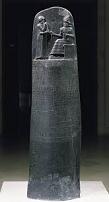
-1750 On June 16 Babylonian king (since -1792) Hammurabi (b. -1795) dies, leaving his famous 282 Laws (Code) of Hammurabi, which are reconstructed by Am. archeologist Francis R. Steele (1914-2003) in 1947; they incl. the death sentence for robbery, the Biblical "eye for an eye" law, lopping off the hand of a son who strikes his father, and laws regulating beermaking (20 varieties) and tavernkeeping; the 7-tablet Enuma Elish ("when on high") Babylonian creation myth dates to Hammurabi's reign, about a battle between the gods over the supremacy of Marduk, and the creation of mankind; Hammurabi's son Samsu-Iluna (d. -1712) becomes king of the great empire of Babylon, which immediately begins to disintegrate. Hor dies, and Sobekhotep II becomes king #4 of the Egyptian 13th Dynasty. The first known consumer service complaint is by Babylonian consumer Nanni, who complains to Ea-nasir of a shipment of inferior copper ore.
-1748 Abraham (b. -1996) is 248 years old; Jacob (later Israel) (b. -1836) is 88 years old; Jacob's 4th son (by his wife Leah) Judah (Heb. "lauded") (root of the royal line of King David) is born in Paddan-aram in Haran (Gen. 29:35; 1 Chron. 2:1).
-1747 Khendjer ("boar") becomes king #5 of the Egyptian 13th Dynasty.

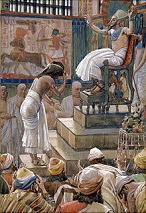
-1745 Sobekhotep III becomes king #6 of the Egyptian 13th Dynasty. Birth of Joseph (d. -1636) (Heb. "remover", "increaser") (Gen. ch. 30) on Tammuz 1 to 91-y.-o. Jacob (Israel) (b. -1836) (11th of 12 sons); known for his Coat of Many Colors; he ends up receiving the right of the firstborn (Deut. 21:17) (a double portion of the inheritance), rising to grand vizier, and fathering two tribes, Ephraim and Manasseh (W of the Jordan River to the Mediterranean, incl. the Plain of Sharon), which become the most prominent tribes; in modern times the Latter-Day Saints claim to be of the tribe of Ephraim.


-1741 Neferhotep I (d. -1730) becomes king #7 of the Egyptian 13th Dynasty. King Ishme-Dagan I of Ashur dies. Rim-Sin II (d. -1736) becomes king of Larsa, founding the Second Larsa Dynasty, and waging a rebellion against Babylon.
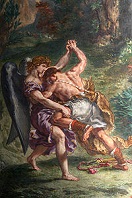
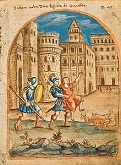
-1739 97-y.-o. Jacob (b. -1836) returns to Canaan from Haran with his family (incl. 9-y.-o. Judah), wrestles with an angel all night at the rest stop of Peniel (Penuel) ("face of God") near Succoth E of the Jordan River and S of the torrent valley of Jabbok, during which the angel "touches his thigh", causing a permanent limp, and after the angel wins he confirms Jacob as a prince of men and (surprise?) Jehovah renames him Israel ("Contender with God") (Gen. 31, 32) (some gay action going on and covered up?); the family resides at Succoth, then Shechem, where his daughter (by first wife Leah) Dinah (Heb. "judged, vindicated") is raped by the son of Hamor, causing her brothers Simeon and Levi to avenge her by killing all the males of Shechem, followed by plunder of the city, in which Judah takes part (Gen. 33:17-18, 34:1-2,25-29).
-1736 Rim-Sin II of Larsa is captured by the Babylons under Hammurabi and executed; Hammurabi becomes sole ruler of Sumer and Akkad, ending the independence of Sumeria, although its civilization is absorbed by the Babylonians.
-1735 King Dadusha of Eshunna is the first to promulgate laws in the Babylonian language.
-1732 Iluma-Ilu (d. -1700) revolts from Babylon in S Sumer and founds the Sealand Dynasty (2nd Babylonian Dynasty) (ends -1460).
-1730 Neferhotep I dies, and his Thebes-born brother Sobekhotep IV Khaneferre (d. -1720) becomes king #8 of the Egyptian 13th Dynasty, leading a military campaign into Nubia. Mut-Ashkur (d. -1720) becomes king #1 of Ashur, which revolts from Babylon and gains its independence. Iqishi-Tishpak becomes king of Eshunna. Gandash (Kandis) of Mari (d. -1705) founds the Kassite Dynasty in the Zagros Mts. of Lorestan, Iran.
-1720 Sobekhotep IV dies, and Ay becomes king #9 king of the Egyptian 13th Dynasty. Shang Tai Jia dies, and Shang Wo Ding (d. -1691) becomes Shang king #3 of China. Mut-Ashkur dies, and Rimush (d. -1710) becomes king of Ashur.
-1717 Death of Isaac (b. -1896) in his 180th year (Gen. 35:28-29).
-1715 Samsu-Iluna crushes an invading Kassite army.
-1712 Samsu-Iluna dies, and next year his son Abi-Eshuh (d. -1684) becomes king of Babylon.
-1710 Rimush dies, and Asinum (d. -1706) becomes king of Ashur.
-1706 Asinum dies, and seven usurpers fight for the throne of Ashur. Jacob (Israel) leaves Beer-sheba with his whole family and goes to Egypt after Jehovah promies to "make of you a great nation" (Gen. ch. 46).
-1705 Nehesy (Nehesi) ("the Nubian") Aasehre becomes king #6 (#2?) of the Egyptian 14th Dynasty, ruling less than 1 year, becoming the best-attested king of the dynasty, leaving his name on two monuments in Avaris.
Gandash dies, and Agum I (d. -1690) becomes king of Mari. 40-y.-o. Joseph (b. -1745) is made grand vizier (PM) of Egypt (Gen. ch. 41).-1700 About this time a civil war begins in Crete, ending the First Palace Period, and beginning the Second Palace Period (ends -1420), featuring palaces with the earliest known controlled water pressure. The Hurrian Conquests begin (end -1500). Belu-Bani (d. -1691), son of Adasi becomes king of Ashur. Iluma-Iluma dies, and Itti-Ili-Nibi (d. -1683) becomes king of Sealand. About this time the Jebusites fortify Jerusalem with stone walls. The oldest known boatyard is built in Monmouth, South Wales. The Sumerian Simmons Tablet, is written, describing a Biblical-type flood and saying that the ark is circular and made of reeds; found by British RAF member Leonard Simmons during WWII. Tel Kabri in N Israel is the oldest known wine cellar, containing 40 50-liter jars.
-1691 Shang Wo Ding dies, and Shang Tai Kang (d. -1666) becomes Shang king #4 of China. Belu-Bani dies, and his son Libaia (d. -1674) becomes king #27 of Ashur.
-1690 Agum I dies, and Kashtiliash I (d. -1680), king of Hana becomes king of Mari. Death of Jacob (Israel) (b. -1836) in his 147th year (age 146) (Gen. 47:28).
-1684 Abi-Eshuh dies, and Ammi-Ditana (d. -1647) becomes king of Babylon.
-1683 Itti-Illi-Nibi dies, and Damiq-Ilushu (d. -1657) becomes king of Sealand.
-1680 Kashtiliash I dies, and Ushshi (d. -1665) becomes king of Mari. About this time Labarnas (Labarna) I announces the brand-spanking new Old Hittite (Hatti) Kingdom (ends -1500) E of the Halys River on the C plateau of Anatolia (Asia Minor), developing iron-working, which gives his troops the mojo to cross the Taurus Mts. and tirelessly wage war on Syria and Assyria in a land grab in the Anatolian Peninsula; the land of Ebla in N Syria is "shattered like a ceramic vase"; in 1098 C.E. Crusaders mention seeing the ruins of Ebla (Mardikh) 40 mi. S of Aleppo. The Hurrians occupy Assyria. Alt. date for the beginning of Hyksos rule in NE Egypt (ends -1580).
-1674 Libaia dies, and Sharma-Adad I (d. -1662) becomes king of Ashur.
-1666 Shang Tai Kang dies, and Shang Xiao Jia (d. -1649) becomes Shang king #5 of China.
-1665 Ushshi dies, and Abirattash (d. -1650) becomes king of Mari.
-1662 Sharma-Adad I dies, and his son Iptar-Sin (d. -1650) becomes king of Ashur.
-1660 About this time Hattusilis (Hattusili) I moves the Hittite capital to Hattusas (Hattusa) (modern-day Boghazkoy) on the bend of the Halys River, and conquers the fertile Konya plain in the C Anatolian plateau S of the great Salt Lake (Tuz Gol), which becomes the center of the Hittite Empire, then overcomes Alalakh (Alalah) in N Syria near Antakya (Antioch), and campaigns in Arzawa (Assuwa) (later known as Lydia) in the four fertile river valleys of W Anatolia.
-1657 Damiq-Ilushu dies after losing Uruk, Isin and Larsa to Babylon, and Ishkibal (d. -1642) becomes king of Sealand.

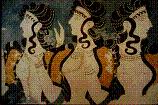
-1650 The 6-king Egyptian Fifteenth (15th) Dynasty (ends -1550), based in Avaris is founded by the Hyksos after they infiltrate from the NE; the Second Intermediate Period begins (until -1550), during which Egypt is in chaos, continuing through the 17th Dynasty; the 30+-king Egyptian Sixteenth (16th) Dynasty (ends -1580), based in Thebes is founded, facing encroachment from the 16th Dynasty, which evenutally conquers Thebes itself; one possible 16th Dynasty pharaoh is Senusret IV Seneferibre, whose colossal (2m) pink granite statue in Karnak is discovered in 1901. Iptar-Sin dies, and his son Bazaia (d. -1622) becomes king of Ashur. Abirattash dies, and Kashtiliash II (d. -1640) becomes king of Mari. The Middle Helladic Period of Greece ends, and the Late Helladic Period of Greece begins (ends -1150), characterized by the rise of Mycenaean Greece. About this time the Egyptian Mathematical Leather Roll is written, a practice test for students on fractions; also the Rhind Papyrus, which contains mathematical problems. About this time the Blue Ladies Fresco is painted on a bedroom wall of Pasiphae in Knossos, Crete.
-1649 Shang Xiao Jia dies, and Shang Yong Ji (d. -1637) becomes Shang king #6 of China.
-1647 Ammi-Ditani dies after Uruk, Isin and Larsa, and Ammi-Saduqa (Ammizaduga) (d. -1626) becomes king of Babylon.
-1642 Ishkibal dies, and Shushshi (d. -1618) becomes king of Sealand.
-1640 Kashtiliash II dies, and Urzigurumash (d. -1630) becomes king of Mari.
-1637 Shang Yong Ji dies, and Shang Tai Wu (d. -1562) becomes Shang king #7 of China.
-1636 Death of Joseph (b. -1745) at age 110 (Gen. 50:26) after reconciling his family and persuading the Hebrews to settle in Goshen in the Nile Delta in NE Egypt, the most lush area, where they begin to outnumber and outprosper the Egyptians, making them jealous (Ex. Ch. 1) - the original Florida and Palm Springs?
-1630 Urzigurumash dies, and Harbashihu (d. -1600) becomes king of Mari.


-1627 About this time the volcano on the island of Thera AKA Santorini in the Aegean Sea 100 mi. SE of Athens erupts, causing half of the island to sink into the sea, along with a city in the Bay of Naples, becoming the greatest vocanic eruption in ancient times; a tsunami hits Crete, destroying the Minoan fleet, dealing their civilization a lethal blow; ditto the Hyksos; in 1967 Greek archeologist Spyridon Nikolaou Marinatos (1901-74) discovers remains of a Minoan civilization in Akrotiri in SW Santorini, incl. a sewage and freshwater system, and 3-story bldgs. with indoor bathrooms and toilets, along with frescoes of blue monkeys, which are unearthed in the 1960s and 1970s and turn out to be Hanuman (gray) langurs from the Indian subcontinent 2.5K mi. away; the explosion is the origin of the Atlantis legend of Plato, according to Greek seismologist Angelos Galanopoulos; frescoes found in Thera show a goddess presiding over the manufacture of drugs from the saffron flower (Crocus sativus); each flower has three stigmas, and it takes 150 flowers to yield 1g of dry saffron threads, which currently cost $1K per lb.; Atlantis is really in Morocco?
-1626 Ammi-Saduqa dies, and Samsu-Ditana (d. -1595) becomes the last king of the First Babylonian Dynasty.
-1622 Bazaia dies, and Lullai (d. -1618) becomes king of Ashur.

-1620 The Hittites under Labarnas I's adopted grandson Mursilis (Murshili) I (d. -1590) defeat a Hurrian army, destroy Aleppo, then march S into Mesopotamia.
-1618 Lullai dies, and his son Kidin-Ninua (Shu-Ninua) (d. -1602) becomes king of Ashur. Shushshi dies, and Gulkishar (d. -1592) becomes king of Sealand.
-1602 Kidin-Ninua dies, and Sharma-Adad II (d. -1598) becomes king of Ashur.
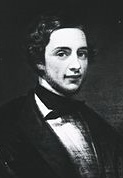

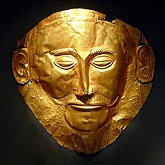
-1600 About this year a revolt against the foreign-invader Hyksos (which incl. the original Jews?) spreads throughout Egypt, which begins its growth into a world power; the Kingdom of Kush (Cush) (Nubia), located at the confluence of the Blue Nile, White Nile, and Atbara Rivers in modern-day Sudan is conquered by the Egyptians, who govern it with a viceroy until 1070 B.C.E., when the New Kingdom disintegrates and it gains its independence, with capital at Napata on the W bank of the Nile River near modern-day Karima, Sudan (250 mi. N of Khartoum). Harbashihu dies, and Tiptakzi (d. -1595) becomes king of Mari. About this time the heretofore-poor pop. of mainland Greece (Mycenae), known for small villages of mud-brick houses begin building opulent tombs in Grave Circle A filled with weapons, jewelry, golden death masks, incl. the golden Mask of Agamemnon (1500 B.C.E.), discovered by Heinrich Schliemann in 1876; not the real Agamemnon. About this time the Minoans of Crete develop the chariot army. The Bronze Age Gamla Folk found a civilization in Zealand (ends -600), with the mild climate allowing a Great Circle route across the Arctic Ocean to America. About this time the oldest surgical treatise on trauma to survive to modern times, the Edwin Smith Papyrus is written during the Egyptian Second Intermediate Period (by first known physician Imhotep?), describing 48 cases of injuries, fractures, wounds, dislocations, and tumors, with treatment and prognosis, incl. closing wounds with sutures, using honey and moldy bread as antiseptics, stopping bleeding with raw meat, and immobilization for head and spinal cord injuries; magic is left as a last resort; it also contains detailed anatomical observations but shows no understanding of organ functions; the earliest known reference to cancers or ulcers of the breast; discovered in Luxor in 1862 C.E. by Am. antiquities dealer Edwin Smith (1822-1906). The 32 cm Nebra Disk in Germany, 15 mi. from the Goseck Circle contains the oldest known realistic representation of the heavens, with a crescent Moon, full Moon, and a cluster of seven stars representing the Seven Sisters (Pleiades). About this time writing is invented in China, 2K years behind the Mesopotamia and Egypt. About this time the Semitic seafaring Phoenicians begin making bromine-based Tyrian purple (red) red-purple dye from secretions of the spiny dye-murex sea snail (marine gastropod) of the family Muricidae (Murex brandaris), also the bandex dye-murex (Hexaplex trunculus), and the rock-shell Stramonita haemastoma; it requires so many snails to make that "purple for dyes fetched its weight in silver at Colophon" (Theopompus); traders use purple sails so that they won't be bothered, since everybody wants their product; the color gets brighter with weathering and sunlight; the Byzantines later make it a capital crime for anybody but the emperor to wear it, and build the royal birthing apt. out of purple-red porphyry. About this time the Sumerian Creation Myth (Eridu Genesis) is written in Nippur; Ziusudra (Zin-Suddu) (Xisuthros) ("found long life"), last king of Sumer before the Deluge is the hero. About this time cacao trees (Criollo) are domesticated in the Amazon River basin near the border of S Colombia and N Ecuador from the ancient germplasm Cuaray. About this time Mesoamericans use vulcanized rubber for balls and other objects?
-1598 Sharma-Adad II dies, and Erishum III (d. -1586) becomes king of Ashur.
-1596 Senakhtenre ("perpetuated like Ra") Tao I becomes king #4 of Egypt's 17th Dynasty (until -1591).
-1595 The Hittites under Mursilis I sack Babylon, killing King Samsu-Ditana and bringing down the First Dynasty, then return to Hattusas because of political disturbances (and/or supply lines too long?); Mursilis is assassinated in a coup, and the Hittite Empire begins to go downhill (until -1400) as the Hurrians and Arzawans contract their territory; Tiptakzi dies, and Agum II Kakrime (d. -1545) becomes king of Mari; he goes on to conquer Babylon after the Hittites withdraw, and founds the Third Kassite Dynasty; Gulkishar of Sealand reconquers S Sumer from Babylon.
-1592 Gulkishar dies, and Gishen (d. -1580) becomes king of Sealand.

-1591 Job's trial takes place (Book of Job 1:8, 42:16) in the Land of Uz, really Edom (Teman) SE of the Dead Sea; Job is really King Jobab ben Zerah of Edom, who rules from Bozrah ("sheepfold") (modern-day Bouseira, Jordan), homeland of Jacob's twin brother Esau; Job's Edomite friends are Eliphaz (Heb. "El is pure gold") of Teman, a descendant of Teman, son of Esau's eldest son Eliphaz, Bildad, descendant of Shuah, son of Abraham and Keturah, and Zophar (Heb. "rising early/chirping") from Naamah in Canaan.
-1586 Erishum III dies, and his son Shamshi-Adad II (d. -1580) becomes king of Ashur.

-1580 The 9-king Seventeenth (17th) Egyptian Dynasty begins (ends -1550), based in Thebes; king #1 might be Sekhemrewahkhau Rahotep, who leaves a stele in Coptos celebration his restoration of the Temple of Min. Shamshi-Adad II dies, and his son Ishme-Dagan II (d. -1564) becomes king of Ashur. Gishen dies, and Peshgaldaramash (d. -1530) becomes king of Sealand. Alt. date for the end of Hyksos rule in N Egypt. About this time Egyptian (Theban) princess Ahmose Meryet Amon becomes the earliest known human diagnosed with coronary artery disease. Musical instruments from W Asia are introduced into Egypt, incl. the trumpet, lyre, oboe, and drum.
-1576 Possible date for the birth of Moses (d. -1456).
-1575 Birth of Aaron (d. -1452), son of Amram (Heb. "friend of the most high") and Jochebed (Heb. "Jehovah is glory") of the Jewish tribe of Levi (his great-grandfather) in Egypt (Ex. 6:13-30); his elder sister is Miriam, and his younger brother by three years is Moses (Ex. 2:1-4; 7:7); Aaron marries Elisheba, daughter of Amminadab, and has sons Nadab, Abihu, Eleazar, and Ithamar (Ex. 6:23), and lives to age 123 (Num. 33:39).
-1571 Birth of Israel's first Messiah, nat. leader, mediator of the Law covenant, prophet, judge, commander, writer-historian, "Man of the True God" (Ezra 3:2), the original "Go Down Kid", Mo Mo Moses (d. -1451) (Egyptian "is born", "son of", "drawn out" ,"saved out of water") (Ex. 7:7; 1 Ki. 6:1) in Goshen, Egypt; son of Amram (of the Jewish tribe of Levi) and Jochebed (sister of Kohah) (Ex. 2:2); grandson of Kohath; great-grandson of Levi; husband of Zipporah; father of Germhom and Eliezer; "By far the meekest of all the men who were upon the surface of the Earth" (Num. 12:3); a "divinely beautiful" infant, he is hidden by his mother for 3 mo. to spare him from a genocidal decree of Pharaoh, and floated in a papyrus ark (basket) down the Nile, where Pharaoh's daughter finds and raises him, with his real mother as nurse, while the tyke is "instructed in all the wisdom of the Egyptians", becoming "powerful in his words and deeds" (Ex. 2:1-10; Acts 7:20-22).
-1564 Ishme-Dagan III dies, and his son Shamshi-Adad III (d. -1547) becomes king of Ashur.
-1562 Shang Tai Wu dies, and Shang Zhong Ding (d. -1549) becomes Shang king #8 of China, moving the capital from Hao to Xico, and bringing an end to the Deng Kingdom.
-1560 Senakhtenre Ahmose dies, and his son (by Tetisheri) Seqenenre Tao (Taa) (Djehuty-aa) (the Brave) (d. -1556) becomes king #8 of the Egyptian 17th Dynasty in Thebes, initiating military campaigns against the Hyksos.
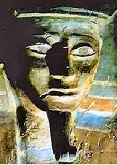
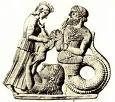
-1556 Seqenenre Tao dies, and his son (by Ahhotep I) Kamose (d. -1551) becomes king #9 (last) of the Egyptian 17th Dynasty, continuing his father's war on the pesky Hyksos. The Aegeides Dynasty in Athens is founded by half-man half-fish Cecrops I (d. -1506) (Gr. "face with a tail"), who becomes king #1 of Athens, replacing elections for hereditary succession (until -1068) - who wouldn't want it that way?


-1550 About this time the ancient city of Jericho is abandoned; according to the Bible (Joshua Ch. 6), the Battle of Jericho sees the Israelite army of Gen. Joshua blow down the walls with trumpets; it is excavated in 1868, 1907-9, 1930-6, 1952-8, 1997-2000, and 2009, revealing eyeliner and scarabs from Egypt - no evidence of any trumpets? About this time the Ebers Papyrus is created in Luxor, Thebes, Egypt, describing diagnosis and treatment of various medical ailments incl. depression and dementia, mentioning that the heart is the center of the blood supply and all bodily fluids, and listing 877 drug prescriptions; discovered in 1873-4 by German Egyptologist Georg Mortiz Ebers (1837-98).
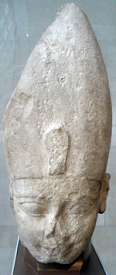
-1549 Kamose dies, and his co-regent brother (since -1546) Ahmose (Amosis) (Amasis) (Aahmes) (Amenes) ("Born of Yah") (Nebpehtyre) ("The lord of strength is Ra") (d. -1524) (brother of Kamose) expels the Hyksos from the Nile Delta, restores Theban rule over all of Egypt incl. Nubia and Canaan, and founds the fabulous Egyptian Eighteenth (18th) (Thutmosid) Dynasty (ends -1292), known for its imperialism and its superstar pharaohs incl. four named Thutmosis, female pharaoh Hatshepsut, and heretic pharaoh Akhenaten; end of the Second Intermediate Period (begun -1650), and beginning of the Egyptian New Kingdom (Egyptian Empire), which incl. the Egyptian 18th-20th Dynasties, seeing Egypt reach its peak of wealth and power; Amazing Ahmose I builds the last pyramid by native Egyptian rulers. Kassite ruler Agum becomes master of Babylonia, going on to extend its territory to the Zagros Mts. Shang Zhong Ding dies, and Shang Wai Ren (d. -1534) becomes Shang king #9 of China, dealing with a revolt by the Huai and Xian tribes.
-1547 Shamshi-Adad III dies, and his brother Ashur-Nirari I (d. -1522) becomes king of Ashur.
-1545 Agum II of Mari dies, and Burnaburiash I (d. -1500) becomes Kassite king of Babylon.
-1542 Birth of Jewish gen. Joshua (Jehoshua) (Yehoshua) (Hoshea) (d. -1432) (Heb. "Jehovah is salvation") in Egypt; son of Nun of the tribe of Ephraim.
-1534 Shang Wai Ren dies, and Shang He Tan Jia (d. -1525) becomes Shang king #10 of China, moving the capital from Xico to Xiang.
-1531 40-y.-o. Moses (b. -1571) flees to Midian after killing an Egyptian and burying him in the sand (Ex. 2:11-15; Acts 7:23-29), spending 40 years there, saving the seven daughters of Jethro at a well and marrying one of them, Zipporah, who bears him sons Gershom and Eliezer (Ex. 2:16-22; 18:2-4).
-1530 Peshgaldaramash dies, and Adarakalamma (d. -1502) becomes king of Sealand.
-1525 Telipinus the Priest, last king of the Old Hittite Kingdom seizes control and sacrifices some of the western districts and all of the territory E of the Taurus Mts. in favor of a more manageable kingdom. Shang He Tan Jia dies, and Shang Zu Yi (d. -1506) becomes Shang king #11 of China, moving the capital from Xiang to Geng to Xing.

-1524 Ahmose I dies after his two eldest sons Ahmose-ankh and Ahmose Sapair die, and his son (by Ahmose-Nefertari) Amenhotep (Amenophis) ("Amun is satisfied") I (Djeserkare) (d. -1503) becomes king #2 of the Egyptian 18th Dynasty, ruling 21 years.
-1522 Ashur-Nirari I dies, and his son Puzur-Ashur III (d. -1498) becomes king of Ashur; he signs a treaty with Burnaburiash I setting the border with Babylon at Samarra.
-1520 Alt. date of the birth of Moses (Eerdman's Dict. of the Bible).

-1506 Amenhotep I dies, and his military cmdr. (son of Amenhotep I and commoner Senseneb) Thutmose I (Thutmosis) (Thothmes) (Tuthmosis) ("Thoth-Born") (Akheperkare) (d. -1493) becomes king #3 of the 18th Egyptian Dynasty, going on to conquer Nubia past the Fourth Cataract, ending the autonomous Kingdom of Kush (Cush) (Nubia), located at the confluence of the Blue Nile, White Nile, and Atbara Rivers in modern-day Sudan; he becomes the first pharaoh (after Amenhotep I?) to build his tomb in the Valley of the Kings on the W bank of the Nile River opposite Thebes/Luxor; the practice continues for almost 500 years, ending with the Egyptian 20th Dynasty (-1077). Cecrops I dies, and autochthonous (born from the Earth) Cranaus (d. -1497) (born from the Earth) becomes king #2 of Athens. Shang Zu Yi dies, and Shang Zu Xing (d. -1490) becomes Shang king #12 of China.
-1502 Adarakalamma dies, and Ekurduanna (d. -1476) becomes king of Sealand.
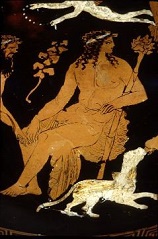

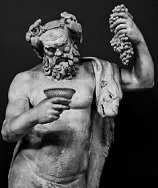
-1500 The Middle Bronze Period ends, and the Late Bronze Period begins (ends -1200); the domesticated horse begins to shrink the world. About this time the Achaeans begin to invade Greece in two waves, settling in the N Peloponnese; the Thracians later claim their original home in thickly-forested Pieria near Mt. Olympus, home of the cult of the Muses, which spreads S to Mt. Helicon in Boeotia, where they grow from three to nine in number, and are considered daughters of Zeus and Mnemosyne, goddess of memory. There is a major migration deep into Africa by farmers from the Middle East? The Medes are divided into six tribes, incl. the Magi, living in Media, lying between the Elburz and Zagros Mts. S of the Caspian Sea, and extending NW to the Araxes River and Lake Urmia. Burnaburiash I dies, and Kashtiliash III (d. -1470) becomes Kassite king of Babylon on the Euphrates River. Parattama becomes king #1 of the Hurrian-speaking Mitanni (Mittani) (Hanigalbat) Kingdom in SW Armenia and N Syria, run by a warrior nobility from India and Iran (ends -1300); they worship the Sun god Mithra. The Aramaic-speaking Semitic Arameans (Aramaeans) begin to migrate from the Arabian Peninsula to the N Fertile Crescent and Syria (ends -1200). About this time the town of Miletus is founded by Mycenaeans from Crete as a stronghold on the W coast of Asia Minor near the mouth of the Maeander River (until -1100), becoming the first of 10 Greek colonies on the Sea of Marmara or Black Sea, and the first city with a modern grid plan (by Hippodmos), which is copied by the Romans; the Temple of Didyma, devoted to Apollo the Didymaion (twin) is built, becoming the 2nd most famous oracle in the Hellenistic world after Delphi. In this cent. the Ahhiyawa (Achaean?) people raid W Asia Minor, according to Hittite records; later a force led by Attarissyas attacks Cyprus (Atreus, father of Agamemnon?). In this cent. the Minoan civilization suddenly begins to disappear. About this time the Greek wine god Dionysus begins to be worshiped by the Mycenean Greeks, later adopted by the Romans as Bacchus. About this time the Picts traditionally migrate from Brittany to Ireland, are refused permission to stay, but allowed to settle in NE Scotland on the condition that each Pictish king marry an Irish princess, since Pict society is matriarchal. About this time the Olmec ("rubber people") Culture begins (ends 200 C.E.) in the SW Gulf Coast of Mexico, centered in Tabasco and Veracruz, with highly developed agriculture, building mounds, temples, plazas, hieroglyphics and calendars, and a distinctive art with huge sculptured basalt heads, carved jade animal humans and jaguars; ceremonial bldgs. are built at La Venta in modern-day Tabasco, Mexico. Agriculture reaches SE North Am., spreading to the midwest. About this time Fiji is first settled by Polynesian seafarers, and Polynesian culture begins developing. About this time the Egyptian Book of the Dead (Book of Emerging Forth into the Light) goes onto the Memphis Times Bestseller List for those wanting to make it to the Field of Reeds (until -50). About this time the Mycenaeans change their burial style from shaft graves to circular rock-lined tholoi (beehive tombs) - nothing is too good for my muddah? In this cent. the Laws of Manu (Manu Smriti) are written in India by the Seventh Manu (ruler of the Earth for this age, which is the 7th Manvantara), institutionalizing the wonderful caste system; "Man is purer above the navel than below, hence the purest part is his mouth"; really written in the 2nd cent. B.C.E.? - a horse is a horse, of course, of course? The Polynesians migrate throughout the Pacific islands. Stonehenge is abandoned after 1500 years of use - no fun when not wearing skins? Cinnamon is exported from Kerala to the Middle East. Inventions: Bells are made in China. The earliest written record and surviving fragments of Tapestry. About this time the 22-letter (consonants only) Phoenician Alphabet begins to be developed, reaching its completed form around -1200, spawning the Aramaic and Greek alphabets (which introduces the first explicit symbols for vowel sounds); the Roman alphabet is developed from the Greek alphabet; the Brahmic alphabet is developed from the Aramaic alphabet? The Egyptians invent the Shadow Clock. The earliest known Glassware is made in Egypt. Indigenous iron technology arises in Dwarka and Kashmir in India. Hittites like to play a guitar-like musical instrument - the Hit-It? Nonfiction: About this time the Shun-Hai Ching (Sun-Hai (King) (Classic of Mountains and Seas) (Mountain-Sea Classic) is written by a group of Chinese scholar-explorers, becoming the oldest secular book on Earth; it describes fantastic creatures such as a 1-armed tusked ("spears of pearl") red giant as tall as three men, and a small grey pig with a white collar and teeth of pearls; did they visit America and see woolly mammoths and peccaries? About this time the Vedic Period begins in India (ends -500), with major portions of the 1,028 Veda Hymns (Vedas) (Sans. "veda" = knowledge) being composed, incl. the Rig Veda (Royal Knowledge), Sama Veda (Chant Knowledge), Yajur Veda (Sacrificial Ritual Knowledge), Atharva Veda (Knowledge of Incarnations); the Universe was allegedly evolved by self-existent Brahma (Sans. "worship") (Prajapati) the Creator (part of the Hindu Trimurti or Triad) from a cosmic egg; he originally had five heads, until Siva (Sans. "auspicious") the Destroyer, god of destruction and reproduction, the 3rd member of the Hindu Trinity destroys four of them, and he becomes red and rides on a swan with his consort Saraswati ("eloquence personified"), who becomes the goddess of writing and the arts; meanwhile the 2nd member Vishnu (Sans. "all-pervader") the Preserver stabilizes everything, going on to have several human incarnations, incl. Krishna (Kistna) - where are the sex manuals? There are Six Orthodox Schools of Hinduism. The four Vedas, incl. the Samhitas ("joined") (prayers), Brahmanas (legends), Aranyakas (ritual sacrifice), and Upanishads (abstract spiritual philosophy), which describe the ultimate reality of Brahman and the form of human salvation (moksha); the Trimurti (Great Trinity) ("three forms") consists of Brahma the Creator, Vishnu the Preserver, and Shiva (Maheswara) the Destroyer, who are three manifestations of the Supreme Being called Ishvara, Bhagavan, Parameshwara, or Deva/Devi; some claim he has five forms, Ganesha, Shiva, Shakti, Vishnu, and Surya; all living creatures have an atman or soul; Hinduism split into four sects incl. Shaivism, whose devotees worship Shiva and wander about with ashen faces performing self-purification rituals, Vaishnavaism, whose devotees worship Vishnu, Shaktism, whose devotees worship Shakti or Devi the Divine Mother and perform animal sacrifice, and Smartha (Smarta), who worship all five forms and hold the Smriti ("that which is remembered") as the most authoritative texts, recognizing Brahman as the highest principle in the Universe, pervading all existence. As far back as the 8th cent. B.C.E. the Later Upanishads ("sitting down near") began to be composed (ends -400?); traditionally, 108 of them exist, varying from 1-50 printed pages in length, forming the lit. foundation of Hinduism, incl. the Brahman (universal spirit), the Atman (individual self), and the divine syllable Aum, and how the non-dual Brahman-Atman is the all inclusive ground of the Universe while all reality in the Universe is but an illusion, we won't mention sacred cows.
-1498 Puzur-Ashur III dies, and his son Enlil-Nasir I (d. -1485) becomes king of Ashur.
-1497 Cranaus dies after fleeing to Lamptrae, and his son-in-law Amphictyon (d. -1487) becomes king #3 of Athens.
-1496 From this year thru 1861 C.E. (3,358 years) there are 3,130 years of war and only 227 years of peace (one in 13) :)

-1493 Thutmose I dies, and his non-eldest son (by minor wife Mutnofret) Thutmose (Thutmosis) (Tuthmosis) (Thotmes) ("Born of Thoth") II (d. -1479) becomes king #4 of the Egyptian 18th Dynasty; to secure his throne he marries his royal half-sister Hatshepsut, who wears the pants and is the real power behind the throne, claiming that daddy loved her best and wanted her to be his heir.
-1492 80-y.-o. Moses (b. -1571) has a religious experience with a thorn bush on Mount Horeb in the Sinai Peninsula (Ex. 3:1-15), and becomes the Messiah, Jehovah's official rep., performing the first human miracles (Ex. 4:1-9), going up against Pharaoh, with his brother Aaron (prophet to Pharaoh, Ex. 7.1) doing the talking and wielding his rod, and bringing on the Ten Plagues of Egypt to convince Pharaoh to let the Jews go (Ex. Chs. 7-12); Aaron goes to become the first high priest of the Israelites.




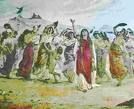
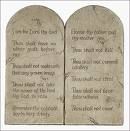
-1491 Traditional date of the First Passover, the Biblical Exodus, and the Red Sea Crossing Caper (Ex. Chs. 12-15), led by Moses; on Nisan 14 the first Passover is held (Ex. 12:1-13), then on Nisan 15 Israel departs from Egypt starting at Memphis, being joined by others from Goshen to the N, eventually growing to 2M-3M, and passing over the El Haj trade route to Succoth, reaching Etham N of the Red Sea; then, to solve some sibling rivalry between the top dogs (er, gods) of the two competing religions, the Jews are ordered by Jehovah to "turn back and encamp before Pihahiroth ("mouth of the gorges") between Migdol and the sea in view of Baal-zephon... by the sea" to the S (Heb. "Yam Suph" = "Red Sea" = Gulf of Aqaba?) (Nueba Beach at the end of Nueba Peninsula at the end of 2K-ft.-high Wadi Watir Canyon?) (Ex. 13:20-14:3), which causes Pharaoh and the Egyptians to think they are lost and harden their hearts and pursue them in 600+ chariots (Ex. 14:7); Jehovah then commands Moses to lift up his rod and stretch his hand out over the sea, parting the waters so the Hebrew nation can walk on the dry seabed (Ex. 14:16); after Jehovah makes the wheels of their chariots come off to slow them down (Ex. 14:25), Moses stretches out his hand over the sea again, causing it to close on the Egyptians and kill them all (Ex. 14:26-28); "But the children of Israel walked upon dry land in the midst of the sea; the waters were a wall unto them on their right hand and on their left. Thus the Lord saved Israel that day out of the hand of the Egyptians, and Israel saw the Egyptians dead upon the sea shore" (Ex. 14:29-30); joyful Moses and the men celebrate by singing the hit Hebrew song "The Horse and Its Rider Hath He Thrown in the Sea" (Ex. 15:1), while Aaron's sister Miriam leads the women with tambourines (Ex. 15:20-21); after providing them with food, quail, and manna and instituting a Sabbath Law (Ex. Chs. 15-16), they finally make it to the Sinai wilderness in the 3rd month after the Exodus (Ex. 19:1-2); Moses goes to the top of Mt. Sinai (Horeb) in Midian for 40 days, and returns with two stone (blue sapphire?) tablets "written on by God's finger" containing the Ten Commandments (Words) (Decalogue) (Ex. 31:18, Deut. 4:13), but breaks them after seeing a group of backsliders singing in front of a golden calf made by his brother Aaron from gold jewelry donated by the backsliders, and he and the tribe of Levi kill all 3K of them (sparing Aaron), asking Jehovah to give the Jews another chance and let Moses make his own copy of the Ten Commandments, which he permits after passing by Moses but only allowing him to see his "back (parts) (side)" (Ex. 33:18-23, 34:1-6; Acts 7:38), causing Moses' face to emit rays so intense that the Jews can't bear to look at him (Ex. 34:29-35; 2 Cor. 3:7-13) (ass-kissing and brown-nosing jokes here?); meanwhile Moses begins compiling the five books of the Torah (Hebrew Bible) (Pentateuch), incl. Genesis (Bereshit) ("In the beginning"), containing the immortal soundbyte: "Let there be light" (Lat. "fiat lux") (Gr. "genetheto phos") (Gen. 1:3), Exodus (Shemot) ("The names"), Leviticus (Vayikra) ("And He called"), and Deuteronomy (Devarim) ("Words/things"), containing the immortal soundbyte (Shema) (Deut. 6:4): "Here, O Israel, the Lord our God, the Lord is One", to which the people reply: "All that Jehovah has spoken we are willing to do and be obedient" (Ex. 24:3-7, Heb. 9:19), and sprinkles the Book of the Covenant with blood and reads it to the people on the plains of Moab, founding the Jewish Religion (Judaism), with Moses' Ten Commandments giving Jews a way to beat the curse of Adam and gain eternal life if one never disobeys them, which it turns out all do, esp. when all 613 Commandments (Mitzvot) are taken into consideration, making it necessary for them to be perfected by Christianity - from now on, people can't break God's law, only break themselves on it? The Red Sea Crossing happened no later than -1400 because the Egyptian Eighteenth Dynasty is the only one that used both 4-spoke and 6-spoke chariot wheels, corresponding to coral formations on the floor of the Gulf of Aqaba at both ends of an undersea ridge that makes the gulf passable by foot if the water were removed?; computer simulations by Nat. Center for Atmospheric Research in Boulder, Colo. in 2010 show how a land bridge could be created by a strong E wind at the junction of an ancient river and a submerged coastal lagoon along the Mediterranean Sea.
-1490 Shang Zu Xing dies, and Shang Wo Jia (d. -1465) becomes Shang king #13 of China. The Jewish Tabernacle (the first DOS Box in Windows?) is built, and the Aaronic priesthood is consecrated (Ex. 40:7, Lev. Ch. 8); Moses sends out an advance party of 12 spies for a 40-day preview of the borders of the Promised Land; upon returning, only 40-y.-o. Caleb (b. -1530) (Heb. "dog") and Joshua (Jehoshua) (b. -1542) (Heb. "Jehovah is salvation") (son of Nun) recommend settling there, the others freaking at the walled cities and scary people and cautioning against it (Num. chs. 13-14), causing the spooked Israelites to balk at proceeding there immediately, pissing-off Jehovah, who kills the 10 bad spies and ordains that none of the Israelites over age 20 (except the Levites, who do no military duty) will live to enter it except Caleb and Joshua. Joshua allegedly stole, er, conquered the 18th cent. B.C.E. city of Hebron, after which seven years later the city of Zoan in the E Nile Delta was founded (Num. 13:23).
-1487 Amphictyon dies, and Erichthonius (Erichtonios) (d. -1437) (Gr. "Earth-born") (don't ask how he was born?) becomes king #4 of Athens.


-1486 The Great Ten-Tailed Comet is observed by the Chinese; it lights up half the sky, and is visible throughout the Northern Hemisphere; portrayed in the Lao-Tien-Yeh Glyph.
-1485 Enlil-Nasir I dies, and his son Nur-Ili (d. -1473) becomes king of Ashur.

-1483 Thutmosis (Thothmes) III (Menkheper Ra) (d. -1450) fulfills his macho destiny and becomes pharaoh after revolting against his father's sister-wife Queen Hatshepsut, killing her and her daughter Nefrure, then obliterating her name from inscriptions; her mummy is finally identified in June, 2007, kept in a servant's tomb, showing that she was heavy set and suffered from bone cancer (really dies in -1468?); the cancer was caused by a creosote ointment she used for eczema?
-1480 An Egyptian fresco of a handloom is discovered in 1953.




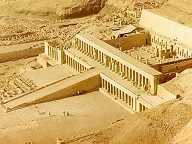
-1479 After her 2-y.-o. stepson Thutmose III ascended the throne last year, Thutmose II's chief wife (daughter of Thutmose I and Ahmes) Hatshepsut (Hatchepsut) ("Foremost of noble ladies") (d. -1458) (Hot Sheep Shit?) becomes king #5 of the Egyptian 18th Dynasty, becoming Egypt's first female pharaoh, ruling 21 years 9 mo. while bowing to male supremacists by wearing a man's pants and beard, while trying to get her daughter (only child) Nefrure knocked, er, set up as her heir; in year 9 of her reign she goes on an Expedition to Punt in five 70-ft.-long ships, each carrying 180 sailors and 30 rowers, buying frankincense and myrrh, returning with 31 live myrrh trees, which she transplants; she goes on to commission hundreds of building projects under chief architect Ineni (Anena) (previously used by Amenhotep I, Thutmose I, and Thutmose II), restoring the Temple of Mut in Luxor on the E bank of the Nile River, which had been destroyed by the Hyksos illegal immigrants; her other chief architect Senenmut ("mother's brother") designs her mortuary temple complex at Deir el-Bahri on the W bank of the Nile River near the entrance to the Valley of the Kings, incl. the Djeser-Djeseru ("sublime of the sublimes") Mortuary Temple (holy of holies) next to the mortuary temple of Amentuhotep II, dedicated to the sun god Amun; Senenmut's tomb in Thebes contains an astronomical ceiling containing the earliest known star map in Egypt.
-1476 Ekurduanna dies, and Melamkurkurra (d. -1469) becomes king of Sealand.

-1475 Thutmose III, the Napoleon of Egypt begins building the obelisk called Cleopatra's Needle (finished -1460).
-1473 Nur-Illi dies, and his son Ashur-Saduni becomes king of Ashur; he reigns 1 mo. and is overthrown by Ashur-Rabi I (d. -1450), son of Enlil-Nasir I.
-1470 Kashtiliash III dies, and Ulamburiash (d. -1465) becomes Kassite king of Babylon.
-1469 Melamkurkurra dies, and Ea-Gamil (d. -1460) becomes king of Sealand.
-1467 Gen. Joshua leads the confederation of Hebrew tribes known as the Israelites to decisively conquer the Canaanites ("Canaan" = land of purple) as described in the Book of Joshua (Jehoshua); the Promised Land is divided among the 12 tribes of Israel, with the 13th tribe of Levites getting no land, but in return getting to eat the food used in sacrifices? (Joshua 1-14); the Biblical Age of Jewish Judges begins; it really happened really much later (1126 B.C.E.?); too bad, the Jews fail to completely wipe out the Canaanites' idol worship from the Promised Land like Jehovah commanded, pissing him off and causing him to utter the soundbyte: "I led you up from Egypt and brought you to the land of which I swore to your fathers; and I said, 'I will never break My covenant with you. And you shall make no covenant with the inhabitants of this land; you shall tear down their altars.' But you have not obeyed My voice. Why have you done this? Therefore I also said, 'I will not drive them out before you; but they shall be thorns in your side, and their gods shall be a snare to you'" (Judges 2:1-3); it really never happened, and was made-up 600 years later for purposes of nat. propaganda as a coverup of the truth that the Jews never lived in Egypt and started out in Canaan themselves?
-1465 Shang Wo Jia dies, and Shang Zu Ding (d. -1433) becomes Shang king #14 of China. Ulamburiash dies, and Agum III (d. -1445) becomes king of Babylon.
-1460 Sealand is overthrown by Agum III of Babylon, and Ea-Gamil is killed; Babylon absorbs Sealand.

-1458 Hatshepsut dies, and Thutmose II's son (by minor wife Iset) Thutmose (Thutmosis) (Thutmoses) (Tuthmosis) (Thutmes) ("Thoth-born") III (d. -1425) (co-regent with his stepmother-aunt Hatshepsut since 1479) AKA the Napoleon of Egypt becomes king #6 of the Egyptian 18th Dynasty, expanding Egypt to its greatest size in 17 campaigns, conquering from Niya in N Syria to the Fourth Cataract of the Nile River in Nubia, and ruling almost 54 years; he builds the city of Napata on the W bank of the Nile River past the Fourth Cataract near modern-day Karima, Sudan (250 mi. N of Khartoum), becoming the seat of the "King's Son of Kush" (Egyptian viceroy), with a pop. of 100K; he erects many obelisks all over Egypt; too bad, he and his successor try to obliterate Hatshepsut's name from statues and monuments.
User;-1457 On Apr. 16 Thutmoses III (the Napoleon of Egypt, who never loses a battle) defeats the rebellious Caananites, led by the king of Kadesh at the Battle of Megiddo, the crossroads of the Middle East.

-1453 Egypt finishes conquering the Canaanite city-states of the Levant, establishing the Kinakhna Province.
-1452 Moses' elder brother and Jewish high priest Aaron (b. -1575) dies at age 123; Moses still has full vigor and alertness (Deut. 34:7).
-1451 Moses (b. -1571) dies on Mt. Nebo in Moab at age 120 after writing the books of Books of Moses incl. the Book of Genesis (Gr. "origin"), Book of Exodus, Book of Leviticus (Gr. "relating to the Levites"), Book of Numbers, Book of Deuteronomy, and Book of Job (Deut. 34: 5,7); Israel (Isis + Ra + El?) enters the Promised Land of Canaan under new leader Joshua (Jehoshua) (Hoshea) (b. -1542), son of Nun of the tribe of Ephraim (Ex. 17:19, Josh. 4:19), and conquers it in six years after making a wilderness census (Gen. ch. 46) and sending two spies from Shittim, who stay at the house of Rahab the City Wall Ho, who flip-flops to their side and hides them from the king of Jericho on her roof, letting them down by a rope through a window (Joshua ch. 2); Balaam ("he who swallows") of Pethor, son of Beor turns traitor and informs King Balak how to get the Israelites to curse themselves by enticing them with hos and unclean food sacrified to idols, and makes a prophecy about ships from Kittim (Cyprus? Italy? Macedonia?) afflicting Assyria, but eventually perishing (Num. 24:24).

-1450 The Egyptian empire reaches its maximum extent. Incursions of the warlike Kaska of the N Pontic coast threaten the Hittite kingdom. Ashur-Rabi I dies, and Ashur-Nadin-Ahhe I (d. -1450) becomes king of Ashur in Assyria on the Tigris River, which becomes a vassal of Mitanni. The early Upanishads begin to be composed? Inventions: About this time the Mycenaeans develop Linear B writing, an early form of Greek writing. Clay tablets with the 32 cuneiform letters of the extinct Semitic Ugaritic alphabet are found at Ugarit (Ras Shamra), Syria in 1929 C.E. Thutmose III dies.
-1445 Agum III dies, and Kadashman-Harbe I (d. -1440) becomes king of Babylon.
-1440 Kadashman-Harbe I dies, and Karaindash (d. -1430) becomes king of Babylon.
-1440 A confederation of Hebrew tribes known as the Israelites decisively conquer the Canaanites ("Canaan" = land of purple) as described in the Book of Joshua (Jehoshua), initiating the Biblical Age of Jewish Judges; really much later (-1126?); it really never happened, and was made-up 600 years later for purposes of nat. propaganda as a coverup of the truth that the Jews never lived in Egypt and started out in Canaan themselves?
-1437 Erichtonius dies, and his son Pandion I (d. -1397) becomes king of Athens.
-1433 Shang Zu Ding dies, and Shang Nan Geng (d. -1408) becomes Shang king #15 of China.
-1432 Death of Joshua (b. -1542) at age 110 (Josh. 24:29); the Israelites settle down for the next three cents. undisturbed.
-1430 Ashur-Nadin-Ahhe I is overthrown by his brother Enlil-Nasir II (d. -1424), who becomes king of Ashur and a vassal of Mitanni. Karaindash dies, and Kurigalzu I (d. -1380) becomes Kassite king of Babylon.

-1425 Thutmose III dies, and his son Amenhotep (Amenophis) ("Amun is Satisfied") II (Akheperure) (d. -1397) becomes king #7 of the Egyptian 18th Dynasty, ending hostilities with the Mitanni in Syria; the real Exodus Pharaoh?
-1424 Enlil-Nasir II dies, and his son Ashur-Nirari II (d. -1418) becomes king of Ashur and a vassal of Mitanni.
-1420 The domain of Mitanni king Saustatar (Saushatar) stretches from the Mediterranean to the N Zagros mountains in W Iran; the 5K Tablets of Nuzi (a province of Mitanni 10 mi. SW of modern Kirkuk, Iraq) are written by Hurrian scribes in Akkadian. The up-and-coming Iron Age Mycenaeans conquer the Bronze Age Minoans in Crete, ending the Second Palace Period (begun -1700), and taking over the Minoan trade routes, expanding by sea to the Cyclades, Rhodes, Sicily, and Italy, establishing trade with Egypt, Assyria, Babylonia, and the Hittites; they like to live in small city-kingdoms.
-1418 Ashur-Nirari II dies, and his son Ashur-Bel-Nisheshu (d. -1409) becomes king of Ashur and a vassal of Mitanni.
-1410 After the Israelites slip back into pagan worship, Jehovah sends the Syrians under Cushan-Rishathaim (Chousarsathaim) ("man of the twofold crime from Cush") to oppress Israel for eight years, until he sends Caleb's younger brother Othniel (d. -1362) (Heb. "Lion of God") to save them, becoming the first Jewish judge (Judges 3:8-10), keeping the peace for 40 years; the Age of the Biblical Patriarchs ends, and the Biblical Age of Jewish Judges begins - no Judge Judy?
-1409 Ashur-Bel-Nishesu dies, and his son Ashur-Rem-Nisheshu (d. -1401) becomes king of Ashur and a vassal of Mitanni.
-1408 Shang Nan Geng dies, and Shang Yang Jia (d. -1401) becomes Shang king #16 of China.
-1402 Judge Othniel of Israel is victorious over Syria; the land "had no disturbance" for the next 40 years.
-1401 Shang Yang Jia dies, and Shang Pan Kang (d. -1372) becomes Shang king #17 of China, moving the capital from Yan to Beimeng. Ashur-Rem-Nisheshu dies, and his son Ashur-Nadin-Ahhe II (d. -1392) becomes king of Ashur and a vassal of Mitanni.



-1400 In this cent. Jerusalem (pop. 1500) is first mentioned as a city-state of Canaan, lesser in importance to Hazor and Megiddo, with territory stretching from Shechem to Gezer, ruled in the mid-1330s by Abdi Hepa (Abdi-Kheba) (Abdi-Hepat) (Abdi-Hebat) (Hurrian "servant of Hebat"), who claims to be put in charge by the Egyptian pharaoh, according to the 382 Akkadian cuneiform Amarna Letters (tablets) from Canaanite princes to Egyptian pharaohs Amenhotep III (-1386 to -1349) and his son Akhenaten (-1350 to -334), discovered in 1887 C.E. Kassite king Kurigalzu I of Babylonia conquers Elam, ending the Dynasty of Eparti (begun -1925). King Nestor of Pylos conquers Iklaina in SW Greece, eventually bringing 16 states under his rule, incl. Nichoria. About this time King Tudhaliya (Tudhaliyas) II revives or founds the Middle Hittite Kingdom (ends -1175), bringing the iron and chariot masters to their zenith while sharing the spotlight with Egypt, Assyria, and Babylon; the culture moves away from its Hattic roots and goes Hurrian, which is okay as long as they speak Hittite and stay PC? The Old Elamite Kingdom (begun -2230) ends. The Neolithic period in S India ends, and a transition to Megalithic begins. A mysterious kingdom is founded (until -600), which goes on to defeat King Midas's kingdom of Phrygia in battle. The Mittani city of Zakhiku on the Tigris River flourishes until an earthquake destroys it about -1350; discovered after the waters of the Mosul reservoir recede. In this cent. the Oracle of Delphi, dedicated to Apollo is founded on the S slope of Mt. Parnassus in the Phocis district of Greece at the alleged navel of the Earth, becoming their oldest and most influential religious sanctuary; the chief priestess is called Pythia, priestess of the serpent (draco) Python, who was slain by the god Apollo. After the Hittite raids against Egypt give the Phoenician city-states the chance to revolt, the Phoenician city of Tyre becomes a flourishing center of maritime trade; Phoenician traders reach as far W as West Africa and Britain? In this cent. Calah (modern-day Nimrud) replaces Assur (Ashur) as the capital city of Assyria. A drug trade in opium, hashish and other drugs flourishes in the Middle East; ships with hulls made with joined planks sail the Mediterranean. The Moabite culture E of the Dead Sea in modern-day W Jordan begins. The Nordic Germanics of the Baltic Sea region begin expanding into S Europe. Karakul sheep begin to be raised in C Asia. The Canaanite city of Tel Gezer on the Via Maris between Egypt, Syria, Anatolia, and Mesopotamia is founded. Inventions: The earliest known examples of Chinese writing are oracle bones used to predict the future. Hieroglyphic name-rings contain the earliest known reference to Israel? Music: The earliest known song is written in Syria, and deciphered at the U. of Calif. and played in 1974 C.E. by Richard L. Crocker on a reconstructed musical instrument. Art: Anon., Fowling in the Egyptian Marshes (fresco) (Tomb of Nebamun).
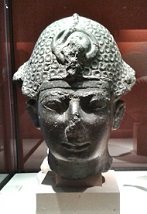
-1397 Amenhotep II dies, and his son (by Tiaa) Thutmose (Thutmosis) (Thutmosis) IV Menkheperure ("Established in forms is Ra") (d. -1388) usurps his older brother to become king #8 of the Egyptian 18th Dynasty, going on to restore the Sphinx in Giza and commission the Dream (Sphinx) Stele, describing how he had a dream that if he restored it he would become pharaoh, bolstering his legitimacy claims. Pandion I dies, and his son Erechtheus (d. -1347) becomes king #6 of Athens.
-1392 Ashur-Nadin-Ahhe II dies, and Eriba-Adad I (d. -1363), son of Ashur-Bel-Nisheshu becomes king of Assyria, gaining independence from Mitanni.
-1391 Possible date for the birth of Moses (d. -1271).
-1390 Shuttarna dies, and Tushratta (d. -1360) becomes king of the Mitanni.
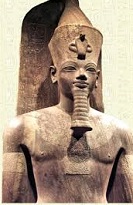

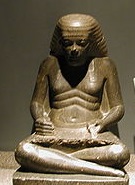
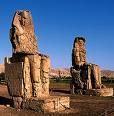
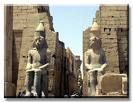

-1388 Thutmose IV dies after having a vision from the god Horus to clear the sand covering the Sphinx, and in June his son (by queen Mutemwiya) Amenhotep III (Amana-Hatpa) ("Amun is Satisfied") (the Magnificent) (Nebmaatre) (d. -1351) becomes king #9 of the Egyptian 18th Dynasty; in his 2nd year of rule he marries his wife (identified as the Elder Lady in the tomb of Amenhotep II in 2010) Queen Tiy (Tiye) (Tiyhi) (Ty) (Taia), who rules as virtually his equal (not that the high priest of Amon-Ra doesn't hold the supreme power now?); a statue of the goddess Ishtar is sent to him by the city of Nineveh by orders of the king of Mitanni; after hiring architect Amenhotep, son of Hapu, he builds the Colossi of Memnon and the Temple of Luxor; the Tomb of Nebamun in Thebes, discovered in 1820 features the Two Nude Girls of Thebes.
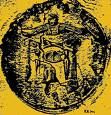
-1380 Suppiluliuma(s) I (d. -1340) (-1390 to -1354?) becomes king of the Hittites. Kurigalzu I dies, and Kadashman-Enlil I (d. -1359) becomes king of Babylon, writing a Letter to Amenhotep III.
-1378 Tutankhaten is born to Amenhotep III and Tiy?
-1375 On May 3 there is a total solar eclipse. Amenhotep III dies? Egyptian courtier couple Yuya and Tjuiu, parents of Queen Tiy and great-grandparents of Tutankhamun die; their tomb is discovered in 2013, and is found complete with mummified rib meat.
-1374 Queen Tiy visits Amarna, where a pageant of foreign tribute is held?
-1372 Shang Pan Kang dies, and Shang Xiao Xing (d. -1352) becomes Shang king #18 of China.
-1368 The Hittites raid Arzawa (around Ephesus).
-1363 Eriba-Adad I dies, and his son Ashur-Uballit I (d. -1328) becomes king of Assyria; he revolts against the Mitanni under Shuttarna II, conquers them, reclaims Nineveh, and founds the Assyrian Empire, styling himself "king of the Universe", and writing the Amarna Letters to the king of Egypt - make me a shedu?
-1362 After Israeli judge #1 Othniel (heb. "Lion of God") dies, the Israelites fall back into idolatry, and king Eglon of Moab, along with the Ammonites and Amalekites capture Jericho for 18 years.
-1360 Mitanni king Tushratta is assassinated; king Suppilulima I of the Hittites conquers the Mitanni. Tutankhamen dies and is buried at Thebes, and elder Lord Ay becomes pharaoh?
-1359 Kadashman-Enlil I dies, and Burnaburiash II (d. -1333) becomes king of Babylon; he calls himself "brother of the pharaoh", and is friends with Akhenaten.
-1356 An outbreak of hatred against Atenism causes Horemheb to wipe the religion out of Egypt?
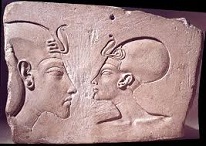

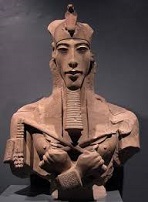

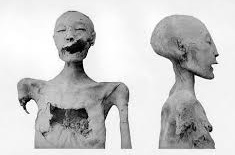

Amenhotep III dies (from complications caused by abscesses in his teeth?), and his son (co-regent since -1353) Amenhotep (Amenophis) ("Amun is satisfied") IV (-1384 to -1334) (later Akhenaten) becomes king #10 of the 18th Egyptian Dynasty at Thebes; his sister-wife is luscious eye liner-wearing ruby-red-lipped "Lady of the Two Lands" Nefertiti (Ankhkheperure Neferneferuaten) (-1370 to -1330) ("Nefer" = beautiful, "Titi" = er, arrived), daughter of the equally luscious Queen Tiy; they have six daughters, incl. the three "senior princesses" Meritaten (Merytaten) (Meryetaten) (-1350 to ?) ("beloved of Aten"), who marries her brother Smenkhkare, Meketaten (-1349 to ?) ("protected by Aten"), and Ankhesenpaaten (Ankhesenamen) (-1348 to -1323), who marries King Tutankhamun, and whose statue is discovered in the 1930s by English archeologist Mary Chubb (1903-2003); Akhenaten, Nefertiti, and Tut have elongated skulls, spawning theories that they are part alien; in 1955 Irish archeologist Sean P. O'Riordan (1905-57) of Trinity College, Dublin discovers a necklace of Egyptian-style fired faience beads in the Mount of Hostages in Tara, Ireland, along with a golden collar similar to Tutankhamun's, proving intercourse with the Celts? Igi-Halki wins Elam's independence from Babylonia, founding the Middle Elamite Kingdom (ends -1110). A clay tablet bearing the earliest known example of writing in Europe is made in Iklaina in SW Greece; it is in Linear B.
-1349 Shang Ziao Sing dies, and Shang Xiao Yi (d. -1324) becomes Shang king #19 of China.
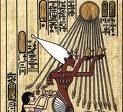


-1347 Hippo-hipped, sagging-paunched, tiny-chested, pencil-necked (first to have realistic statues of himself made without fake handsome face, broad shoulders, narrow hips and long legs?) Amenhotep IV decides to hold a Sed festival in his 3rd reignal year (instead of the usual 30th reignal year as is customary), and next year dumps Amen (Amon) for the Sun disk Aten (Aton) (pissing-off the rich priests of Amon, who have generations of tribute in their treasury?), changes his name to Akhenaten (Akhenaton) (Akhnaten) (Ikhnaton) (Khuenaten) ("effective/beneficial for Aten") (-1384 to -1334) (-1362 to -1336?) ("it is well with Aten", "servant of Aten") (Beautiful Child of the Sun), becoming the first monotheist in history, establishing the monotheistic Sun-disk Religion of Aten in Egypt (worshiping the power behind the Sun, not the physical Sun?), and ordering the building of a new city 200 mi. N of Thebes at Aketaten ("horizon of Aten"), now known as El-Amarna (Amarna) (on the E bank of the Nile halfway between Cairo and Luxor) (pop. 20K), which is hastily built in two years with shoddy materials and untrained workers using limestone blocks, complete with a new temple that breaks the old habit of worshipping in dark sanctuaries, with plenty of sunlight streaming in, which the pop. never gets used to; meanwhile maybe-it's-Maybelline royal sculptor Thutmose (Thutmosis) (Dhutmose) at Amarna takes plaster casts from living faces, incl. Akhenaten, and breaks the old taboo by showing his real figure, complete with fat hips and effeminite chest, playing with children; Akhenaten becomes the first pharaoh to make his servants bow and scrape, building resentment which comes back at him in only 16 years; the title "pharaoh" (great house) is first used in an address to Akhenaten by a foreign ruler; was Aten really the 10-tailed Great Comet of 1486 B.C.E.? Erechtheus dies, and his son Cecrops II (d. -1307) becomes king #7 of Athens. King Tut receives the desperate Amarna Letters from Canaan, begging for assistance against the pesky Apiru (Hapiru) (Habiru) ("stateless", "dusty, dirty") Asiatics threatening to take over the land; the origin of the word "Hebrew"?
-1345 On Jan. 2 in the 5th year of his reign, Amenhotep IV officially changes his name to Akhenaten.
-1344 Israeli judge #2 Ehud ben-Gera (son of Gera, of the tribe of Benjamin) is victorious over king Eglon, killing with a 2-edged cubit-long dagger, then killing 10K Moabites, after which Benjamin enjoys rest for 80 years (Judges ch. 3); meanwhile the Philistines oppress SW Israel (Judges 5:6).

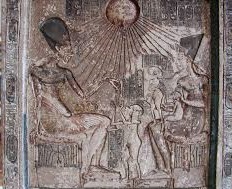

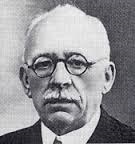

-1343 Akhenaten officially moves the Egyptian capital from Thebes to Amarna, although the new city isn't finished for two more years, during which time the famous polychrome painted limestone (or limestone core covered with thin plaster) Bust of Queen Nefertiti is sculpted by Thutmose, and discovered in his workshop in Tell el-Amarna by German archeologists led by Ludwig Borchardt (1863-1938) in 1912, along with a Stela of Akhenaten and His Family; too bad, on Jan. 20, 2013 French Egyptologist Gustave Lefebvre (1879-1957) chooses the stela to go to the Egyptian govt., allowing the bust to go back to Germany, ending up in the Egyptian Museum in Berlin, after which the stela is suspected of being a fake.

-1340 King Suppilulima I of the Hittites dies, and is succeeded by Mursilis II (d. -1295), who goes on to conquer the Arzawa Kingdom.
-1339 Alt. date for end of the reign of King Tut (begun -1347).
-1338 On Nov. 21 Meketaten, daughter of Nefertiti is mentioned for the last time; meanwhile Nefertiti is elevated to co-regent?

-1335 Nefertiti and four of her six daughters mysteriously disappear, and Akhenaten's brother Smenkhare becomes co-regent of Egypt with Akhenaten, with his wife (half-sister?) (half-niece?) Meritaten (Merytaten) (Meryetaten) ("Beloved of Aten") (-1350 to ?) as "great royal wife"; is Smenkhare really Nefertiti in disguise, and Meritaten's title mean that she is another wife of Akhenaten, or merely assumed her mother's ceremonial duties?
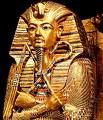
-1334 The first known plague hits Egypt; Akhenaten (b. -1384) dies, leaving the most statues of himself to survive to modern times (250), even though his likeness is erased from many monuments by his hate-filled people; his sickly 20-y.-o. brother Smenkhkare (Smenkare) (Smenkhkara) ("Living are the forms of Ra") (Ankhkheperure Smenkhare Djeser Kheperu) (-1353 to -1334) becomes king #11 of the 18th Egyptian Dynasty at Amarna, but dies in Thebes within a year (of plague?). Burnaburiash II dies, and his son Karahardash becomes king of Babylon, but he is assassinated because of his Assyrian ancestry (grandson of Ashur-Uballit I), and is succeeded by Nazibugash (Suzigash).

-1333 8-y.-o. Tutankhaten ("living image of Aten") (Nebkheprure) (King Tut) (-1341 to -1323) (son of Amenhotep III and Tiy), who married his niece Ankhesenpaaten (daughter of Nefertiti and Akhenaten) to gain the succession becomes king #12 of the 18th Egyptian Dynasty at Amarna, staying with the religion of Atenism until Nefertiti dies (but obviously wanting to dump it since the plague sends him a divine message that Aten sucks?); being the son of a brother-sister, he suffers from Kohler's Disease, which gives him feminine hips, pronounced overbite, and a progressive loss of bones in his foot, causing lifetime excruciating pain; he comes to power only after two of his sisters jointly hold the throne?
-1332 Naziburgash is overthrown by Ashur-Ubbalit I of Assyria, and replaced by Kurigalzu II (d. -1308), son of Burnaburiash II; he turns on Assyria and attacks.
-1330 Nefertiti (b. -1370) dies, and Tutankhaten renounces red hot Aten, dropping him like a hot potato and changing changing his name to Tutankhamen ("Living image of Amun"), and his wife's to Ankhesenamen, then returning to good ole Thebes.
-1328 Ashur-Uballit I dies, and his son Enlil-Nirari (d. -1318) becomes king of Assyria, sponsoring the Chronicle of Enlil-Nirari.
-1324 Shang Xiao Yi dies, and Shang Wu Ding (d. -1265) becomes Shang king #20 of China. Canaanite king Jabin of Hazor begins oppressing Israel for the next 20 years (Judges 5:6-11).

-1323 King Tut (b. -1341) dies at age 19 of a leg fracture and malaria, and is buried in the Valley of the Kings in Thebes; his tomb is found in 1922 C.E. by Howard Carter (1874-1239) of England; in 2005 Maria Rosa Guasch-Jane et al. of the U. of Barcelona find that he drinks red wine from traces found in his tomb; in 2013 it is discovered that after burial his mummified body spontaneously combusted; in 2010 DNA tests indicate that Tut is of W European (as in Celtic?) origin; 70-y.-o. Lord Ay (Kheperkheperure) ("Everlasting are the manifestations of Ra") (d. -1319) (former servant of Akhenaten and Nefertiti) becomes king #13 of the 18th Egyptian Dynasty at Thebes.
-1320 Miletus in W Asia Minor supports an anti-Hittite rebellion of King Uhha-Ziti of nearby Arzawa, with Mursili ordering his gens. Mala-Ziti and Gulla to raid Millawanda, burning parts of it.

-1319 King Ay dies, and despite having named his son Nakhtmin as his successor, army CIC Gen. Horemheb (Horemhab) (Haremhab) ("Horus is in jubilation") (Djeserkheperure) (d. -1292) becomes king #14 (last) of the 18th Egyptian Dynasty at Thebes; four years after Tutankhamen dies, an outbreak of hatred against Atenism in Egypt causes Horemheb to order all traces of Atenism wiped out, Amarna destroyed, the great temple pulled down and covered with cement, the name and likeness of Akhenaten removed from all monuments, and Akhenaten's mummified body burned.
-1318 Enlil-Nirari dies, and his son Arik-Den-Ili (d. -1308) becomes king of Assyria, sponsoring the Chronicle of Arik-den-Ili.
A 15m-long ship loaded with misc. treasures from Cyprus, Palestine, or Syria is wrecked at Uluburun off the SW coast of Turkey; after being found by a sponge diver in 1982, it is excavated by Am. underwater archeologist George Bass (1932-) et al.

-1308 Kurigalzu II dies, and Nazimaruttash (d. -1282) becomes king of Babylon, going on to war with Assyria, and later erecting the Nazimaruttash Kudurru Stone, depicting Kudurru, goddess of Medicine. Arik-Dan-Ili dies, and his brother Adad-Nirari I (d. -1275) becomes king of Assyria (-1295 to -1263?).
-1307 Cecrops II dies, and his nephew (son of Erechtheus) Pandion II (d. -1282) becomes king #7 of Athens.-1304 Judge #3 Shamgar saves Israel from the Philistines, and judge #4 Deborah (Heb. "bee") (only female judge) and judge #5 Gen. Barak of Israel are victorious over the Canaanite armies of Sisera; Israel has no further disturbances for 40 years (Judges chs. 4-5).

-1300 The Urartians (Khaldians) (related to the Hurrians) move into the Lake Van plateau of Armenia ("ar" + "meni" = men of the mountains) about this time, founding Urartu (Heb. "Ararat"), located between Lake Van (SW), Lake Urmia (SE), Lake Sevan (NE) and Lake Cildir (NW), with Mt. Massis (Ararat) in the center, going on to become known for metalworking and adopting the Assyrian cuneiform script. In this cent. the kingdom of Mira flourishes, with capital at Abasa (Ephesus); it is conquered by the Hittites by the beginning of the next cent., the remnants becoming the kingdom of Lydia? In this cent. the Midianites set up shop in the Sinai Peninsula and E of the Dead Sea. The Bronze Age city of Bamboula near modern-day Episkopi and Limassol near the Troodos Mts. in SW Cyprus flourishes (until -1000). In this cent. the Celts of Britain have contact with Egypt. Towards the end of this cent. climate change contributes to the collapse of E Mediterranean civilizations in Greece, Syria et al.? In this cent. the town of Doliche (modern-day Gaziantep), in S Asia Minor 30 mi. N of the Syria-Lebanon border in the Sajur River Valley (tributary of the Euphrates River) (3.5K ft. alt.) is founded by the Hittites, later becoming a center of Baal (Zeus Colichenus) worship; not to be confused with the town of Doliche located at the foot of Mount Olympus. In this cent. the city-kingdom of Citium (Kition) on the S coast of Cyprus is founded. About this time Troy VI is destroyed by an earthquake, and replaced by Troy VIIa, the city of the Trojan War. About this time the Treasury of Minyas at Orchomenos is built, actually a large beehive tomb; meanwhile Mycenaean trade with Egypt and Syria begins a decline. About this time the volcanic island of Zebirget (Zagbargad) (Topazios) in the Red Sea 45 mi. from Aswan starts to be mined for peridot (topaz); the ancient mines are rediscovered in 1900 C.E., mined out. Dingoes arrive in Australia about this time? The first mention of alfalfa (Arab. "al fac facah" = father of all foods) in Turkish writings. The first depiction of the Huachuma cactus, which becomes one of the four sacred plants of Peru; later named after St. Peter because he allegedly used the cactus' powers to uncover the secret hiding place of the keys. Divers in the Persian Gulf use goggles made of polished clear tortoise shell. In this cent. musical notation is invented in Ugarit, Syria.


-1292 King Horemheb dies leaving no heir, and the aged high priest of Amon, Rameses (Ramses) (Ramesses) I (Menpehtyre) (-1280 to -1290), born a commoner from a military family (son of military cmdr. Seti) becomes king #1 of the Egyptian Nineteenth (19th) Dynasty (ends -1187), becoming the top Egyptian dynasty (it's all downhill after that), which is big on the god Seth (storm god, who guards Ra as he journeys across the sky, and killed and cut up his brother Osiris); he rules less than two years, waging war in Nubia and facing attacks by the Libyan Berber Meshwesh (Ma) from the desert, while beginning the pillared Hall of Karnak; all royal mummies of the 19th Dynasty have their arms crossed high on their chest, which is not done again until Roman times (1 C.E.); in 1860 Dr. James Douglas of Montreal, Canada, buys his mummy from tomb robber Mustafa Agha Ayat and takes it to the Niagara Falls Museum in Ont., Canada (founded 1827), where it is discovered in 1966 by German amateur Meinhard Hoffmann, who at first believes it is Nefertiti until it is discovered to be male; after purchase by Emory U., Egyptologist Zahi Hawass (1947-) certifies it in Apr. 2003, and it is put on display in the Cairo Museum.


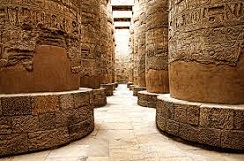
-1290 Rameses I dies, and his son (by Sitre) Seti I (Sethos) ("Of Seth") (Menmaatre) ("Established is the justice of Ra") (Merenptah ("Beloved of Ptah") (d. -1279) becomes king #2 of the Egyptian 19th Dynasty, conducting two campaigns in Syria to stop the advance of the Hittites and reestablish the empire of Thutmose III in Palestine and Syria; he builds the Great Temple of Osiris in Abydos to restore worship of Egypt's traditional gods, with a depiction of Isis' constellation Orion; he also decorates the walls of the Great Hypostyle Hall in Karnak, which is completed by his son Rameses II.
-1282 Nazimaruttash dies, and Kadashman-Turgu (d. -1264) becomes king of Babylon. Pandion II dies in exile after a coup by the sons of Metion, and his son Aegeus (d. -1234) defeats them and becomes king #9 of Athens.

-1280 Traditional date that Moses leads the enslaved Israelites out of Goshen in Egypt - and drowns Pharaoh Rameses II, who goes on ruling for decades?

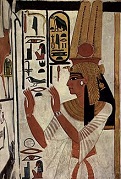
-1279 Seti I dies, and his 5'8" (tall) E Medterranean-looking (long thin face, beaked nose, strong jaw) reddish-blond teenie son Rameses (Ramesses) (Ramses) II (the Great) (-1303 to -1213) becomes king #3 of the Egyptian 19th Dynasty, the #1 pharaoh in Egyptian history; he marries glam babe Nefertari ("Beautiful companion") Meritmut ("Beloved of Mut"), and with her and his other wives Isetnofret (Isitnofret) ("Beautiful Isis") et al. he fathers 100+ children; he puts his face on the red granite Sphinx in the Temple of Ptah in Memphis, which survives to modern times sans face; he builds up his N capital of Pi-Ramesses (Per-Rameses) ("House of Rameses, Great in Victory") in Qantir near Avaris, the former Hyksos capital; he is addicted to tobacco?
-1278 Rameses II decisively defeats the Sherden (Shardana) (Sherdanu) sea pirates (known for their horned helmets) along the Mediterranean coast.
-1276 Rameses II recaptures the district of Phoenicia (Canaan) from the Hittites as far E as Berytus (Beirut), and leaves a memorial stele on the bank of the Nahr al-Kalb (Dog) River N of Beirut.
-1275 Adad-Nirari I dies, and next year Shalmaneser (Shalmeneser) I (Shulanu-Asharedu) (d. -1245) becomes king of Assyria, setting up his royal residence in Nineveh while moving the capital from Assur to Calah 18 mi. S of Ninevah, then immediately mopping up what's left of the Mitanni, conquering eight countries in the NW and destroying the fortress of Arinnu, bringing its dust back with him; Urartu is divided into a number of small kingdoms and ends up as an Assyrian tributary.
-1274 In the 5th year of his reign Rameses (Ramses) II and his 16K infantry and 2K heavy chariots defeats the Hittites and their 15K-40K infantry and 2.5K-3.7K heavy chariots under king (-1295 to -1272) Muwatallish (Mutallu) (d. -1272) (son of Mursili II) at the Battle of Kadesh (Quadesh) on the banks of the Orontes River in N Syria, becoming the earliest battle in human history for which military tactics are known; the Egyptian army uses highly mobile archers on their chariots, which win the day (actually a draw?); too bad, Rameses II is cut off from the main body of his troops and narrowly escapes, causing Egyptian scribe Pentaur to write The Poem of Pentaur in his praise; Rameses never captures the city of Kadesh, and the war drags on for years, ending with a peace treaty; a faience tile from the mortuary temple of Rameses III (not II) shows a moustachioed Hittite captive wearing a cool short kilt under a bright (Libyan?) mantle. Midian oppresses Israel for the next seven years.
-1270 Coming up on The View? In his 2nd year Shalmaneser I defeats King Shattuara (Sattuara) of Hanilgalbat (rebellious vassal of Adad-Nirari I), along with his Hittite and Ahlamu allies, blinds 14.4K POWs in one eye then deports them, and incorporates what's left of the Mittani Kingdom as an Assyrian province. In the 21st year of his reign Rameses II meets a Hittite army under new king Hattusili ("from Hattusa") III (d. -1237) near Kadesh, and after the battle concludes a treaty that establishes Egyptian control over Canaan (Phoenicia) as far E as Byblos (Jebel), plus a strip of territory to the N of Palestine; Rameses marries Hattusili's daughter, and the two empires stay on friendly terms for a cent., the remainder of Rameses' reign being peaceful and taken up with construction of many big bldgs., incl. the Rameseum (mortuary temple) in Thebes and the rock-hewn Temples of Abu-Simbel in Nubia. About this time the first bronze Naue Type II swords (grip-tongue or Griffzungenschwert) (good for slashing) are developed in N Italy or Austria-Hungary, spreading to the Aegean and Ugarit (N Syria) by -1200; named after German archeologist Julius Naue (1835-1907).
Shang Wu Ding dies, and Shang Zu Geng (d. -1258) becomes Shang king #21 of China.
-1264 Kadashman-Turgu dies, and his son Kadashman-Enlil II (d. -1255) becomes king of Babylon.
-1258 Shang Zu Geng dies, and Shang Zu Jia (d. -1235) becomes Shang king #22 of China.
-1257 Israeli judge #6 Gideon (d. -1217) (Heb. "slasher", "warrior") of the tribe of Manasseh and the town of Ophrah in Israel W of the Jordan River tears down his family altar of Baal (Judges ch. 6), has miraculous experiences such as keeping his fleece dry in a wet room, and, after sending 22K of 32K in his army home to show it's really Jehovah's army, then selecting the 300 of them that lap water like dogs (Judges ch. 7), through a ruse he routs the Midianites, after which Israel has no further disburbances during the remaining 40 years of his life, and he fathers 70 sons by many wives while refusing to be made king, although he does mess up by accepting the gold bling bling captured from the Midianites, with which he makes an ephod to Jehovah, which causes people to have "immoral intercourse" (Judges 8:22-27).
-1255 Kadashman-Enlil II dies, and Kudur-Enlil (d. -1246) becomes king of Babylon.
-1252 The Sea People known as the Philistines partially destroy the Phoenician city of Sidon, causing the Phoenicians to flee to the city of Tyre, which is also destroyed but is refounded; the Philistines build the adorable door-stop city of Dor on the foundations of Sidon, and set up the Sidonian State (ends -627), dominating Phoenicia by -1000.




-1250 The Achaeans become the ruling class in Greece. Architecture: About this time the citadel at Mycenae is enlarged with a 23-ft.-thick wall of Cyclopean blocks, incl. the Gate of the Lions (Lion Gate). Untash-napir-risha of Elam founds the new triple-walled capital of Dur-Untash (Chogha-Zanbil) in Khuzestan 30 mi. S of Susa, with a large ziggurat that becomes the only one to survive to modern times. About this time the large beehive tomb Treasury of Atreus in Mycenae is built.
-1246 Kudur-Enlil dies, and Shagarakti-Shuriash (d. -1233) becomes king of Babylon.
-1245 Shalmaneser I dies after conquering everything from Taidu to Irridu, plus all of Mount Kashiar to Eluhat, plus the fortresses of Sudu, and Harranu to Carchemish on the Euphrates, and building palaces in Assur and Nineveh, restoring the world temple in Assur, and founding the city of Nimrod, and in -1243 his son Tukulti-Ninurta I ("My trust is in Ninurta") (d. -1207) becomes king of Assyria (until -1207), sponsoring the Tukulti-Ninurta Epic.
-1244 The Cairo Calendar (Calendar of Lucky and Unlucky Days (ends -1163) begins to be kept, containing daily observations of the Algol triple star system, becoming the earliest historical record of a star's brightness.
-1240 The Assyrians sack Babylon.
-1235 Shang Zu Jia dies, and Shang Bing Xing (d. -1219) becomes Shang king #23 of China.

-1234 Aegeus dies after believing his son killed in Crete and drowning himself (causing the Aegean Sea to be named after him), and his son Theseus (d. -1204) becomes king #10 of Athens after defeating the mean Minotaur (Gr. "bull of Minos") on Crete using a clew (thread) to find his way out of its labyrinth, and disgracing himself by capturing the queen of the Amazons; he goes on to bring Democracy (Gr. demos + kratein = "the people" + "to rule") to Athens, which becomes "the Cradle of Western Civilization".
-1233 - Done Momming? I'll Show Ya? The Egyptian Eggplant Trick Year?-1233 Shagarakti-Shuriash dies, and his son Kashtiliash IV (d. -1225) becomes king of Babylon, going on to wage war against Assyria, which backfires bigtime. At the climax of the year's largest religious festival in Thebes, 70-y.-o. Pharaoh (since -1279) Rameses (Ramses) II (the Great) (-1303 to -1213) stands on the pyramid and lifts his short white robe to reveal to 300K adoring Egyptians an erect thebesing penis, causing them to cheer after seeing that their pharaoh's staff is mighty and that Egypt will prosper; he dies after fathering 100+ (1K+?) children, causing everybody in Egypt to end up looking like him?; according to Norman Mailer, nothing like this happens again until the days of U.S. Pres. Bill Clinton - a lost invention of Egyptian Viagra, or the eggplant trick of John Barth's "Sot Weed Factor"?
-1230 About this time most of the main Mycenaean cities except Athens and Mycenae are destroyed by invaders, probably Sea People, causing exports of pottery to Egypt and Syria to cease.
-1225 Tukulti-Ninurta I of Assyria captures Babylon, kills Kashtiliash IV and installs his puppet Enlil-Nadin-Shumi to rule in his name.
-1224 Kadashman-Harbe II becomes Assyrian gov. of Babylon (until -1223).
-1222 Adad-Shuma-Iddina becomes Assyrian gov. of Babylon (until -1217).
-1220 Traditional date of the Biblical Exodus - was it Merneptah who drowned in the Red Sea after he killed their seed?
-1219 Shang Bing Xing dies, and Shang Geng Ding (d. -1198) becomes Shang king #24 of China.
-1217 The Babylonians revolt against Assyria and reestablish native rule under Adad-Shuma-Usur (d. -1187), son of Kashtiliash IV. Judge Gideon dies, and his son (by a slave concubine from Shechem) Abimelech (Abimelek) (Avimelech) (Heb. "Father of a king") appoints himself Israeli judge #7 and kills all of Gideon's 70 sons except Jotham, who hides; Abimelech rules Israel for three years (Judges 8:28-9:5).
-1214 Tola (Heb. "worm") of the tribe of Issachar becomes Israeli judge #8, judging Israel for the next 23 years.


-1213 Nicotine-loving Rameses II the Great at age 96, and in late July his 14th (13th?) old fart son (by 2nd wife Isetnofret) Merneptah (Merenptah) (d. -1203) becomes king #4 of the Egyptian 19th Dynasty (until May 2, 1203), going on to battle the Sea People, Libyans, and Israelites, moving the capital ffrom Pi-Ramesses to Memphis, where he constructs his royal palace next to the Temple of Ptah, ordering the Merneptah Stele (Stela) erected (in -1208?), the last lines of which read: "Canaan is plundered with every hardship. Ashkelon is taken, Gezer captured, Yanoam reduced to nothing. The people of Israel (Isrir) are laid waste, their seed is no more"; the earliest known non-Biblical reference to Israel, and the only known mention of Israel in Egyptian monuments; Rameses II's mummy is interred at Biban al-Muluk, then put in a secret shaft at Deir-el-Bahri ("the northern monastery"), where it is found in 1881 C.E.
-1212 Alt. date for the beginning of the reign of Merneptah (ends -1202) (Jehovah's Witnesses).
-1207 Tukulti-Ninurta I is murdered by his son Ashur-Nadin-Apli ("Ashur has given a son") (d. -1204).
-1204 After the Dioscuri (twin sons of Leda, and brothers of Helen of Troy and Clytemnestra) set him up, Theseus travels to the underworld, allowing Menestheus (d. -1181) (son of Orneus, son of Erechteus) to become king #11 of Athens, going on to become a jilted suitor of Helen and fight in the Trojan War with "fifty black ships" and prove a coward, although he is one of the warriors in the Trojan Horse.
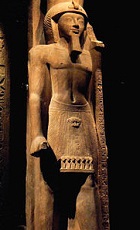
-1203 Merneptah dies, and his son (by Isetnofret II) Seti (Sethos) ("Of Set") II (Userkheperure Setepenre) ("Powerful are the manifestations of Ra, the chosen one of Ra") (d. -1197) becomes king #5 of the Egyptian 19th Dynasty, going on to appoint Syrian official Bay (Ramesse Khamenteru) (-1192) as high chancellor, who becomes the first non-royal to build his tomb in the Valley of the Kings, along with Pharaoh Merenptah Siptah and Pharaoh Twosret. Ashur-Nadin-Apli is overthrown by his son (Tukulti-Ninurta I's grandson) Ashur-Nirari (Ashur-Nerari) ("Assur is my help") III (d. -198), who becomes king of Assyria.
-1202 Alt. date for the end of the reign of Merneptah (begun -1212).

-1201 Amenmesse (Amenmesses) (Amenmose) (Menmire Setepenre) (d. -1198), son of Merneptah and Takhat (Rameses II?) usurps the throne from Seti II, making a mess of his monuments and erasing his name until Seti II defeats him in -1198 and returns triumphantly to Thebes, cleaning up his gawd-awful mess.
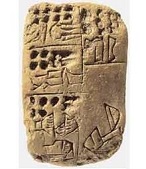
-1200 About 1200-1150 B.C.E. the Bronze Age Collapse, caused by severe drought and cold in the Fertile Crescent, driving peoples S, incl. the Sea People (from the Aegean?), who bring the opium poppy, cumin, and the sycamore tree; the Near East, Asia Minor, Aegean region, E Mediterranean region, Balkans and Caucasus plunge into a Dark Ages via sudden violent attacks, with almost every important city in the E Mediterranean region destroyed, many permanently. The Bronze Age Collapse begins (ends -1100), . The Late Bronze Period of Archaeology begins, and the Early Iron (Iron I) Period of Archeology begins (ends -1000). The Hittite Kingdom in Asia Minor under King Suppiluliuma II (son of Tudhaliya IV) is overrun and destroyed by the Sea People, who destroy the rich city of Alalakh near Ugarit and Aleppo; some Hittite mini-states survive along the Syro-Anatolian border until absorption by Assyria. The Middle Elamite Kingdom (founded -1350) ends with Kiten-Hutran, and Hullutush-Inshushinak I (d. -1185) founds the Dynasty of Hullutush-Inshushinak (ends -1110). About this time (same time as Homer's "Iliad") the Pelasgians ("sea men"?) live in Greece, Asia Minor, and the Aegean Islands, with their name getting used by some ancient writers to refer to people that were either the ancestors of the Greeks or preceded them in Greece, "a hold-all term for any ancient, primitive and presumably indigenous people in the Greek world" (Apolloios Rhodios and Peter Green). In this cent. the kingdom of Phrygia in Asia Minor is founded by Indo-European immigrants from the S Balkans (Thrace), occupying all of Asia Minor from the Sea of Marmara to the Assyrian border; they are divided into the Mushki (Meschech) and Tabal (Tubal) tribal groups; they eventually migrate to Anatolia under the protection of their ally Troy; some of them move to Colossae, and are known as Colossians; the tribal group known as the Thracians emerge in the region between the Aegean Sea and the Carpathian Mts., the Black Sea and the Morava and Vardar Rivers; Thracians from SE Europe found Phrygia in Asia Minor (Anatolia), former home of the Hittites, and unite it, establishing a capital at Gordion (Gordium), near modern-day Ankara (ends -547), worshipping the deities Cybele (Ma, the Great Mother, Mother of the Gods) and Attis, who died and was resurrected; Neo-Hittite kingdoms begin a period of cultural flourishing; Gordion is excavated in 1955; according to Greek legend it is the home of King Midas (Mita of Mushku?); a royal burial is discovered in 1955, but contains no gold, even though unplundered; Phrygian inscriptions remain undeciphered (until ?). In this cent. the kingdom of Lydia in W Anatolia (Turkey) is founded by the Heraclid Dynasty, with capital at Sardes. About this time the confederation of city-states known as the Philistines(Philistia) occupy the S coast of Canaan in Palestine (until -604). The earliest known human with metastatic cancer is buried in a tomb in Sudan. In this cent. the Cimmerians (who live in a land of eternal night, according to Homer) (origin of the name Crimea) occupy the S Russian steppes, with their eye on Phrygia. In this cent. the Tiwanaku (Tahuanaco) ("stone in the center"?) culture is founded near Lake Titicaca in W Bolivia, becoming the precursors of the Incas (ends 1000 C.E.). About this time Chavin de Huantar in Peru 160 mi. N of modern-day Lima is built by the pre-Incan Chavin culture until about -400. About this time the Achaean citadels in Greece fall, and their civilization crumbles. About this time Tapputi (Tapputi-Belatekallim) lives in Babylonian Mesopotamia, distilling and filtering perfumes and becoming the world's first known chemist. In this cent. the port of Lisbon on the Tagus River in Lusitania ("land of the raven people") (modern-day Portugal) (orginally called Allis Ubbo, meaning "safe harbor" in Phoenician, later corrupted to Ulisaypo or Olissipo from the belief that Ulysses of Trojan War fame founded it) is founded by Celts and an aboriginal pop., who later form the Cempsi tribe, known for convex-head arched-neck Lusitanian (Lusitano) horses, the best for chariot racing. By this time the Celts in Britain consist of two stocks, the Goidels (Gaels) in N Ireland and the Scottish highlands, and the Cimbri (Cymbri) (Cymri) (Combroges) ("co-landers") (Welsh) and Britons (Brythons) (kin to the Belgae in Gaul) in Wales and the lowlands; the Cimbri may have started in Jutland, giving their name to Cumberland, and might have been Germanic; their religion is dominated by the Druids; gold is mined in Ulster, Ireland. Burial pits near Guanghan in China (Sichuan province) contain bronze vessels and elephant tusks. Horses are buried in Mongolia in the E Eurasian steppe. By this cent. the Urnfield Culture in C Europe is based on an aristocratic class, farmer class, and serf class, and cremates their dead, burying them in urns in flat graves. Dried grapes dating to this time are found in Sardinia, becoming the oldest to survive to modern times. Mahram Bilqis (Temple of the Moon God) in 3 mi. from Ma'rib in N Yemen is built by the Queen of Sheba, and used until about 550 C.E.; unearthed in 1951 by Am. archeologist Wendell Phillips (1921-75). A series of temples is built by the Olmecs in San Lorenzo, Mexico. The Tablet of the Curse, found near Mount Ebal is the oldest known Hebrew text mentioning the name of God. About this time Beirut-born Phoenician historian Sanchoniatho (Sanchuniathon) (Sancuniates) allegedly thrives, leaving three books, which are partially preserved by Philo of Byblos and Eusebius of Caesarea. Egyptian beer brewer Khonso Em Heb, chief beer maker of the gods dies a big man in Thebes. About this time sheep-goat's-milk cheese is put in the tomb of high-ranking Egyptian official Ptahmes, becoming the oldest known solid cheese. Inventions: About this time the Chinese independently invent writing.
-1199 The city of Ephesus (Ephesos) on Mt. Pion in SW Ionia on the coast of Asia Minor on the S side of the Cayster River is allegedly founded by Androclus (Androcles), son of Athenian King Codrus (Strabo, 14.1.3) with the aid of Ionian colonists, and develops into the largest commercial center in Asia; the worship of moon goddess Artemis (Cybele) (Rhea) (Ma) (Diana) (Cynthia, born in Mt. Cynthos), "Great Mother of the Gods" (born hermaphroditic, but turned female by the Olympian gods) is already established when the Greeks move in?
-1198 Shang Geng Ding dies, and Shang Wu Yi (d. -1194) becomes Shang king #25 of China (until -1194), becoming known for his cruelty and arrogance, playing a game of Liubo against God - on the last day of his life?
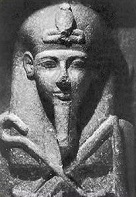
-1197 Seti II dies, and in Dec. with the help of kingmaker Chancellor Bay, his (Amenmesse's?) 10-y.-o. son (by Shoteraja/Sutailja) Merenptah Siptah (Akhenre Setepenre) (d. -1191) becomes king #7 of the Egyptian 19th Dynasty, executing Chancellor Bay in the 5th year of his reign for getting too uppity. Ashur-Nirari III is overthrown by Enlil-Kudurri-Usur (d. -1193), son of Tukulti-Ninurta I.
-1195 A confederacy of peoples attack Egypt, and a Hittite prince is captured?
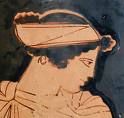





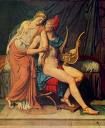
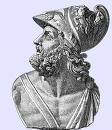


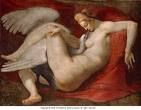




-1194 Shang Wu Yi dies, and Shang Tai Ding (d. -1192) becomes Shang #26 king of China. The original Hatfield-McCoy Feud? The Trojan War (ends -1184) begins when Prince Paris (Alexander), son of King Priam and Queen Hecuba of Troy (Ilium) on the Hellespont (known for his prowess with a bow) goes on a diplomatic mission to Spartan king Menelaus, and falls in love with his beautiful wife Helen, then abducts her and takes her with him back to Troy (founded by Dardanus, son of the god Saturn), pissing-off Menelaus, who gets his brother King Agamemnon of Mycenae (in the NE Peloponnesus 55 mi. SW of Athens) to join him, along with loose cannon Achilles of Thessaly, son of King Peleus of the Myrmidons and the Nereid Thetis; the whole thing started when Eris, goddess of discord, pissed-off at being excluded from a marriage throws a golden apple inscribed "To the Most Beautiful" into the gathering, and Paris awards it to Aphrodite, causing her to promise Helen to him?; according to Herodotus (Bk. 1), it all started when the Phoenicians first arrived from the Red Sea (Indian Ocean), and kidnapped Io and other maidens from the top Greek island of Argos and took them to Egypt, after which more Greeks kidnapped Europa, daughter of the king of Tyre, then Greek Jason and the Argonauts got the same idea and did ditto to Medea, daughter of the king of Colchis, causing Priam to think that he had a right to get a wife by kidnap, and when the Greeks actually made him pay for it for once, it pissed off the Persians, who claimed to own all peoples in Asia Minor, causing them to become the enemies of the Greeks; actually a ton of Greek bucks had courted Helen before her marriage, and all had been made to promise Menelaus to defend her in advance?; the Greeks then launch a fleet of 1K ships and 50K men at Troy, which itself has no navy but has an impregnable fortress city, and the classic confrontation of irresistible force and immovable object is on; no ordinary Bronze Age Greek supermodel, Helen (Gr. "torch", or "selene" = Moon?) of Troy, "the face that launched a thousand ships" is the daughter of Zeus (in the form of a swan) and Spartan queen Leda (daughter of King Thestius of Aetolia), who on the same night was also impregnated by Spartan king Tyndareus (two fertilized eggs at the same time), producing her twin siblings Castor and Pollux (Kastor and Polydeuces) (mortals) and (from her first egg) Helen and Clytemnestra, whom Agamemnon married after killing her first hubby Tantalus in order to become king of Mycenae, after Clytemnestra bears him Orestes (Gr. "mountaineer"), Iphigenia (Iphigeneia) (Gr. "strong-born"), Electra, and Chrysothemis, then after he sacrifices Iphigenia to make the winds return so his fleet can sail to Troy, she waits till he gets back from Troy with Trojan princess Cassandra, pissing her off more, and murders them both so that her new beau Aegisthus (Gr. "goat strength") can become king, after which Orestes and Electra of the now doomed House of Atreus murder them both.
-1192 Enlil-Kudurri-Usur is overthrown by Ninurta-Apal-Ekur (d. -1180), who becomes king of Assyria. Shang Tai Ding dies, and Shang Di Yi (d. -1154) becomes Shang king #27 of China.
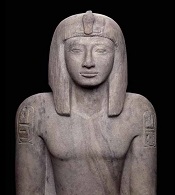
-1191 Merenptah Siptah dies, and Seti II's 2nd wife (sister of Amenmesse?) Twosret (Tausret) (Tawosret) (Sitre Meryamun) ("Daughter of Ra, beloved of Amun") (d. -1189) becomes king #8 (last) of the Egyptian 19th Dynasty, ruling 1.5-3 years after absorbing Siptah's regnal years into hers to stretch it to seven years, building the Temple of Millions of Years in Gournah. The Semitic Kingdom of Ammon (descended from Ben-Ammi, son of Lot and his younger daughter) begins oppressing Israel for the next 18 years; Jair of the tribe of Gilead becomes Israeli judge #9, judging Israel for the next 22 years.
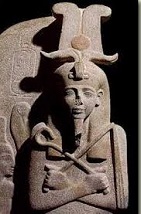
-1189 After a civil war, Twosret dies, and usurper Setnakhte (Setnakht) (Sethnakht) (d. -1186) becomes king #1 of the Egyptian Twentieth (20th) Dynasty (ends -1077), refusing to acknowledge the two previous pharaohs, and marrying Tiy-merenese (Teye-Merenaset) (Tiye-Mereniset) (daughter of Merenptah?) in an attempt to make his rule more legitimate; too bad, his reign is marked by the corruption of the govt. by increasingly powerful priests.
-1188 The Phoenicians attack Egypt and are repulsed.
-1187 Adad-Shuma-Usur dies, and Melishipak (d. -1172) becomes king of Babylon.
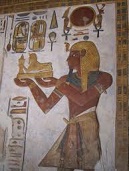
-1186 Setakht dies, and his son (by Tiy-Merenese) Usimare Rameses (Ramses) (Ramesses) III (Rhampsinitus) (d. -1155) becomes king #2 of the Egyptian 20th Dynasty, and the last great pharaoh of the New Kingdom, seeing a series of invasions (incl. the Sea People) and economic problems bring the kingdom into decline; the rest of the Rameses line are whimps, often elderly, and with short, er, reigns?; he marries Tyti; references to Punt drop out after his reign, indicating the introduction of camel caravans in Arabia that end their maritime trade; Rameses III's mummy is found at Deir-el-Bahri in 1881 C.E.
-1185 After defeating the Kassites, Shutrukid king #2 Shutruk-Nakhunte (d. -1155) becomes king #1 of the Elamite Empire (ends -1120).



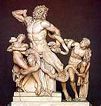

-1184 On June 11 the impregnable walled city of Troy (Ilium) in Asia Minor near the Hellespont (Dardanelles) is destroyed by fire in the last year of the 10-year Trojan War after the first special ops commando raid in history, made possible by the original 1-trick pony Trojan Horse (the original Kobayashi Maru Maneuver?), which Trojan priest Laocoon (Laocoön) tries in vain to expose by tapping with a spear, causing the goddess Athena to send sea serpents to strangle him and his sons Agesander, Athenodoros, and Polyclitus, which the Trojans interpret as proof that the horse is sacred; the doings in the 10th year are later celebrated by Homer's Iliad; the U.S. 10th Special Forces Group (Green Berets) later features a silver Trojan Horse on their badge; a band of survivors led by Aeneas (son of Aphrodite or Venus and Anchises, a cousin of King Priam) escape and search for a new home, ending up in Rome (Latium), where King Latinus (son of Inachus, son of Dardanus, son of Saturn) allows them to stay, and reneges on a promise to King Turnus of the Rutuli, marrying his daughter Lavinia to Aeneas instead, causing Turnus to turn-turn-turn declare war on Aeneas, which he loses, getting killed, after which Aeneas' Troy-born son (via 1st wife Creusa, who dies before reaching Latium) Ascanius founds Alba Longa SE of Rome on Lake Albanus in the Alban Hills (ends 7th cent. B.C.E.), and becomes its first king, establishing the line that leads to Romulus and Remus; Homer's Odyssey contains one of the earliest historical references to Crete, claiming that it's populated by Achaeans, Cydonians, Pelasgians, Dorians, and Eteocretans (pre-Hellenic natives), and has 90 independent cities, with #1 being Cnossos; shortly after the Trojan War ends, the city of Tenea is founded 15 km SE of Corinth and 20 km NE of Mycenae by Trojan POWs with the permission of Agamemnon.
-1183 The city of Padua in the Euganean Plain of N Italy on the Bacchiglione and Brenta Rivers (25 mi. W of Venice, 20 mi. SE of Vicenza) is founded by Trojan prince Antenor_(mythology), who colonizes it with his Paphlagonian allies assisted by the native (Celtic?) Adriatic Veneti (Heneti) ("sacred salmon people") from the N end of the Adriatic Sea, who become known for their excellent horse breed and wool; the Romans later call it Patavium; in modern times it claims to be the oldest city in Italy: a large stone sarcophagus is exhumed in 1274 C.E. and declared to be the relics of Antenor.
-1181 Menestheus dies, and his son Demophon (d. -1147) becomes king #12 of Athens.
-1180 Rameses III expels the Libyans from the W side of the Egyptian delta. Ninurta-Apal-Ekur dies, and his son Ashur-Dan I (d. -1134) becomes king of the proto-empire of Assyria.
-1178 In the 8th year of his reign, Rameses III wins the naval Battle of Djahy (Canaan) (the Delta) against the piratical Sea People AKA the Peleset AKA the Philistines, who left the S shore of Asia Minor and settled in SW Canaan on the S coastal plain and were making forays into the Nile Delta; too bad, this battle marks the start of the New Kingdom's decline during the Bronze Age Collapse. On Apr. 16 Odysseus returns to Ithaca at noon and wins an archery contest?
-1177 The year that civilization collapsed?

-1175 By this time the Hittite mini-states are gobbled up by Assyria? Rameses III builds his temple palace at Medinet Habu on the W Bank of the Nile in Luxor; the Mortuary Temple of Ramses III in Medinet Habu celebrates his Vs over the Sea People.
-1174 Rameses III repels a Libyan invasion.
-1173 Rameses III defeats the tall blonde-blue (aquiline noses, pointed beards) Amorites of Palestine, bringing back their king along with rich booty which he uses to endow temples to Amon, esp. at Thebes. Israeli judge #10 Jephthah (Jephtha) of Gilead (tribe of Manasseh or Gad) is victorious over Ammon 300 years from the start of the Israelite conquest of Canaan (Judges 11:26-33); too bad, after vowing to make a holocaust (burn offering) of the next person he meets, he burns his own virgin daughter (Judges 11:35-40).
-1172 Melishipak dies, and his son Marduk-Apal-Iddina I (Merodach-Baladan) (d. -1159) becomes Kassite king of Babylon.
-1170 Birth of Israeli judge #13 Samuel (Heb. "Name of God") in Shiloh (Heb. "tranquil, secure") (20 mi. N of Jerusalem) (first resting place of the Tabernacle) of father Elkanah and mother Hannah; of the tribe of Ephraim (1 Sam. 1:20).
-1167 Izban of Bethlehem judges Israel for the next seven years (Judges 12:8).
-1160 Elon of Zebulun judges Israel for the next 10 years (Judges 12:12).
-1159 Mt. Hekla in S Iceland erupts, creating a "nuclear winter" for Scotland, and beginning an 18-year period of worsening climate. Marduk-Apal-Iddina I dies, and Zababa-Shuma-Iddina (d. -1158) becomes king of Babylon. Shutruk-Nahhunte of Elam leaves Susa with a vast army and begins to plunder Sumer - the endless Sumer?
-1158 Zababa-Shuma-Iddina dies, and Enlil-Nadin-Ahhe (Enlil-Shuma-Usur) (d. -1155) becomes king of Babylon.
-1157 Shutruk-Nahhunte of Elam takes Babylon, appoints his son Kutir-Nahhunte III (d. -1150) as gov., and brings back spoils to Susa, incl. the Code of Hammurabi; Babylonia fights on. Philistia oppresses Israel for the next 40 years.

-1155 Rameses III dies, and after the first four sons have already died, his 5th son (by Tyti) Heqamaatre Rameses (Ramses) (Ramesses) IV (Amonhirkhopshef) (d. -1149) becomes king #3 of the Egyptian 20th Dynasty, which is increasingly dominated by the priesthood, making pharaohs into puppets; his wife is Duatentopet (Tentopet). Shutruk-Nahhunte dies, and his son Kutir-Nahhunte III (d. -1150) becomes king of Elam, trying to hold onto Babylonia; Assyria and Elam attack Babylonia, ending Kassite rule; Enlil-Nadin-Ahhe dies.
-1154 Marduk-Kabit-Ahheshu (d. -1146), prince of Isin retakes Babylon from the Elamites, founding the Fourth Babylonian (Second Isin) Dynasty; Babylon goes on to become the world's largest city, covering 10K hectares (about the size of modern-day San Francisco). Shang Di Yi dies, and Shang Zhou (Chou) (d. -1134) becomes Shang king #28 of China; the cruelest king in Chinese history?; known for the invention of chopsticks (kuaizi) (bad luck to leave them standing in food straight up?) - ouch that must hurt?

-1155 Rameses III dies, and after the first four predecease him, his 5th son Rameses (Ramses) (Ramesses) IV (Amonhirkhopshef) (d. -1149) becomes king #3 of the Egyptian 20th Dynasty, which is increasingly dominated by the priesthood, making pharaohs into puppets; Rameses III's mummy is found at Deir-el-Bahri in 1881 C.E.

-1150 About this time the Greek Dark Ages (Geometric or Homeric Age) begin (end -800 to -750) as the Hellenic Dorians invade and settle mainland Greece and Sparta, and begin calling it Hellas (Gr. "Land of the Hellenes"); the Aeolians (originally from Thessaly, one of the four major Greek Tribes along with the Dorians, Ionians, and Achaeans, claiming descent from King Aeolus of Thessaly, son of Helen, ancestor of the Hellenes, and father of Sisyphus) settle on the W coast of Asia Minor between the Dardanelles and the Hermus River, and on the island of Lesbos; by modern times the Aeolian dialect is considered the oldest form of Hellenic speech; the Thessalians (first and best Greek horsemen) claim that Poseidon made their fertile plain habitable by creating an outlet for the Peneius River for the first monarchs Deucalion (Deukalion) and his wife Pyrrha (daughter of Epimetheus and Pandora); Greek historian Diodorus of Sicily (Diodorus Siculus) (-90 to -21), later claims that the first Thessalian colonists came from Egypt, which connects with their myth that Poseidon created the horse; about this time Mycenaean civilization ends, and Greek history grows dark until the first Olympics in -776, causing David Michael Rohl (1950-) et al. to propose shifting all dates forward by 200-350 years - meet the new stars of High School Musical III? Kutir-Nahhunte III dies, and Shilak-Inshushinak I (d. -1120) becomes king of Elam, going on to conquer large areas in the highlands and parts of Mesopotamia, becoming one of Elam's Hall of Famers? The Canaanite stronghold of Dan is conquered by the Hebrew tribe of Dan. A robber confesses under torture to violating the tomb of Ramses II then going "across the path" to rob the tomb of his sons.
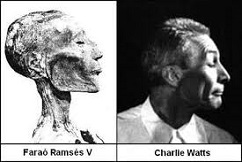
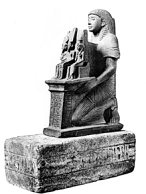
-1149 Rameses IV dies, and his son (by Duatentopet) Usermaatre Sekheperenre Rameses (Ramses) (Ramesses) V (d. -1145) becomes king #4 of the Egyptian 20th Dynasty, suffering the power of the priests of Amun, led by high priest Ramessesnakht, who control the temple land and state finances, incl. a financial scandal by the priests of Elephantine; Libyan raiding parties interrupt workmen in Deir el-Medina working on his tomb. Demophon dies, and his son Oxyntes (d. -1135) becomes king #13 of Athens.
-1146 Marduk-Kabit-Ahheshu dies, and Itti-Marduk-Balatu (d. -1132) becomes king of Babylon.

-1145 Rameses V dies of smallpox, and his uncle (son of Sameses III and Iset Ta-Hemdjert) Rameses (Ramses) (Ramesses) VI Nebmaatre-meryahum ("Lord of justice is Ra, beloved of Amun") (Amenhirkhepshef II) (d. -1137) usurps the throne, becoming king #5 of the Egyptian 20th Dynasty; his tomb is built over the entrance to Tutankhamun's, protecting it, which is lucky since it is robbed soon after the burial, and the graverrobbers hack off his hands and feet to get at the jewelry.

-1136 Rameses VI dies, and his son Usermaatre Setepenre Meryamun Rameses (Ramses) (Ramesses) VII (Itamun) (d. -1129) becomes king #6 of the Egyptian 20th Dynasty.
-1135 Oxyntes dies, and his son (by Phillis) Apheidas (d. -1134) becomes king #14 of Athens.
-1134 Apheidas is assassinated by his younger brother Thyometes (d. -1126) becomes king #15 of Athens, becoming the last king descended from Theseus. Shang Zhou dies, and Chou-hsin (d. -1122) becomes Shang king #29 of China, becoming known as an evil debauched despot who is into tasty aphrodisiacs, incl. Hunting Lion (bear paws, rhino horn, human urine), Celestial Thunder (peacock tongues, chili powder, sperm from teen boys), and Three-Day Glory (soy beans, ginseng, ox penis, dried human placenta); about this time the first cast copper coins are produced in China under the Shang Dynasty. Ashur-Dan I dies.
-1133 Ashur-Dan I's son Ninurta-Tukulti Ashur becomes king of Assyria, and is overthrown by his brother Mutakkil-Nusku (d. -1132); Matakkil-Nusku dies, and his son Ashur-Resh-Ishi I (d. -1116) becomes king of Assyria.
-1132 Itti-Marduk-Balatu dies, and Ninurta-Nadin-Shumi (d. -1126) becomes king of Babylon.


-1129 Rameses VII dies, and Rameses III's last surviving son Usermaatre Akhenamun Rameses (Ramses) (Ramesses) VIII (Sethhirkhepeshef Meryamun) ("Set is his strength, beloved of Amun") (d. -1129) becomes the lucky king #7 of the 20th Dynasty, ruling up to 1 year, becoming the only 20th Dynasty pharaoh whose tomb has not been identified in the Valley of the Kings; Rameses VIII dies, and Rameses III's grandson (via Mentuherkhepeshef and Takhat) Rameses (Ramses) (Ramesses) IX (Khaemwaser I) (Neferkare Setepenre) ("Beautiful is the soul of Ra, chosen of Ra") (d. -1111) Amenhotep becomes high priest of Amun, who continues to serve under Rameses X and Rameses XI; a Theban tomb-robbing scandal rocks his admin. during regnal years 16-17.
-1128 Abdon of Ephraim, son of Hillel the Pirathonite becomes judge #12 of Israel, judging for the next eight years (Judges 12:15).

-1126 Ninurta-Nadin-Shumi dies, and Nebuchadnezzar (Nebuchadrezzar) I (Nabu-Kudurri-Usur) (d. -1103) becomes king of Babylon. In exchange for defeating pesky King Xanthus of Thebes in single combat to end a war over border city Oenoe, Thyometes gives his throne to Melanthus (d. -1089) (a descendant of Nestor's father King Neleus of Pylos in Messenia), who becomes king #16 of Athens.
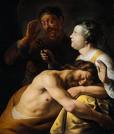
-1125 Judge Samson (d. -1105) (Heb. "Sun") of the tribe of Dan judges Israel for the next 20 years until Delilah (Heb. "seductive") cuts his rays, er, hair.

-1122 Zhou Wu Wang (d. -1119) (-1046 to -1043?) and his father Wen revolt against Chou-hsin, ending the Shang Dynasty and founding the Xi (Northern) Zhou (Chou) Dynasty (China's 3rd dynasty) (ends -256), awarding Korea to Chinese prince-scholar Qi Zi (Ji-zi) (Ki Tse), who founds the independent Kingdom of Choson (Chosen) (Joseon) (ends -194/-108). about this time the city of Peiping (later Peking and Beijing) ("northern capital") (modern-day pop. 18.6M/24.9M) in NE China 90 mi. NE of the Gulf of Pohai and 12 mi. W of the Pei River is founded as a frontier outpost; it is walled about 1045 B.C.E.
-1120 Shilak-Inshushinak I dies, and Hutelush-Inshushinak (d. -1110) becomes king of Elam.
-1116 Ashur-Resha-Ishi I, "the avenger of Assyria" dies, and Mutukkil-Nusku (d. -1114) becomes king of Assyria.
-1115 The Ark of the Covenant is captured by the Philistines at Shiloh (1 Sam. 3:3, 4:3-12, 6:1, Josh. 18:1), recaptured, and moved to Beth Shemesh, then to Kiriath-Jearim for 70 years (1 Sam. 6:11-14, 7:1-2); Eli's high priesthood ends (1 Sam. 4:18), but Samuel continues as priest-prophet-judge (1 Sam. 6-7); Saul's eldest son Jonathan is born (1 Sam. 13:1-2, 1 Chron. 8:33). Ji Dan, duke of Chou (Zhou) in China writes Against Drunkenness, containing the first written definition of tea.
-1114 Mutukkil-Nusku dies, and Tiglath-Pileser (Tukulti-Apil-Esharra) I (d. -1077) becomes king of Assyria.
-1112 Tiglath-Pileser I campaigns against the nomadic Ahlamu-Arameans, who reach as far W as Tadmor (Palmyra in Syria) and the Lebanon Mts.

-1111 Rameses IX dies, and (his son?) Rameses (Ramses) (Ramesses) X (Amonhirkhepeshef Khepermaatre) ("The justice of Ra abides") (d. -1107) becomes king #9 of the Egyptian 20th Dynasty, becoming the last New Kingdom pharaoh to rule over Nubia; meanwhile Libyan Berber Meshwesh (Ma) from the desert maraud in the Valley of the Kings, slowing workmen.
-1110 About this time Nebuchadnezzar I overruns Elam and sacks Susa, taking Anshan; Hutelush-Inshushinak dies, ending the Hullutush-Inshushinak Dynasty in Elam (founded -1200).


-1107 Rameses X dies, and (his son?) Rameses (Ramses) (Ramesses) XI (Khaemwaset II) (Menmaatre Setpenptah) (d. -1077) becomes king #10 (last) of the Egyptian 20th Dynasty, reigning for 29-30 years; his wife is Tentamun ("She of Amun"), who bears him Duathathor-Henuttaway (Henttawy) ("Adorer of Hathor, mistress of the Two Lands"), who marries Pinedjem I, high priest of Amun at Thebes in -1070 to -1032, who becomes the de facto ruler of 21st Dynasty Upper Egypt starting in -1054.

-1105 Israeli Judge Samson dies kicking Philistine butt in an epic scene.
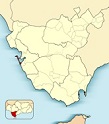
In 1104 B.C.E. the island city of Cadiz (Cádiz) in SW Spain (modern-day pop. 123K) is founded as Gadir (Agadir) ("wall", "compound") by the Phoenicians, becoming the oldest W Euro city to survive to modern times, trading with the city-state of Tartessos near the mouth of the Guadalquivir River until it is flooded out; a temple to the Phoenician god Melqart is built on the S end, later conflated by the Greeks and Romans with Hercules as Hercules Gaditanus and the Tyrian Hercules, becoming known for its oracle and wealth; later the Greeks claim that the city was founded by Hercules after his Tenth Labor, the slaying of 3-headed Geryon; the Herculeum (Temple of Melqart) is still standing in the 1st cent. C.E., giving rise to the myth of the Pillars of Hercules?; same as the Biblical city of Tarshish?
-1103 Nebuchadnezzar I dies, and Enlil-Nadin-Ahhe (Enlil-Nadin-Apli) (d. -1100) becomes king of Babylon.
-1102 Zhou Cheng Wang establishes his capital at Leyi.
-1100 The Bronze Age Collapse (began -1250) ends. Enlil-Nadin-Ahhe dies, and Nebuchadnezzar I's brother Marduk-Nadin-Ahhe (d. -1082) becomes king of Babylon. The Arameans begin squatting on Assyrian and Babylonian lands, and push the Urartians back to their homeland around Lake Van in Armenia. About this time Egypt loses its control over the Sea Peoples of Phoenicia, which becomes independent, turning the Mediterranean Sea into a Phoenician lake for the next 2.5 cents.; Tyre grows stronger than its rival Sidon; in this cent. the Phoenicians found maritime merchant colonies in the established cities of Gaza in Palestine, Memphis in Egypt, and Kition (Latarkia) in Cyprus, and discover the Pillars of Hercules; the N one is Calpe (Aulibe) (later called the Rock of Gibraltar), and the S one is Abila (Sierra Bullones) at Ceuta on the N African coast (later called Jebel Musa); the Phoenicians crown them with silver columns to mark the limits of Mediterranean navigation; named for the labor of Hercules where he had to fetch the cattle of Geryon and bring them to Eurystheus, and smashed a hole in Mt. Atlas to reach the island of Erytheia, forming the Strait of Gibraltar (then narrowed it to keep sea monsters out?). About this time Doric (Dorian) Hexapolis, a federation of six Doric cities in SW Asia Minor on adjacent islands is founded (until -560), incl. Cos on the island of Cos, Cnidus (Knidos) in Caria, Halicarnassus in Caria (modern-day Bodrum, Turkey) on the Ceramic Gulf, Lindus on the E coast of the island of Rhodes (known for wine and figs), Ialysus (Ialysos) on the island of Rhodes 6 stadia SW of the city of Rhodes, and Camirus (Kamiros) (Cameirus) (Kameiros) on the NW coast of the island of Rhodes; they all celebrate a festival and games on the Triopian Promontory near Cnidus in honor of Apollo, with winners awarded brazen tripods that they have to dedicate to Apollo's temple; too bad, a winner from Halicarnuss takes the tripod to his own house first, causing Halicarnassus to be kicked out of the Doric Hexapolis, reducing it to the Doric Pentapolis. A cemetery in Ashkelon contains 200+ graves. People from the Near East spread into East Africa. The residents of the lower Ulua Valley in N Honduras are enjoying chocolate drinks, making it the Cradle of Chocolate. Nonfiction: The Instruction of Amenemope is written about this time by Amenemope, a resident of Akhim in Upper Egypt on the E side of the Nile River; really written by pharaoh Amenenope (-1001 to -992)? - sounds mightly like Proverbs?
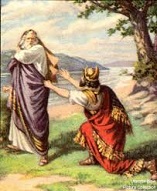
-1095 After being anointed by Judge Samuel, Saul (d. -1055) (Heb. "asked of God"), son of Kish becomes the first king of a united Israel 356 years from the start of the Israelite conquest of Canaan ("land of purple"); he rules 40 years, nearly annihilating the warlike nomadic Amelekite tribe of SW Palestine (1 Sam. 10:24, 2 Sam. 5:4, 1 Ki. 6:1, Deut. 2:7, Acts 13:21).
-1090 In the 18th year of Rameses XI, Amun high priest Amenhotep is ousted by Pinehesy (Panehesy) (Panehasy), viceroy of Kush, causing Rameses XI to begin counting his regnal years over starting with 1 in the Wehem Mesut (Renaissance), a year of rebirth after years of drought are ended by an unusually high inundation of the Nile River.
-1089 Melanthus dies, and his son Codrus (d. -1068) becomes king #17 (last) of Athens.
-1085 Birth of future Israeli king David (d. -1015) (Heb. "beloved") in Bethlehem (1 Sam. 16:1, 2 Sam. 5:4), 14 generations after Abraham; the Babylonian Captivity is 14 generations ahead.
-1082 Marduk-Nadin-Ahhe dies in a famine, and Marduk-Shapik-Zeri (d. -1069) becomes king of Babylon. Amenhotep, high priest of Amun wars with Amenhotep, viceroy of Kush, during which pharaohs' tombs are plundered (ends -1080)
-1078 Zhou Cheng Wang dies, and Zhou Kang Wang (d. -1052) becomes Xi Zhou king #3 of China.

-1077 Rameses XI dies, ending the New Kingdom (begun -1550), and the Third Intermediate Period (ends -664) in Egypt begins, marked by political instability, division, decline, and foreign conquest, while the pharaohs mainly control Lower Egypt (from Tanis) and the high priests of Amun in Thebes de facto rule Middle and Upper Egypt; Lower Egypt gov. (based in Tanis) Hedjkheperre Setepenre ("Bright is the manifestation of Ra, chosen of Amun") Smendes (Smedes) Nesbanebdjed ("He of the Ram, Lord of Mendes") (d. -1052) (son of Hrere, chief of the harem of Amun-Ra) and Smendes' brother-in-law Hrihor (Herihor) (Her Hor) (high priest of Amon in Karnak since -1080) dethrone Rameses (Ramses) (Ramesses) XII (son of Rameses VII) and divide Egypt between them, with Lower Egypt going to Smedes, with admin. center at Tanis (Djanet) (Zoan in the Bible) (later Thebes of Lower Egypt) (modern-day San El Hagar) on the Tanaitic branch of the Nile in the NE Nile Delta (built after the branch that runs by Pi-Ramesses silts up), and Upper Egypt to Hrihor, who rules out of Amon-Ra's wealthy city of Thebes, founding the Egyptian Twenty-First (XXI) (21st) (Tanite) Dynasty (ends -943). Tiglath-Pileser I is murdered, and his son Asharid-Apal-Ekur (d. -1074) becomes king of Assyria.
-1075 After Saul screws up in Jehovah's eyes, Judge Samuel anoints David as king designate of Israel (1 Sam. 16:13), pissing-off Saul, who seeks to have him killed, causing David to become a fugitive; somewhere along the way David meets up with Abigail (Heb. "fountain of joy"), wife of wealthy Carmel chief Nabal, who treats David shabby, causing her to rush out to pacify him with food and supplies as he is on his way to kill Nabal; after Nabal dies, David marries her (1 Sam. ch. 25).
-1074 Ashur-Bel-Kala is succeeded by his brother Ashur-Bel-Kala (d. -1057) as king of Assyria.
-1069 Marduk-Shapik-Zeri is overthrown by Adad-Apal-Iddina (d. -1046), who becomes king of Babylon.
-1068 Codrus dies, ending the Aegeides Dynasty along with its king, and his son Medon (d. -1048) becomes the first hereditary archon of Athens (ends -753).

-1055 Death of Israeli King Saul after ruling 40 years (1 Sam. 31:7); Bethlehem-born former shepherd David (Elhanan) (-1085 to -1015) is anointed as king #2 of Israel at Hebron (until -1015) (-1010 to -970?) (2 Sam. 2:4).
-1054 Ashur-Bel-Kala is overthrown by his uncle Shamshi-Adad IV (d. -1050), son of Tiglath-Pileser I, who becomes king of Assyria (until -1054).
-1051 Neferkare (Nephercheres) Amenemnisu (Neferkare-Heqawaset) (d. -1047) becomes king #2 of the Egyptian 21st Dynasty; during his reign High Priest Menkheperre pardons several leaders of a rebellion who had been exiled to the Western Oasis during the reign of Smendes.
-1050 The Philistines, known for their iron weapons decisively defeat the Israelites, causing the latter to unite. Shamshi-Adad IV dies, and his son (grandson of Tiglath-Pileser I) Ashurnasirpal (Ashur-Nasir-Apli) I (d. -1032) ("Ashur is protector of the heir") ("Ashur is guardian of the son") becomes king of Assyria; the Arameans shrink Assyrian territory to 75 mi. on a side.
-1048 Medon dies, and his son Akastos (d. -1012) becomes king of Athens. David is anointed king over all Israel (2 Sam. 5:3-5).
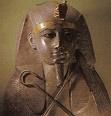

-1047 Amenemnisu dies, and Pinedjem I's son (by Henuttaway, daughter of Ramesses XI and Tentamun) Psusennes (Pasebkhanut) (Pasibkhnu) (Hor-Pasebakhaenniut) ("The star appearing in the city") (Akheperre Setepenamun) ("Great are the manifestations of Ra, chosen of Amun") I (d. -1001) becomes king #4 of the Egyptian 21st Dynasty at Tanis, and takes the title of High Priest of Amun (Amon); his wife-sister is Mutnedjemet (Mutnodjme); he builds up the capital city of Tanis with the Temple of Amun-Re (Amon-Ra), which is added to until the time of Shoshenq III (-798). David takes Jerusalem (originally Jebus?) by sending his soldiers through the King David Water Shaft leading into the city from the Gihon Spring, making it his capital (2 Sam. 5:6,7) nd reigning until 970 B.C.E., gaining control of the site of the future temple from the Jebusite (Canaanite tribe) Araunah; the Ark of the Covenant is brought into Jerusalem (2 Sam. 6:2-15, 1 Chron. 13:1-11, 15:13, Num. 4:15); it really happened in -1003?
-1046 Adad-Apal-Iddina dies, and Marduk-Ahhe-Eriba becomes king of Babylon.
-1045 Menkheperre (son of Pinedjem I and Duathathor-Henuttaway, daughter of Rameses XI and Tentamon) becomes high priest of Amun at Thebes (until -992), going on to pardon several leaders of a rebellion who had been exiled to the Western Oasis during the reign of Smendes. Marduk-Ahhe-Eriba dies, and Marduk-Zer-X (d. -1033) becomes king of Babylon.
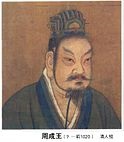
1043 Zhou Wu Wang dies, and next his son Zhou Cheng Wang (d. -1006) becomes Xi Zhou king #2 of China, with his uncle the Duke of Zhou as his regent, going on to establish the capital in Luoyang, defeat several barbarian tribes along the border, and defeat a rebellion by his uncles Cai Shu, Guan Shu, and Huo Shu.
-1040 Alt. date for the birth of King David of Israel, adding 45 years to Bishop Ussher's chronology.
-1035 Birth of Israeli king #2 Solomon (d. -975) (-990 to -930?) in Jerusalem; son of David and Bathsheba (wife of Uriah the Hittite); even though he's not his eldest son, David promises Bathsheba that he will be his successor - the original Bill Clinton and Monica Lewinsky affair in the White House?
-1034 Alt. date for the beginning of Saul's reign (Eerdman's Dict. of the Bible).
-1033 Marduk-Zer-? dies, and Nabu-Shum-Libur (d. -1025) becomes king of Babylon.
-1032 Ashurnasirpal I dies, and his son Shalmaneser II (Shulanu-Asharedu) (d. -1020) becomes king of Assyria.
-1030 The Hebrew tribes first settle in the land of Israel? - God I'd like to hear that story? The fortified coastal city of Cumae is founded in Campania by Greek colonists from Chalcis and Cyme, becoming the model for all Greek colonies in Italy and Sicily according to Strabo (founded -757?); the Cumaean sibyl in Virgil's "Aeneid" comes from here; the nearby Plegraean Fields are known as the Tunnel to Hell.
-1028 In the early 11th cent. B.C.E. (-1028 to -1043) the city of Rangoon ("end of strife") (Yangon) in Lower Burma (modern-day pop. 5.3M/7.6M) is founded as Dagon by the Mon as a small fishing village centered around the Shwedagon Pagoda; in 1755 King Alaungpaya conquers it and renames it Yangon; in 1852 the British conquer Lower Burma and move the capital there from Moulmein, renaming it Rangoon and going on to capture Upper Burma in 1885, turning Rangoon into "the garden city of the East"; in 1948 Burma wins independence from Britain, and in 1989 the name is changed to Yangon; on Mar. 27, 2006 the capital is moved to the new city of Naypyidaw (Naypyitaw) (Nay Pyi Taw) ("abode of kings") in C Myanmar (modern-day pop. 925K).
-1025 Nabu-Shum-Libur dies, and Simbar-Shipak (d. -1007) founds the 6th Dynasty in Babylon.
-1020 Shalmaneser II dies, and his son Ashur-Nirari IV (d. -1016) becomes king of Assyria.
-1016 Ashur-Nirari IV dies, and Ashur-Rabi II (d. -972), son of Ashurnasirpal I becomes king of Babylon.
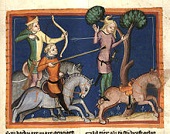
-1015 After his handsome favorite 3rd son (by Maachah) Absalom (Heb. "father of peace") kills his half-brother Amnon to avenge the rape of his sister Tamar (Heb. "palm tree") (2 Sam. 13:1-33) (not the daughter-in-law of Jacob's son Judah, who marries Er, Onan, and Judah, tricking the latter into hooking up with her, producing twins Perez and Zerah, see Gen. 38:6-30), is pardoned by David, then "stole the hearts of the men of Israel" and rebels, and is kicking butt until he gets his long flowing hair caught in the branches of an oak tree, hanging there helplessly until David's man Joab finish him off, causing David to utter the immortal soundbyte: "O Absalom, Absalom, my son Absalom" (2 Sam. chaps. 3, 13-19, 18:33), kinnor-playing king David (b. -1085) dies after giving a memorable address to the people (1 Chron. ch. 29), with the soundbytes "Thine, O Lord, is the greatness, and the power, and the glory, and the victory, and the majesty; for all that is in the heavens and in the Earth is thine; thine is the kingdom, O Lord, and thou art exalted as head above all" (1 Chron. 29:22-23) and "For we are strangers before thee, and sojourners, as all our fathers were; our days on the Earth are like a shadow, and there is none abiding" (1 Chron. 29:15); too bad, there now comes a 45-year gap between Bishop Ussher's chronology and everybody else's, so David's son Solomon has to go through the 1000 B.C.E. Glass Darkly and come out the other side to become king? Deaths: Israeli king #2 David (b. -1085).


-1012 On May 9 a solar eclipse is observed in the Egyptian city of Ugarit during the reign of Amenhotep IV, shifting all of Egyptian chronology forward by 300 years, according to the New Chronology of English Egyptologist David Michael Rohl (1950-). Akastos dies, and Archippos (d. -993) becomes king of Athens. Alt. date for the end of King Saul's rule (Eerdman's Dict. of the Bible). Solomon begins the construction of the Temple of Solomon, AKA the Temple of Jerusalem (1 Ki. 6:1), with the help of king Hiram I of Tyre, who furnishes Solomon's ships with chains of brass; the head workman is allegedly Hiram Abiff (son of a widow of the tribe of Naphtali), in charge of 3.3K grand overseers and 150K workmen, who is murdered by three ruffians who try to get the secret Master Mason password out of him, as later claimed by the Freemasons, who stage an allegorical play about him in their Third Degree (Master Mason) rites - the prototype of McDonald's cow meat restaurants of the 20th cent. C.E.?
-1010 Assur-Rabi II (d. -973) becomes king of Assyria.
-1007 Simbar-Shipak dies, and Ea-Mukin-Zeri becomes king of Babylon for 5 mo. then dies, and Kashu-Nadi-Ahhe (d. -1004) becomes king of Babylon.
-1006 Cheng dies, and next year his son Kang of Zhou (d. -978) becomes Zhou king #3 of China.
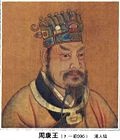
-1005 Samson dies in a blaze of glory, taking mucho Philistines with him; he is succeeded by Eli (Heb. "Jehovah is the Most High") as judge #14 of Israel, becoming the trainer of young Samuel.
-1004 Kashu-Nadin-Ahhe dies, and the Aramean Eulma-Shakin-Shumi (d. -987) becomes king of Babylon, founding the 6th (Bazi) Dynasty.
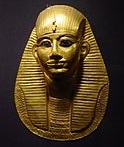
-1001 Psusennes I dies, and his son (by Mutnedjmet) Usermaatre Amenemope (Amunemope) (Amenophthis) (d. -992) becomes king #4 of the Egyptian 21st Dynasty, claiming the title of high priest of Amun in Tanis; the Onomasticon of Amenope, an inventory of Egyptian property survives to modern times.